The living forest
PLANTS GALLERY
The diversity of plant life in this forest is quite exceptional. We have identified more than 200 species, ranging from the tall trees which are perhaps 80 years old or more, to tiny, ephemeral orchids and herbs.
Scroll down for a pictorial tour.
All images were taken by us, on site, over the last few years.
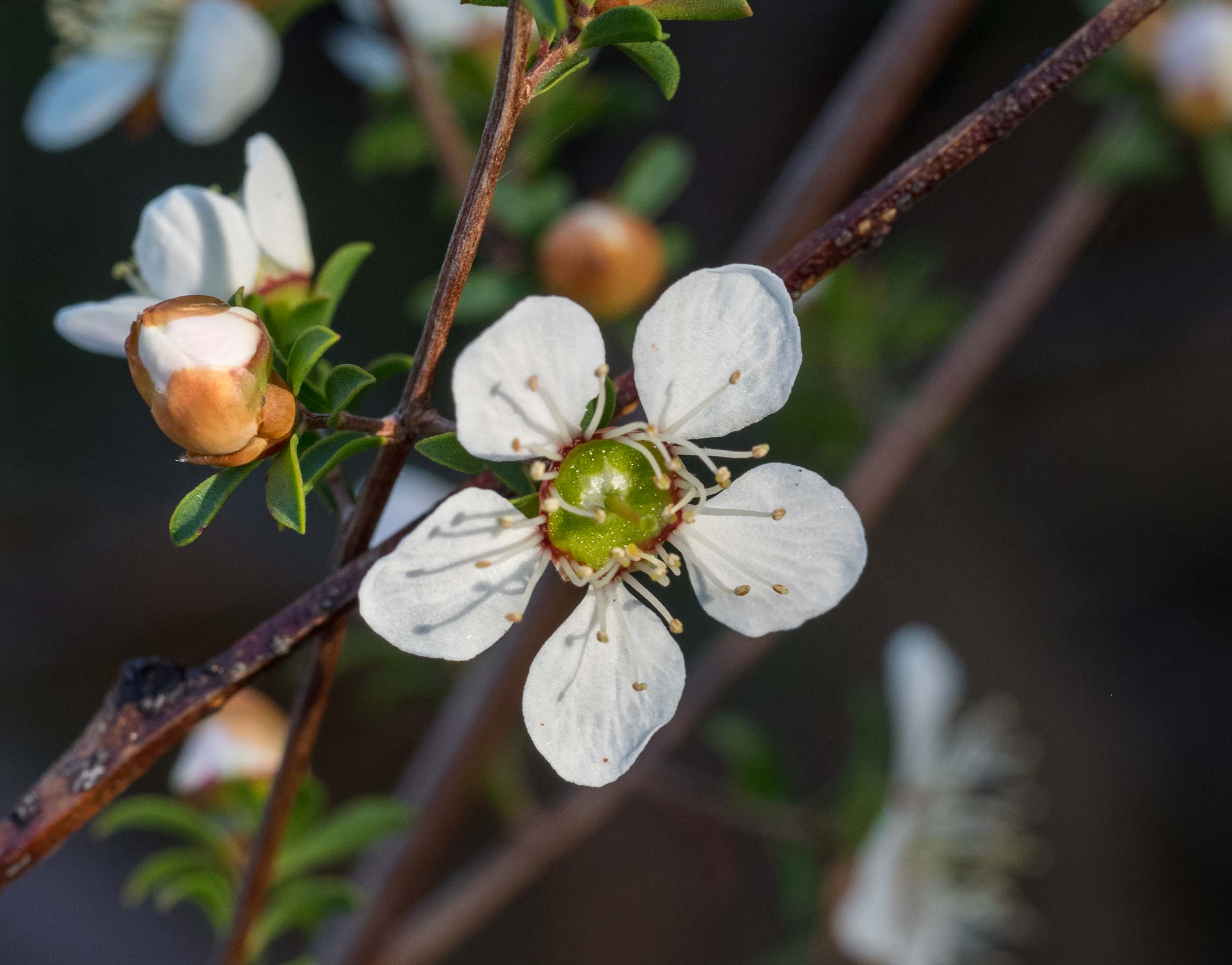
Woolly Tea-tree
Leptospermum lanigerum
This tea-tree blooms in September - one of the earliest of the Leptospermum species to come into flower. Tea-trees are a magnet for insects, many of which depend on the nectar and pollen they provide. In turn this species depends on insects for pollination as each flower is either only male or female.
Family: Myrtaceae (eucalypts, tea-trees)
Photo taken in September
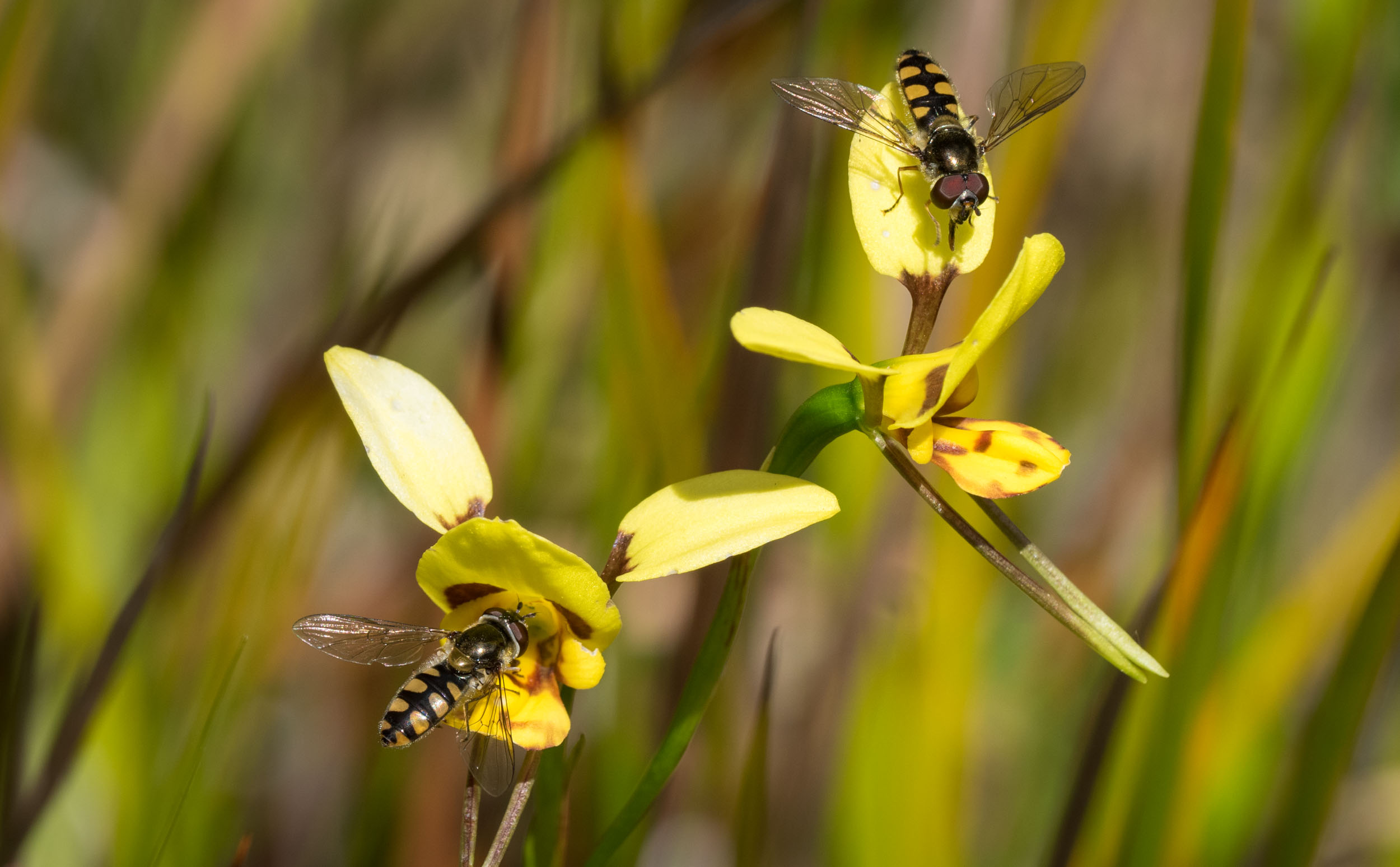
Tiger Orchid
Diuris sulphurea
The Tiger Orchid blooms in October-November and we typically see over a dozen flowering stems, each with several flowers, on the block. These are visited by Common Hover Flies.
Family: Orchidaceae (orchids)
Photo taken in October
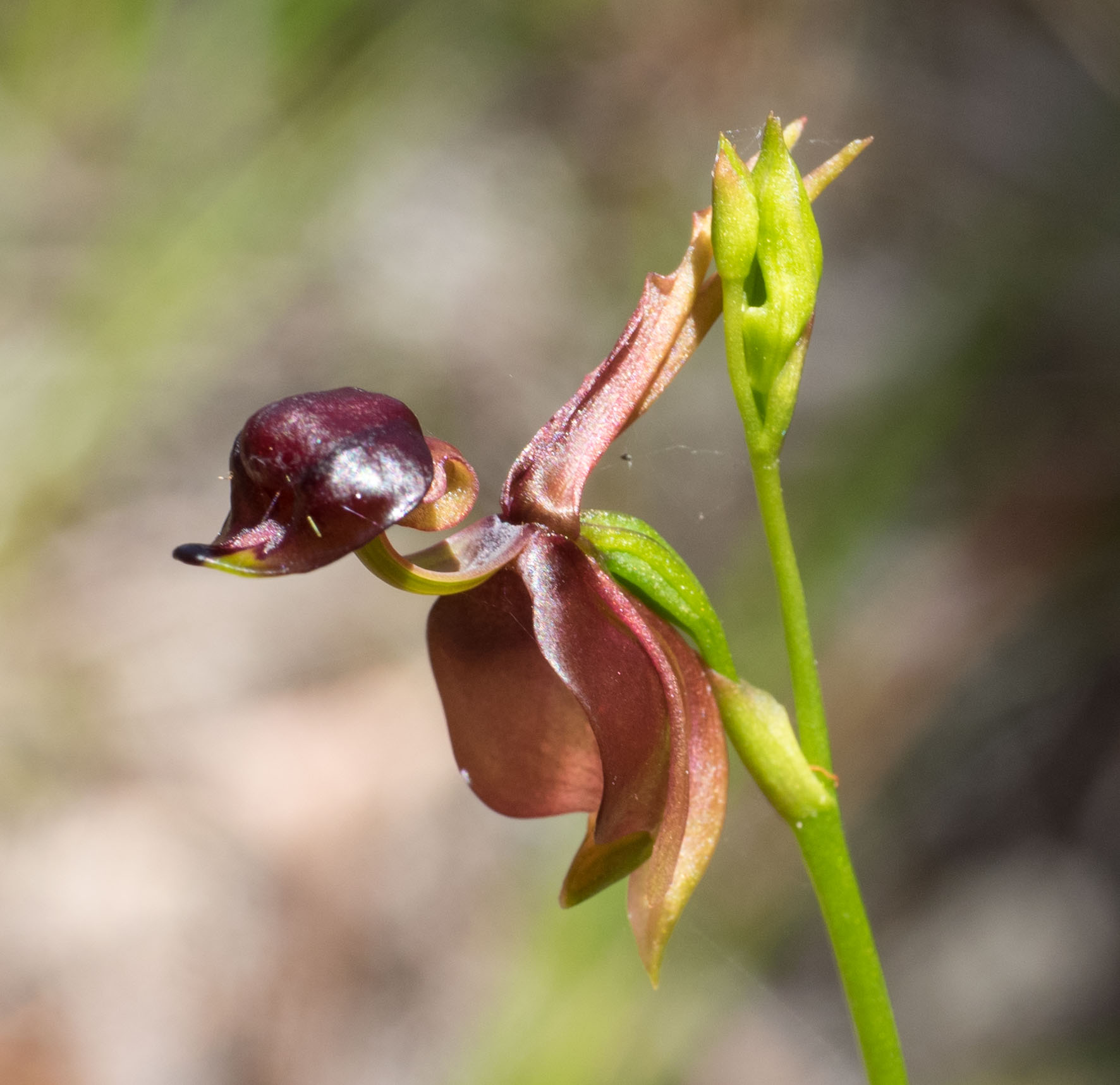
Flying Duck Orchid
Caleana major
We have seen just a few examples of this bizarre orchid on our block. It really does resemble its namesake! It flowers in October-November and each stalk has a couple of flowers.
Family: Orchidaceae (orchids)
Photo taken in December

Hairpin Banksia
Banksia spinulosa
This is one of two Banksia species on the block. It is typically a low shrub, about 1m high. The flowers are pollinated by several species of bees, ants and moths and we regularly see the Eastern Spinebill feeding on the nectar - as shown here. However the most effective pollinators are reputed to be mammals, including at least three species that occur on the block - Eastern Pygmy Possum, Agile Antechinus and Sugar Glider.
Family: Proteaceae (proteas, banksias, grevilleas)
Photo taken in April
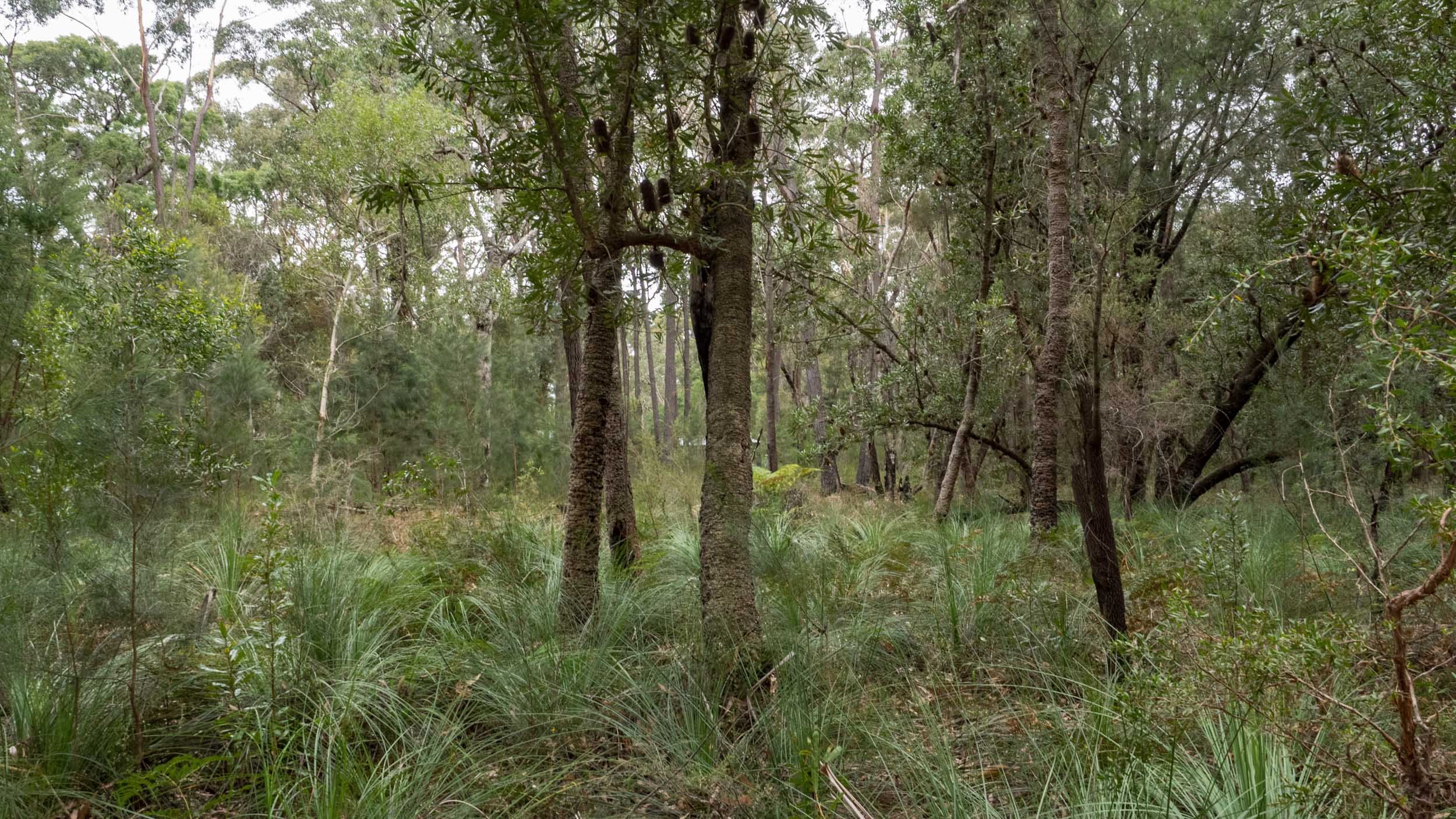
Saw Banksia
Banksia serrata
The wet gullies on the block are dominated by stands of Banksia serrata trees - some of which are over 15m tall. This species can live for up to 100 years. The trees in the foreground of this image are Banksia serrata. A number of old flower spikes - commonly, but technically incorrectly called 'cones' - can be seen in these.
Family: Proteaceae (proteas, banksias, grevilleas)
Photo taken in December
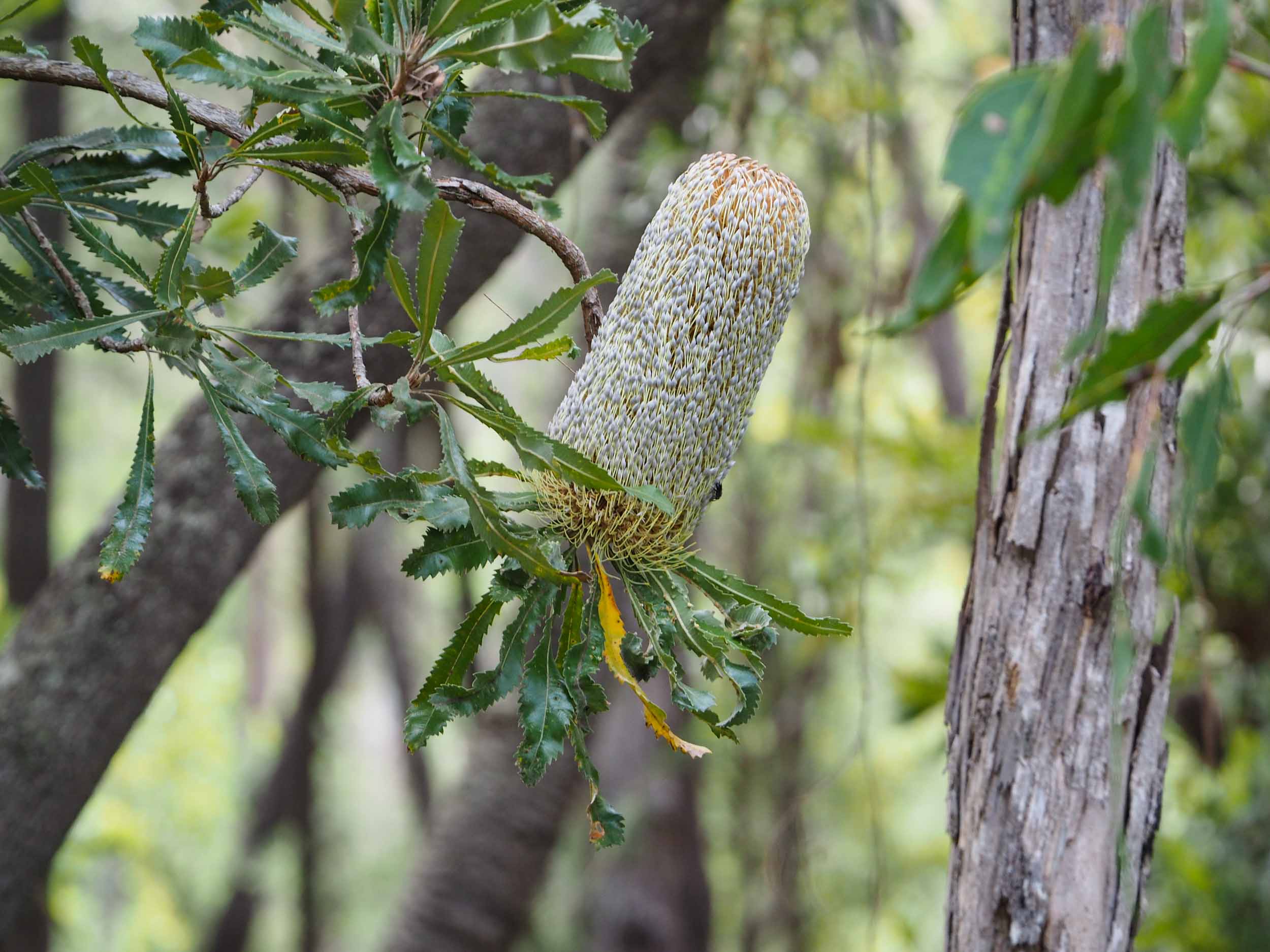
Saw Banksia
Banksia serrata
The large, creamy grey flowers of this species are seen from November to April. Rainbow Lorikeets and Common Ringtail and Brushtail Possums feed on the blossom. The plant is also host to larvae of the Banksia Longicorn Beetle (Paroplites australis). We look forward to adding this species to the list of four longicorns we have already seen on the block.
Family: Proteaceae (proteas, banksias, grevilleas)
Photo taken in December
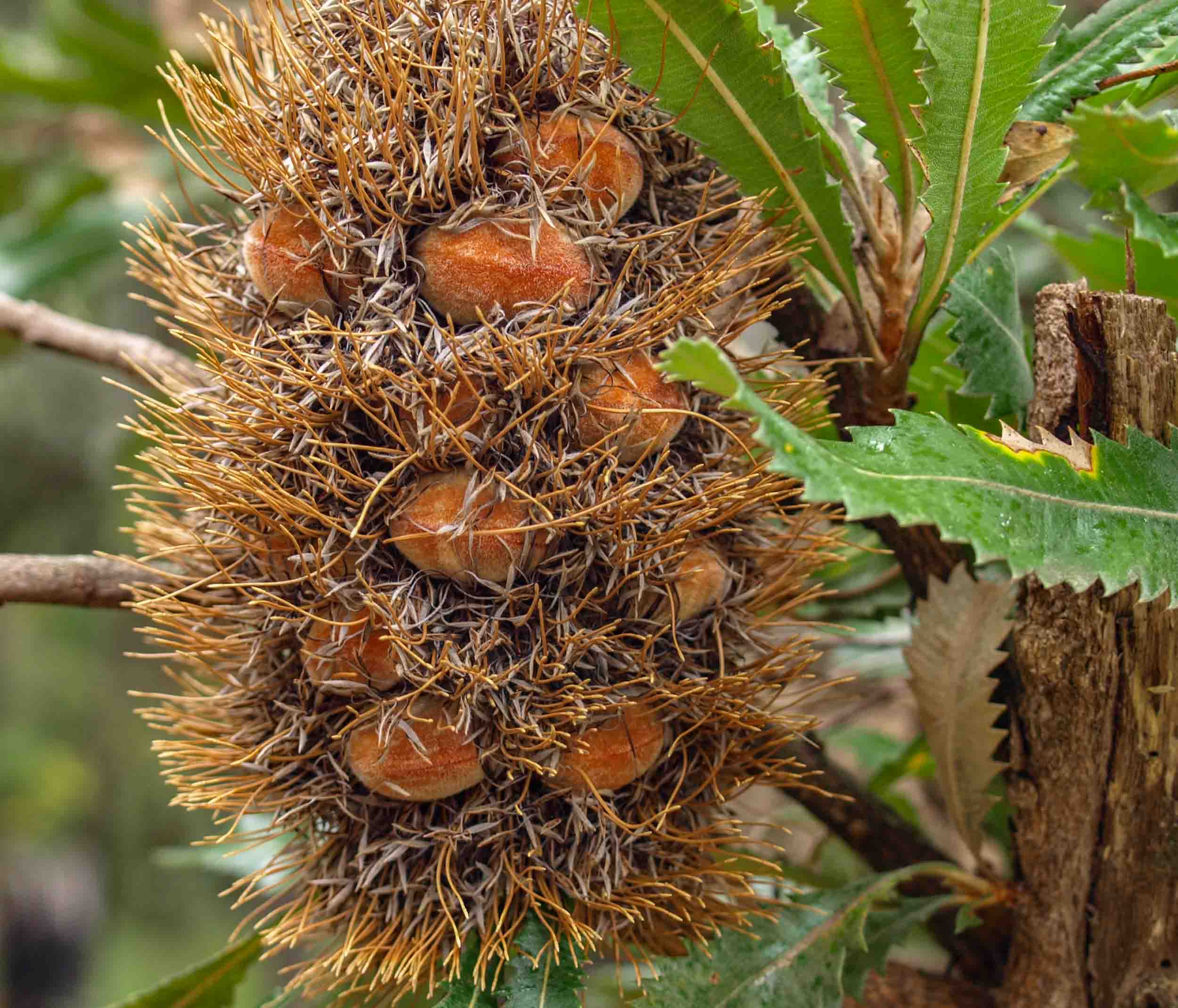
Saw Banksia
Banksia serrata
An old flower spike or 'cone' of this Banksia. These were the inspiration for May Gibbs's "Big Bad Banksia Men". The forest floor under these trees is sometimes littered with old spikes that have been torn apart by Yellow-tailed Black Cockatoos as they extract the seeds. This image also shows the leaves whose shape gives the species its name.
Family: Proteaceae (proteas, banksias, grevilleas)
Photo taken in August
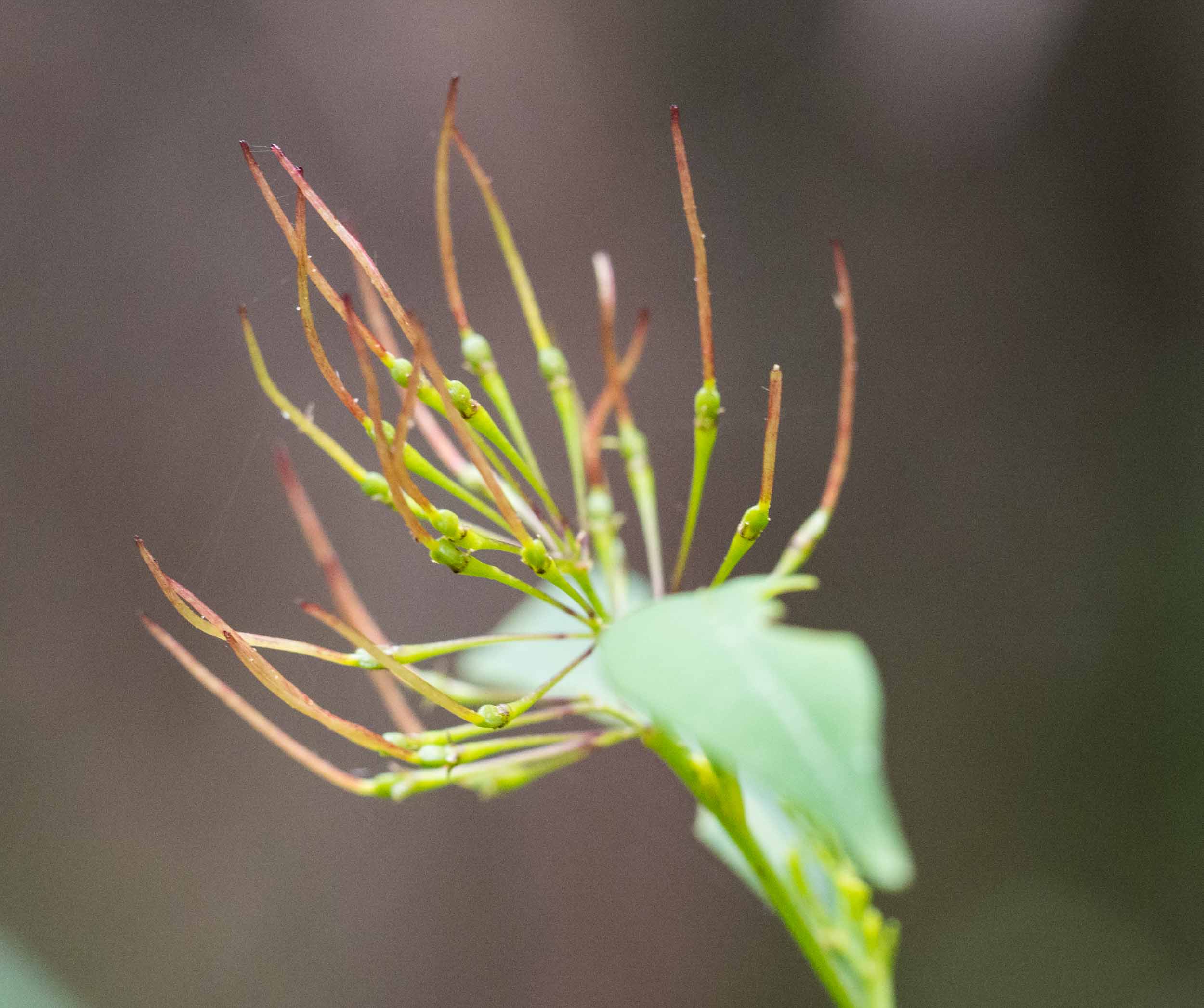
Large-leaf Hop Bush
Dodonea triquetra
Female flowers of Dodonea triquetra, Large-leaf Hop Bush. Male and female flowers are found on separate plants and lack petals.
Family: Sapindaceae (Soapberry family)
Photo taken in January
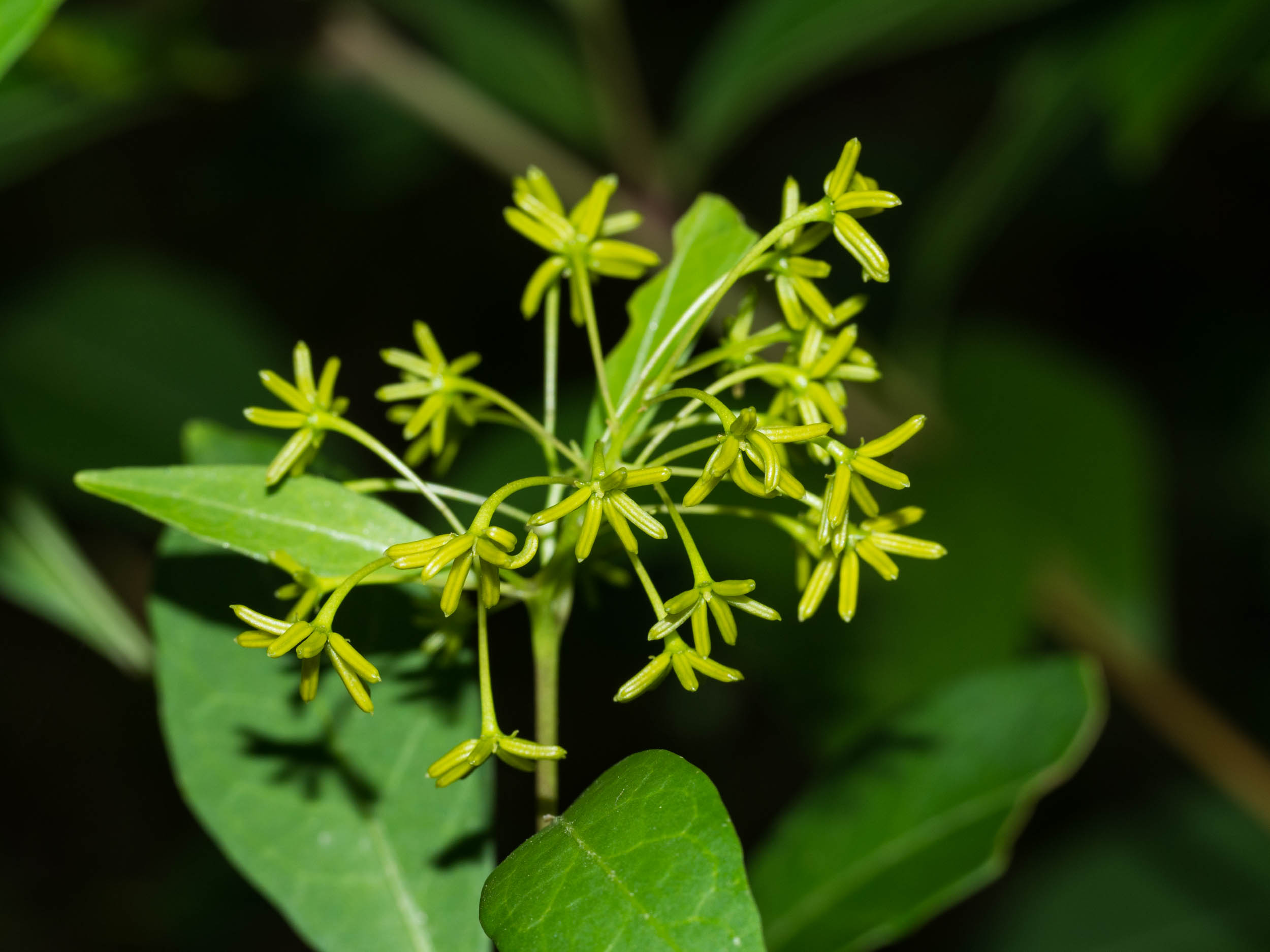
Large-leaf Hop Bush
Dodonea triquetra
Male flowers of this species, which grow on a different plant to female flowers.
Family: Sapindaceae (Soapberry family)
Photo taken in January
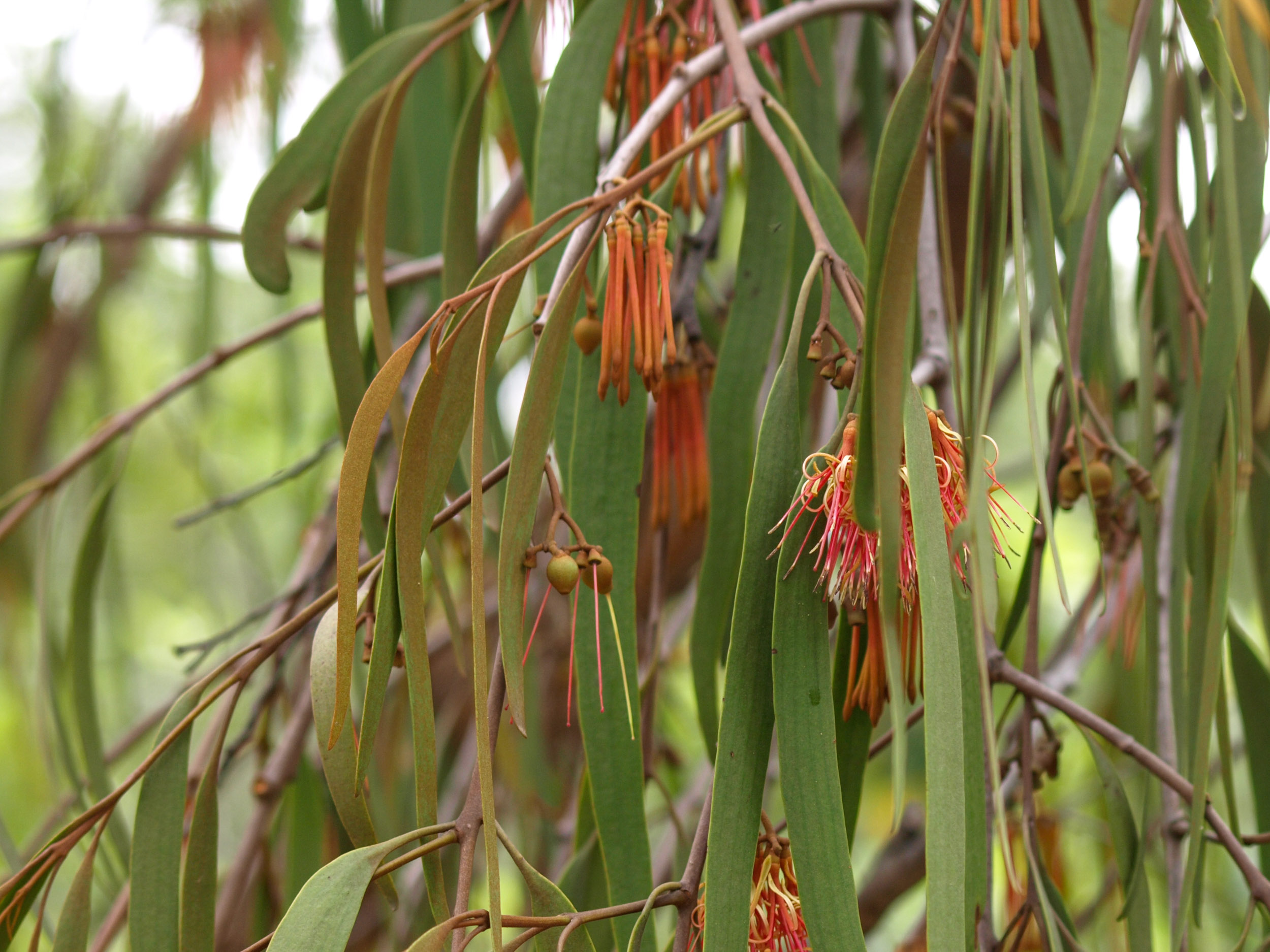
Drooping Mistletoe
Amyema pendula
Many of the eucalypts on our block are parasitised by this species. Note that the Amyema leaves resemble eucalypt leaves. Mistletoes commonly evolve leaves to resemble their host. For example, mistletoes that parasitise casuarinas have needle-shaped leaves.
Family: Loranthaceae (mistletoe)
Photo taken in August
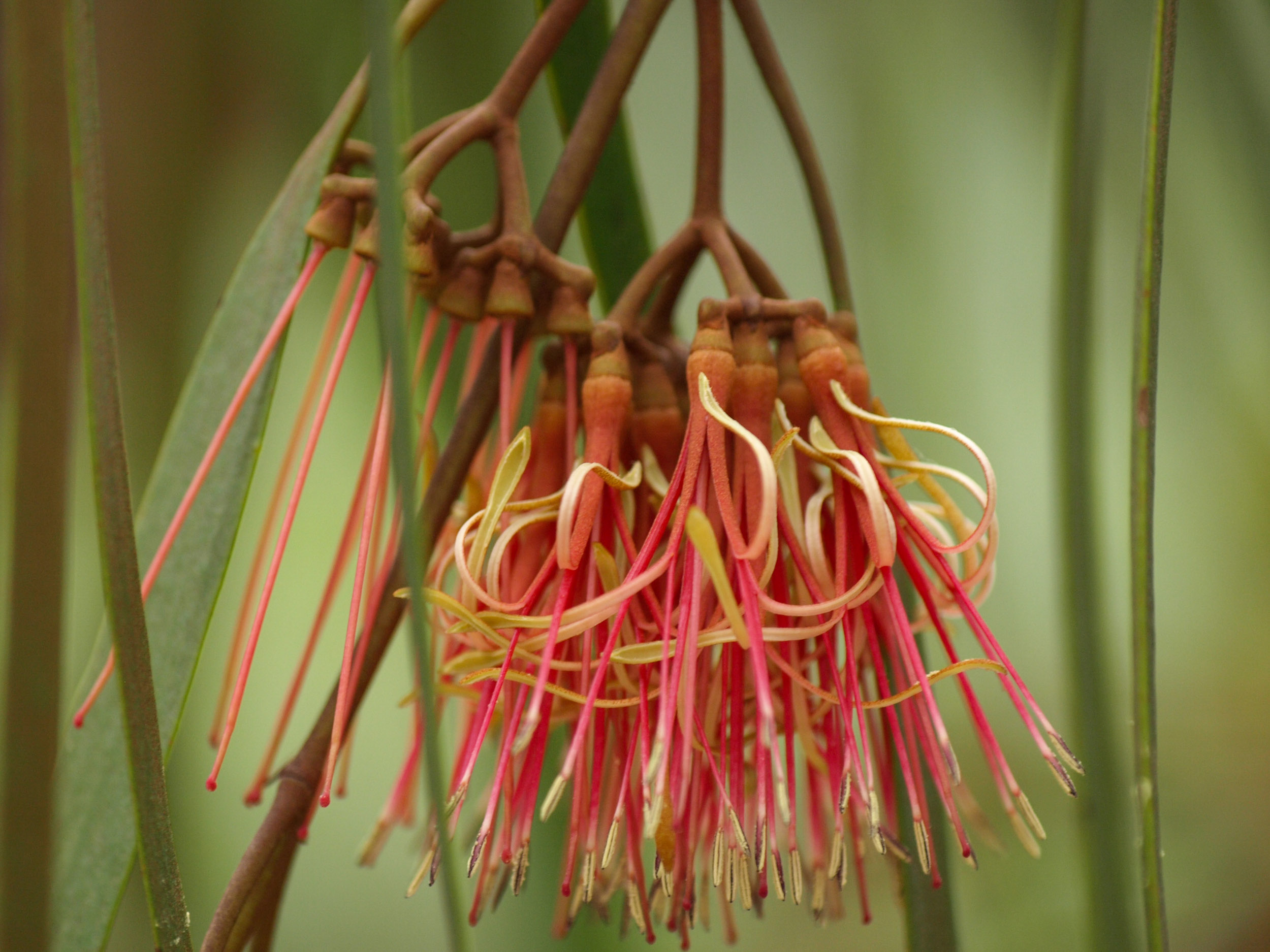
Drooping Mistletoe
Amyema pendula
This species comes into bloom in mid Winter. The flowers provide a valuable source of nectar for several of the honeyeaters at a time of the year when few other plants are flowering - particularly in the canopy.
Family: Loranthaceae (mistletoe)
Photo taken in August
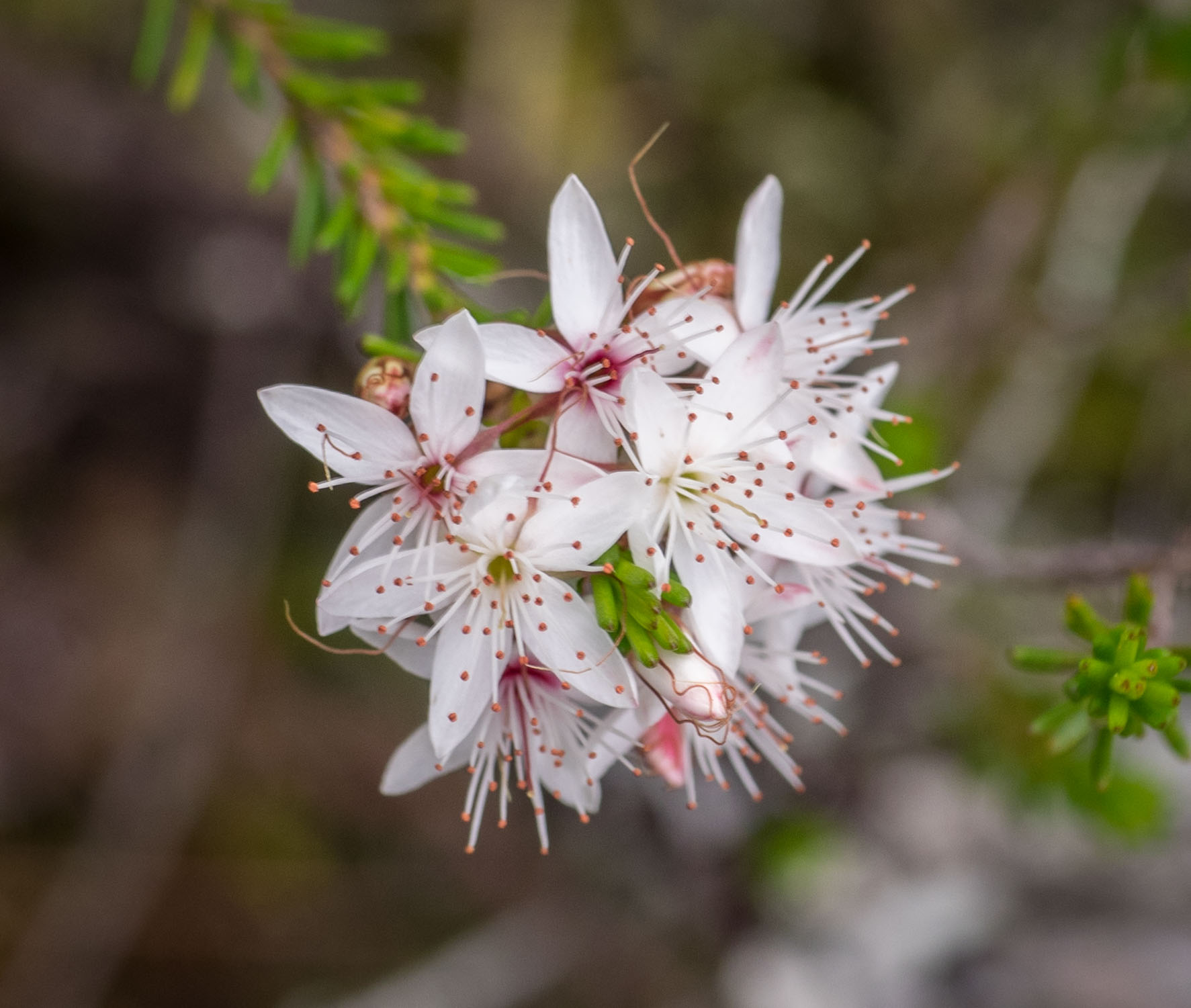
Common Fringe-myrtle
Calytrix tetragona
This plant flowers in late Spring. Several low shrubs grow at the base of a cliff, fronting the river.
Family: Myrtaceae (eucalypts, tea-trees)
Photo taken in September

Hairy Pink-bells
Tetratheca pilosa
This low growing forb is widespread on the block. The attractive pink flowers appear in late Winter.
Family: Elaeocarpaceae
Photo taken in September

Guinea Flower
Hibbertia fasciculata
This is one of four Hibbertia species found on the block. It is a low growing forb, which flowers in late Winter through to late Spring.
Family: Dilleniaceae
Photo taken in September
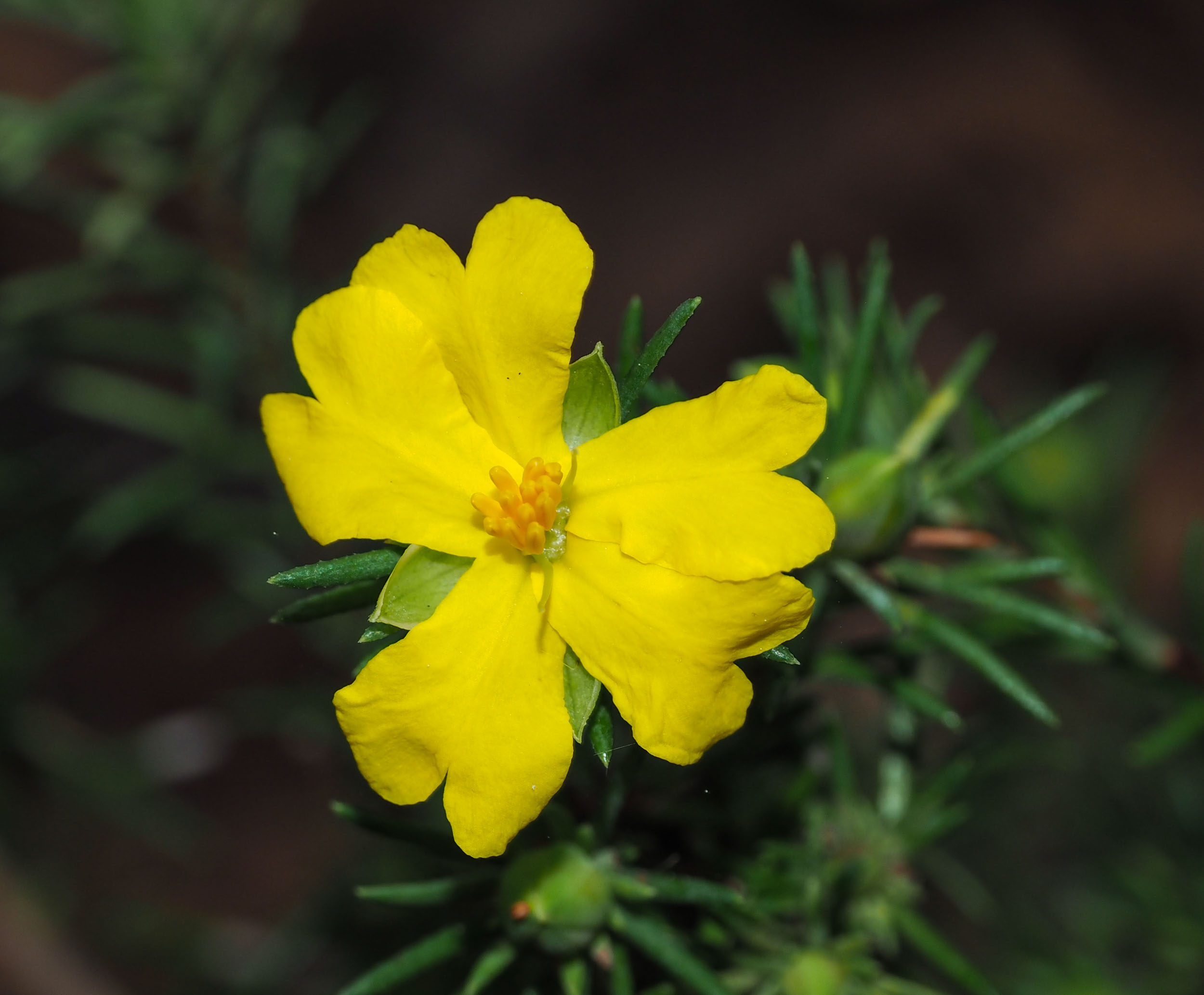
Guinea Flower
Hibbertia fasciculata
A close up view of the flower of this species.
Family: Dilleniaceae
Photo taken in September
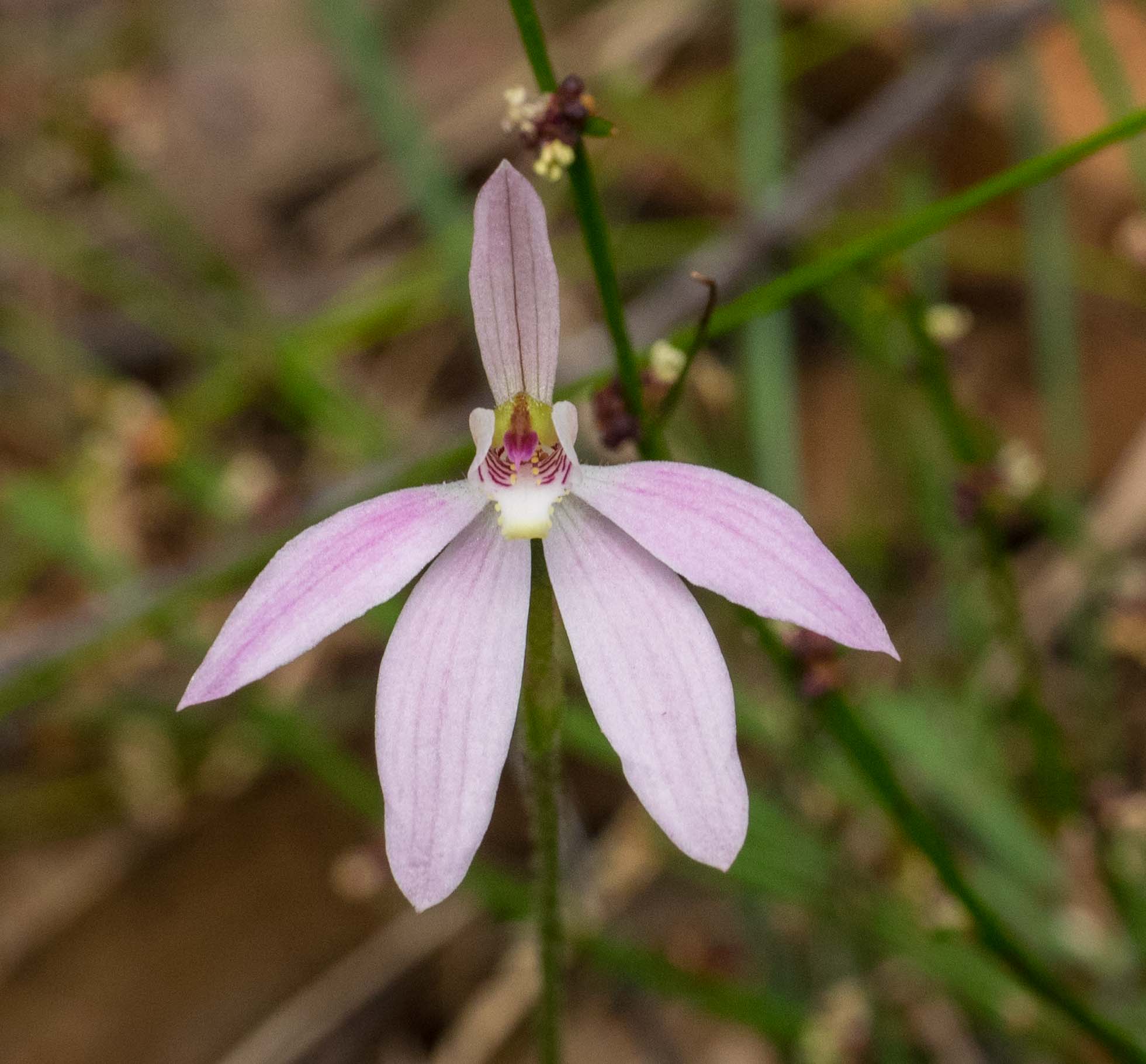
Pink Fingers Orchid
Caladenia carnea
This attractive orchid flowers in late September. The flowers are about 2cm across and vary in colour from white to bright pink.
Family: Orchidaceae (orchids)
Photo taken in September
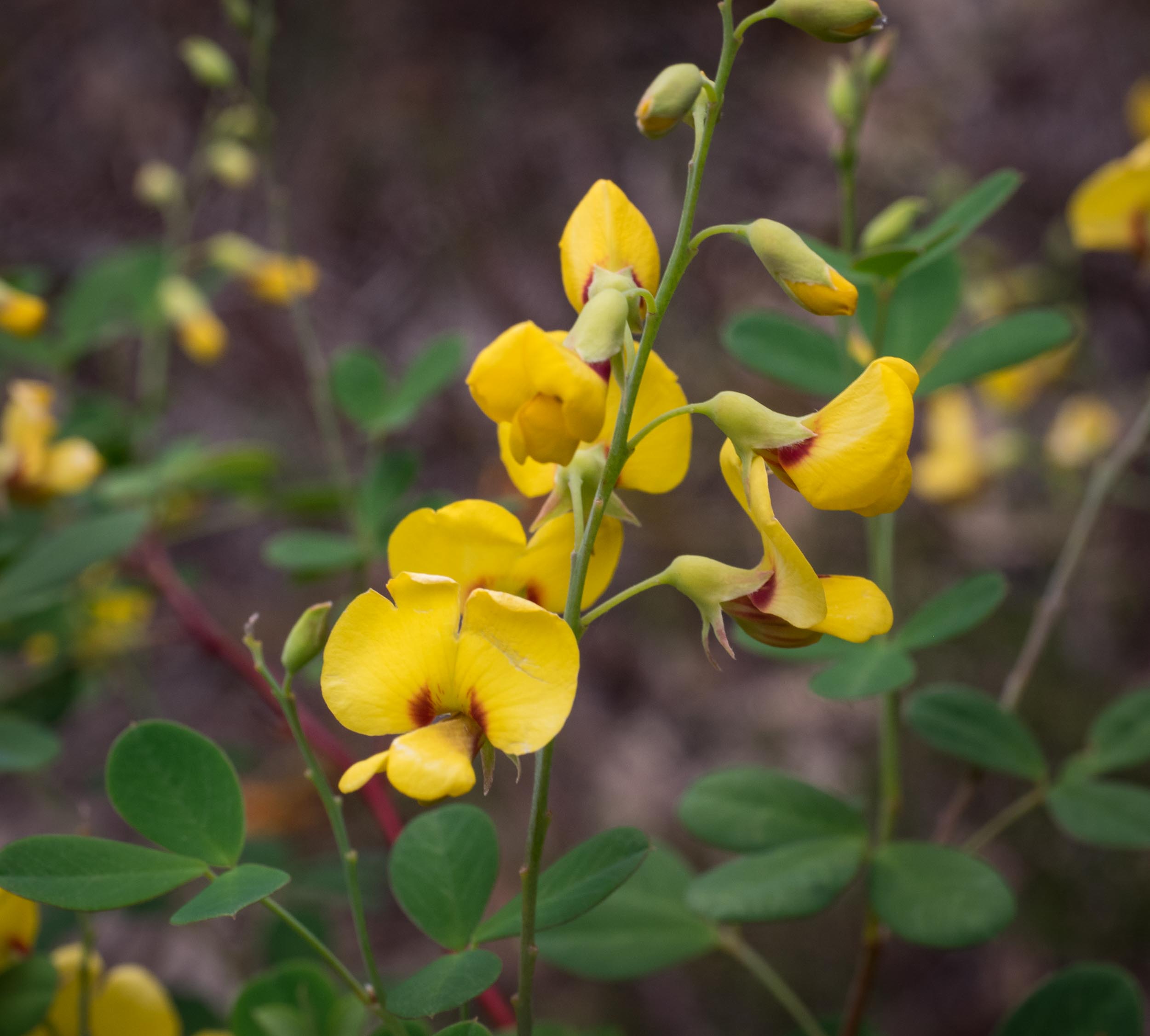
Golden Tip, Clover Tree
Goodia lotifolia
This is one of 21 species on the block that belong to the family Fabaceae, subfamily Faboideae (legumes). It has the typical flower shape of the legume family, but the leaves have an unusual 3-foliolate arrangement. It flowers in late Winter-early Spring.
This is a diagnostic species for our type of forest - Lowland Gully Shrub Forest.
Family: Fabaceae Subfamily: Faboideae
Photo taken in September
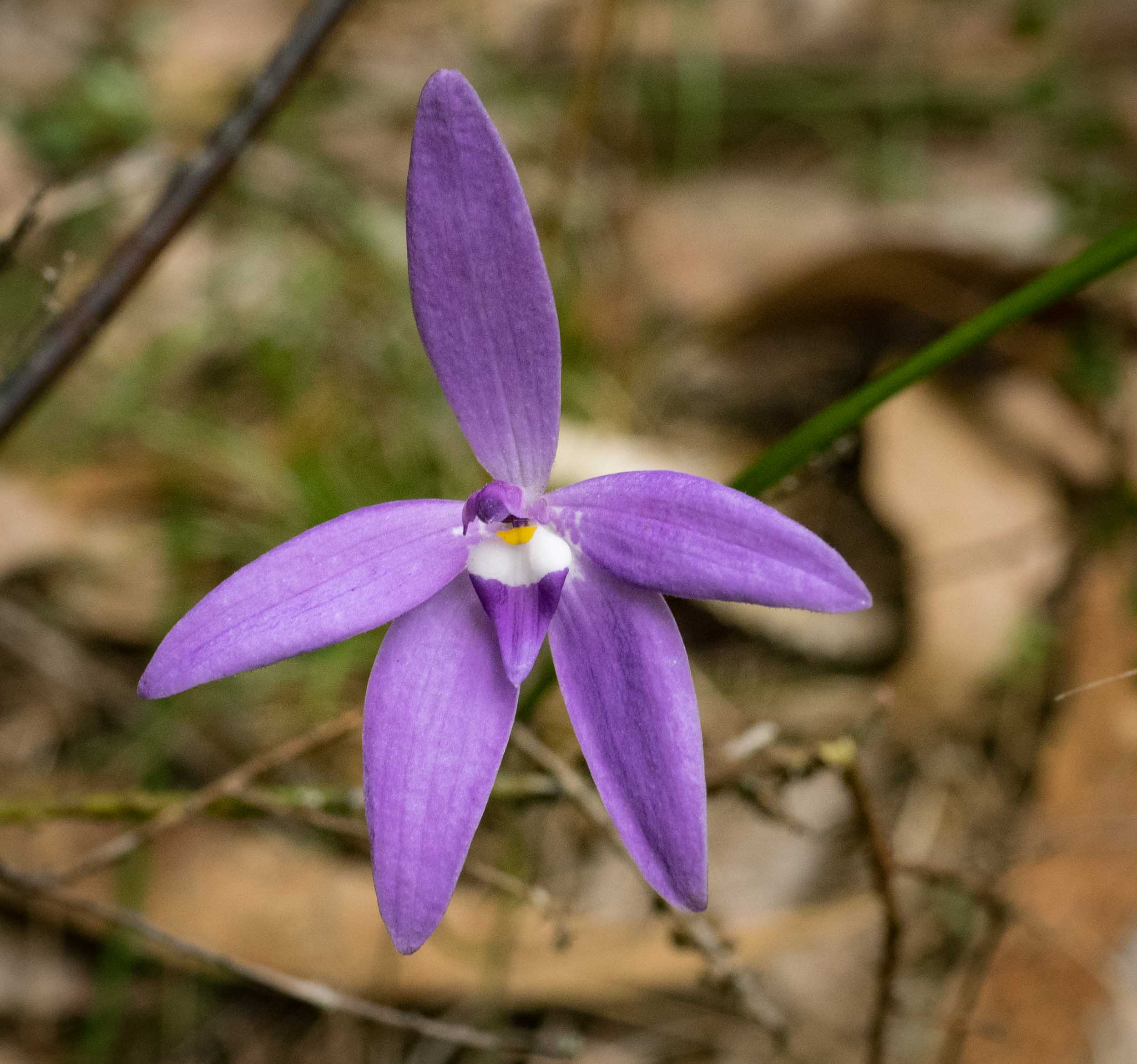
Wax-lip Orchid
Glossodia major
This is one of several orchids that flower on the block in September-October.
Family: Orchidaceae (orchids)
Photo taken in September
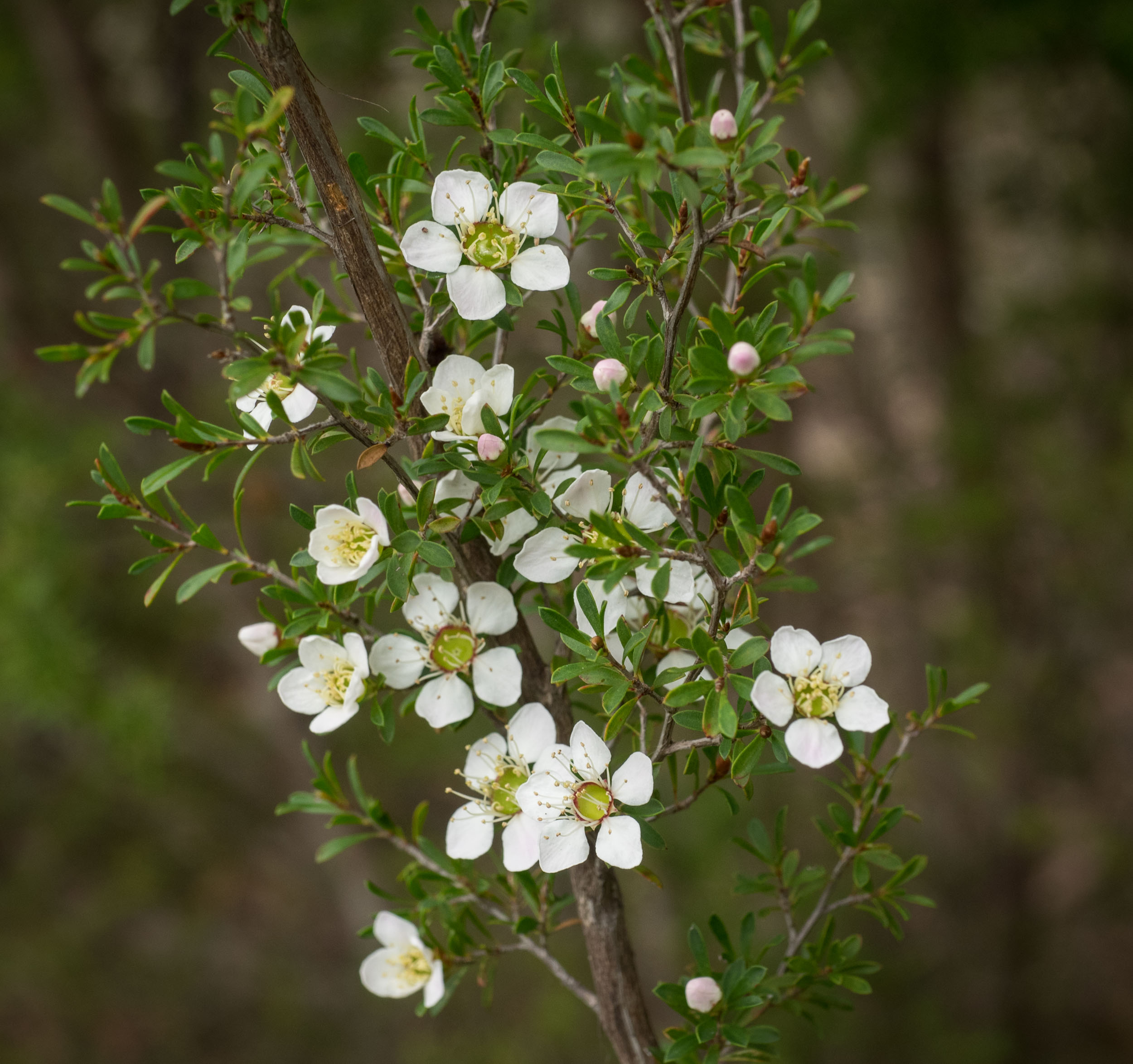
Burgan
Kunzea ericoides
Burgan or Känuka, as it is also called, is a medium sized bush, which flowers profusely in November-December. It is quite a fragrant bush when in bloom.
Family: Myrtaceae (eucalypts, tea-trees)
Photo taken in September
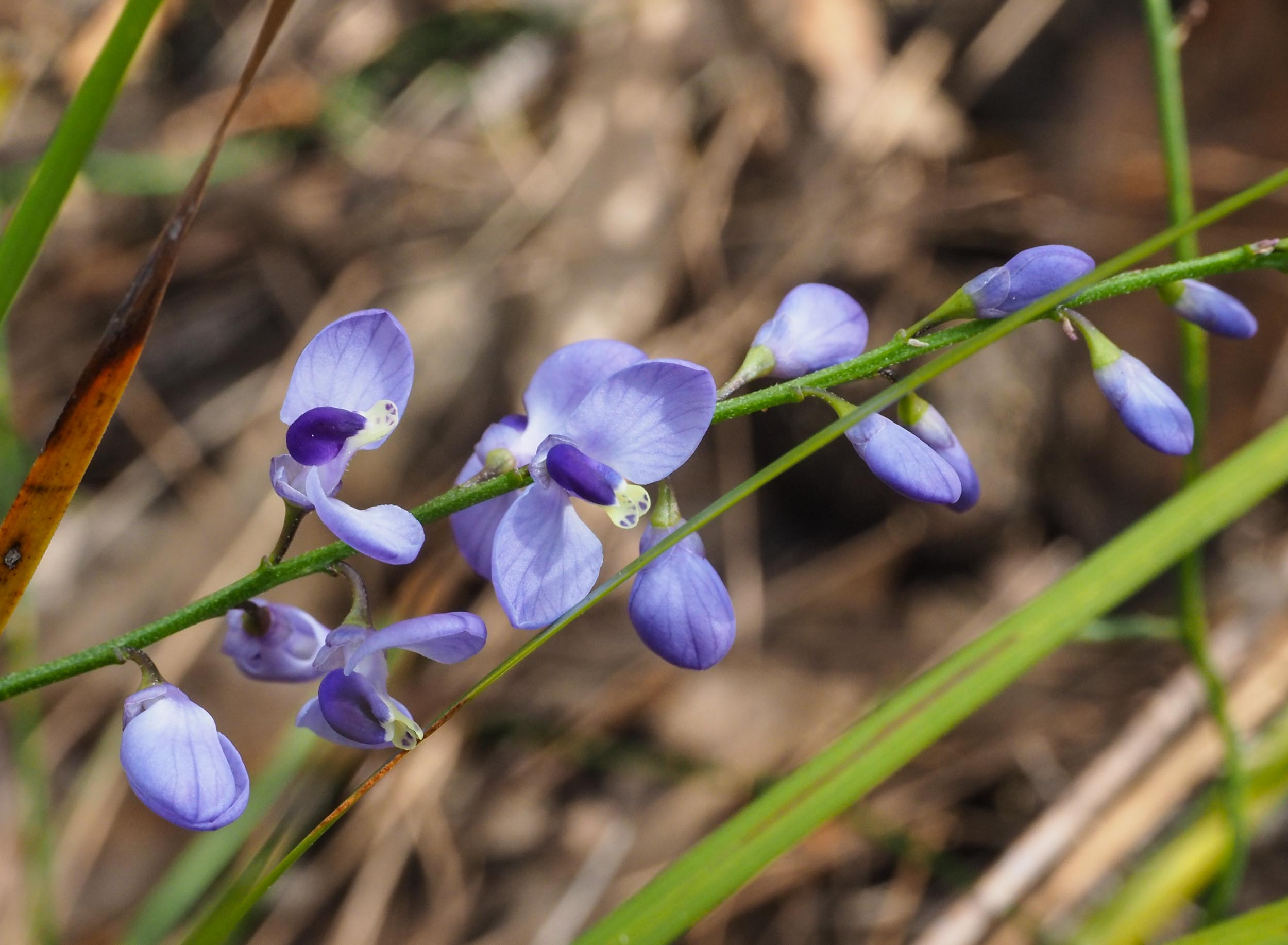
Love Creeper
Comesperma volubile
This plant grows as a low, twining vine. Its purple flowers make an attractive show throughout Spring - appropriately named!
Family: Polygalaceae (milkworts)
Photo taken in September
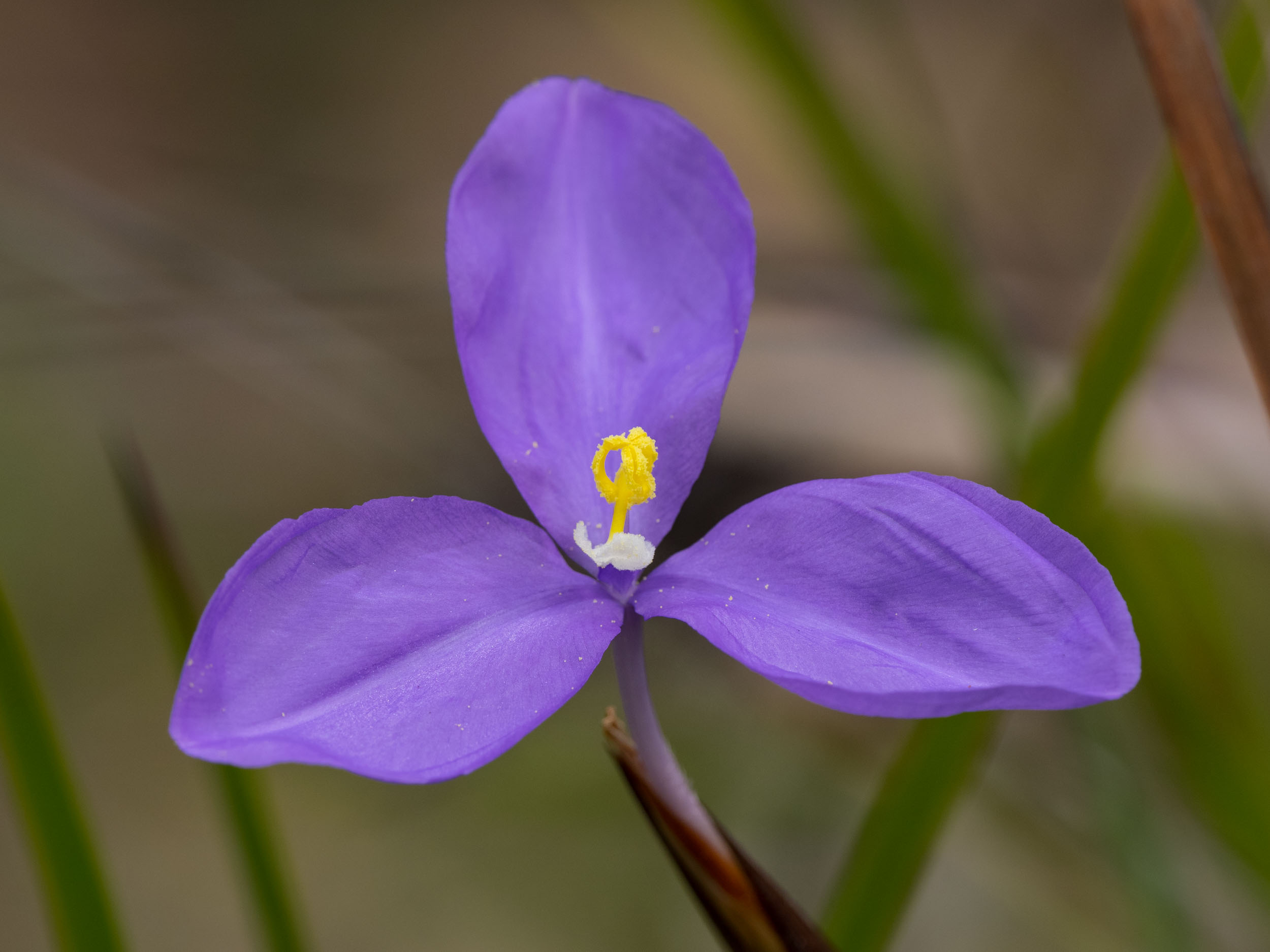
Long Purple Flag
Patersonia occidentalis
Large numbers of these purple flowers appear in clusters on the block in late September. The plant has a long, unbranched flowering stem, which bears several flowers. The flowers appear in the morning on sunny days and each lives for only a single day. We lie at the northern limit of this particular Patersonia species.
Family: Iridaceae (irises)
Photo taken in October
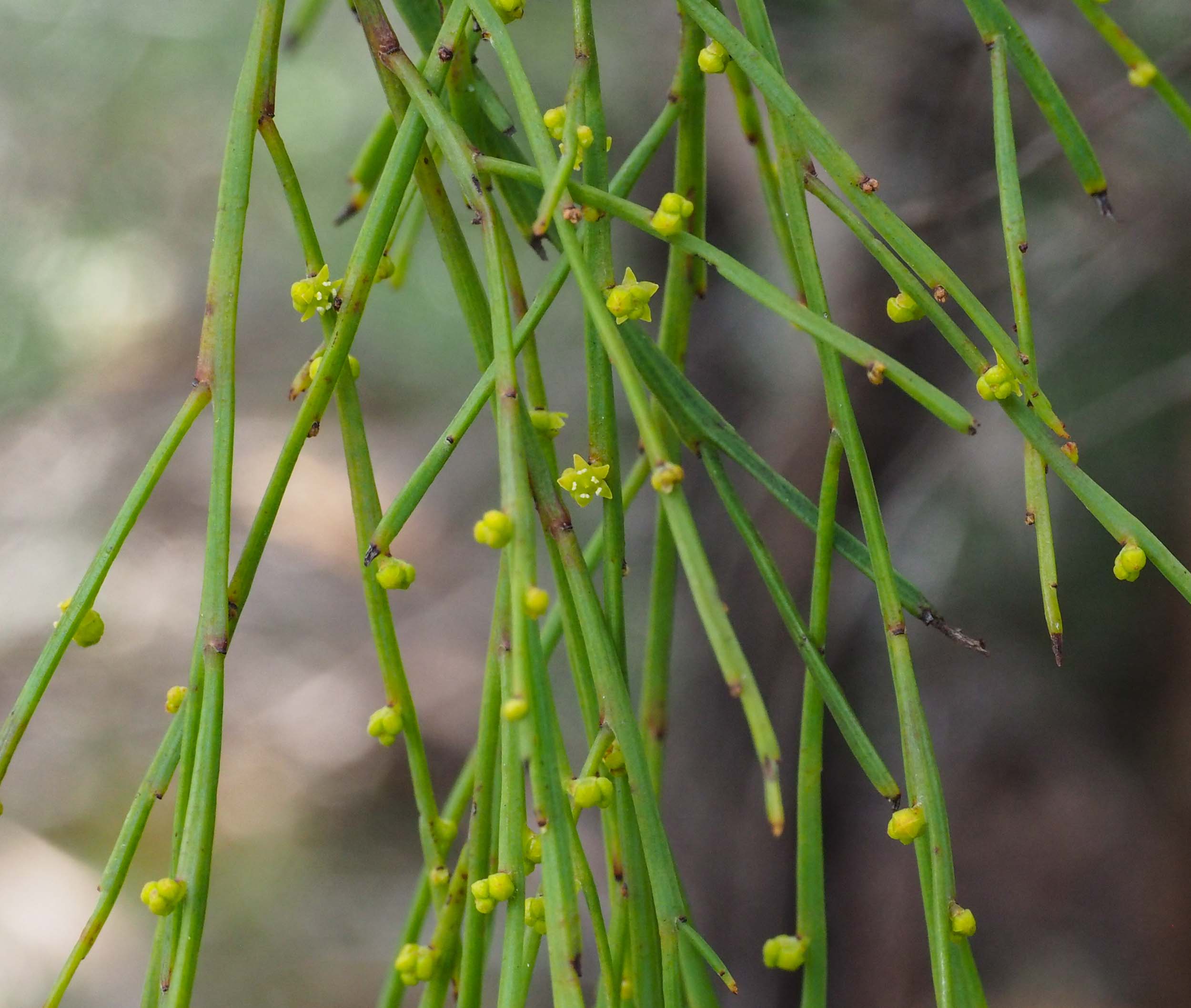
Leafless Sour-bush
Omphacomeria acerba
This is a hemiparasite, which taps into the roots of a neighbouring plant to extract nutrients. Its leaves are reduced to small scales, which are shed soon after they form. Its flowers are tiny and male and female flowers form on different plants. It develops a succulent fruit, which although small, is quite tasty.
Family: Santalaceae (mistletoes)
Photo taken in August
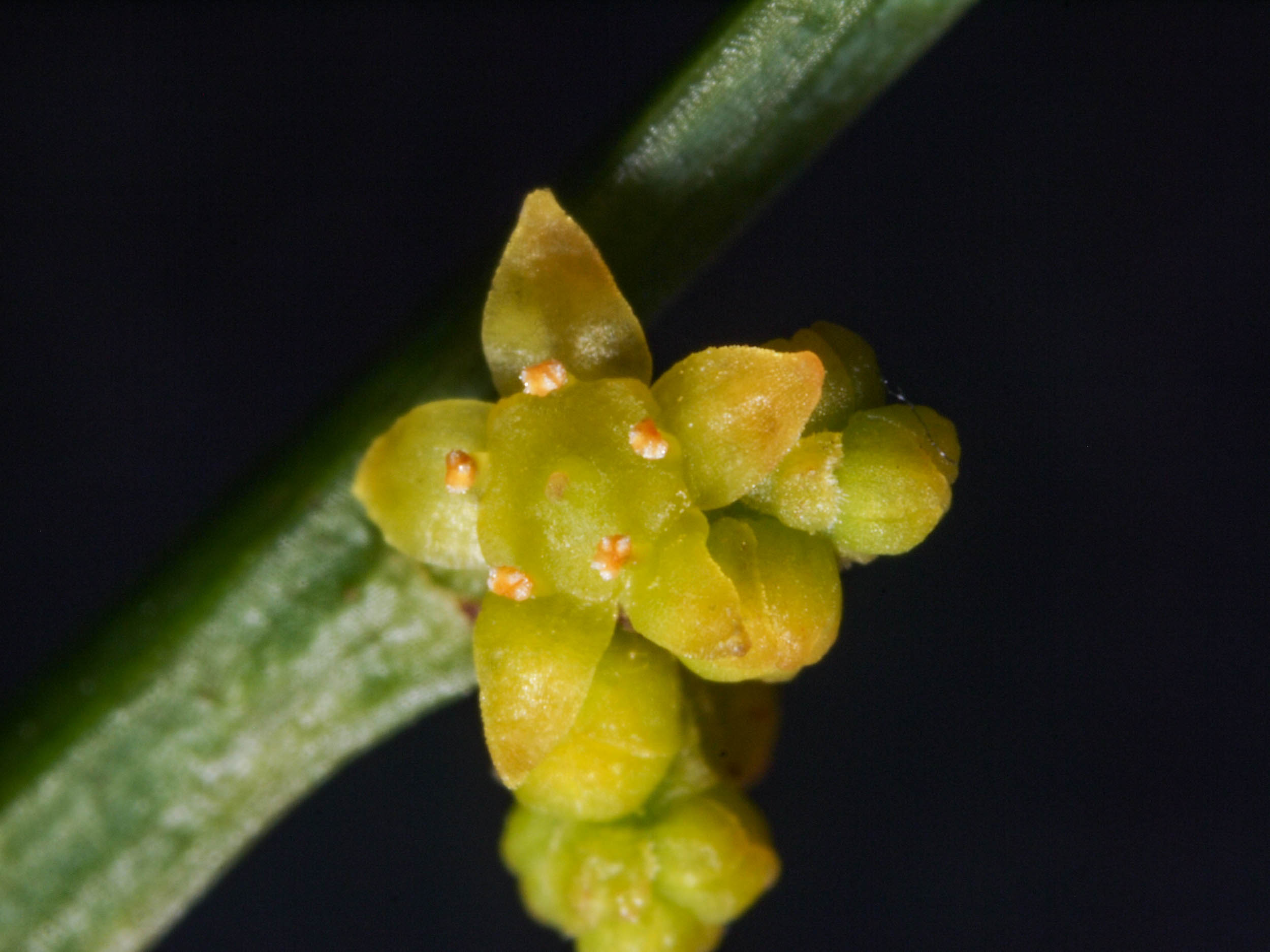
Leafless Sour-bush
Omphacomeria acerba
A close up of a male flower of this unusual plant.
Family: Santalaceae (mistletoes)
Photo taken in August
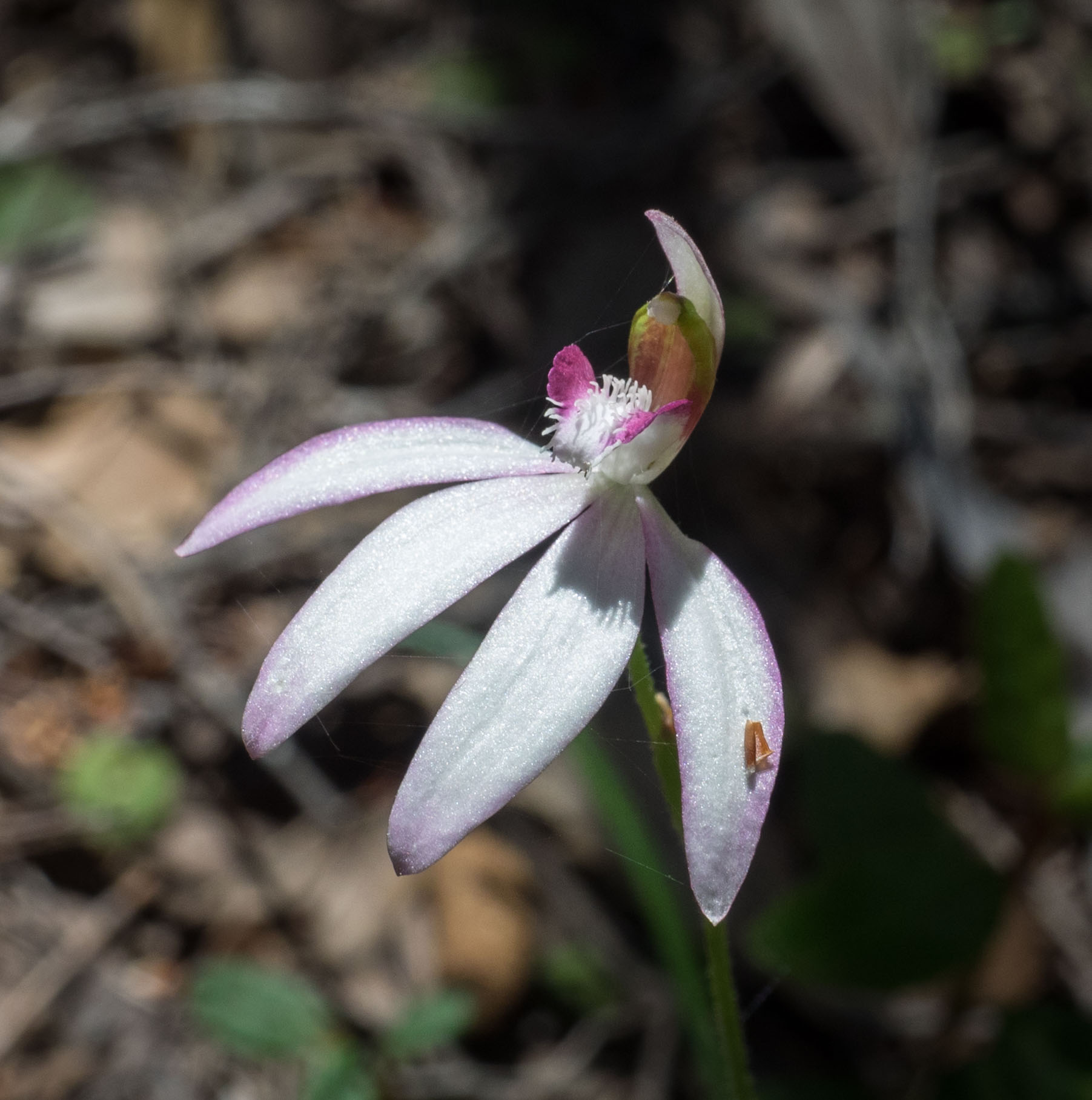
White Fingers Orchid
Caladenia catenata
This orchid closely resembles the related species C. carnea, but it starts flowering earlier, in late Winter. Like C. carnea, the flowers persist for some weeks.
Family: Orchidaceae (orchids)
Photo taken in October

Slender Rice-flower
Pimelea linifolia
A widespread, low-growing shrub on the block. It flowers through most of the year, peaking in August to October. It is pollinated by a wide range of insects, including moths, butterflies, flies and native bees.
Family: Thymelaeaceae (rice flowers)
Photo taken in August

Broom Spurge
Amperea xiphoclada
This low shrub grows in clumps up to 60cm tall. It has a simple form - the straight stems branch only once, the leaves are very small and the flowers even smaller. Male and female flowers are found on separate plants. Male flowers are shown in this image. Amperea flowers through most of the year, with a peak in Spring to Summer.
Family: Euphorbiaceae (spurges)
Photo taken in September
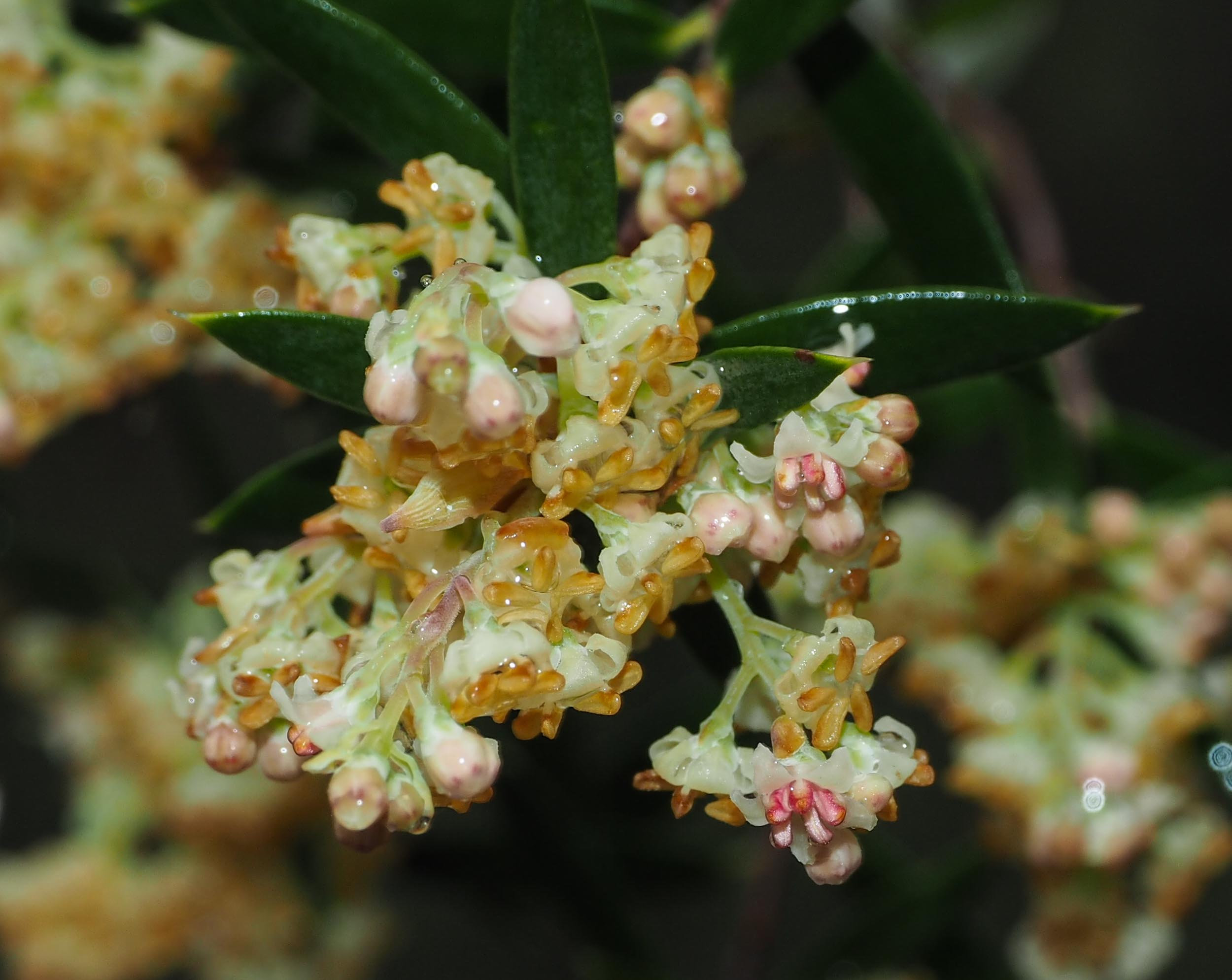
Tree Broom-heath
Monotoca elliptica
This plant grows as a large shrub or small tree with a stout, rough-barked trunk. In early Spring it produces masses of small, white flowers, which attract large numbers of bees.
Family: Ericaceae (heaths)
Photo taken in August
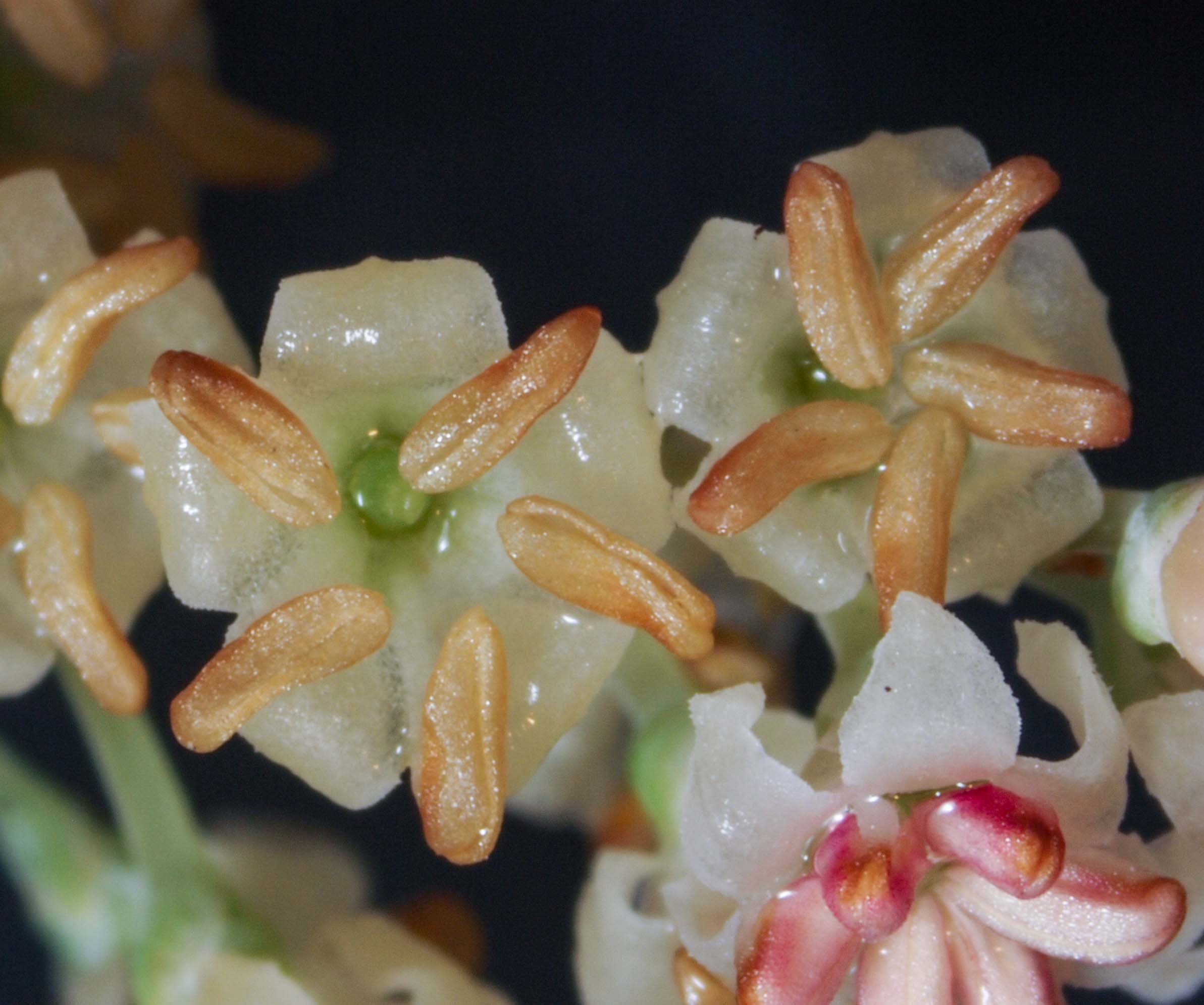
Tree Broom-heath
Monotoca elliptica
Close up of the small flowers of this species.
Family: Ericaceae (heaths)
Photo taken in August
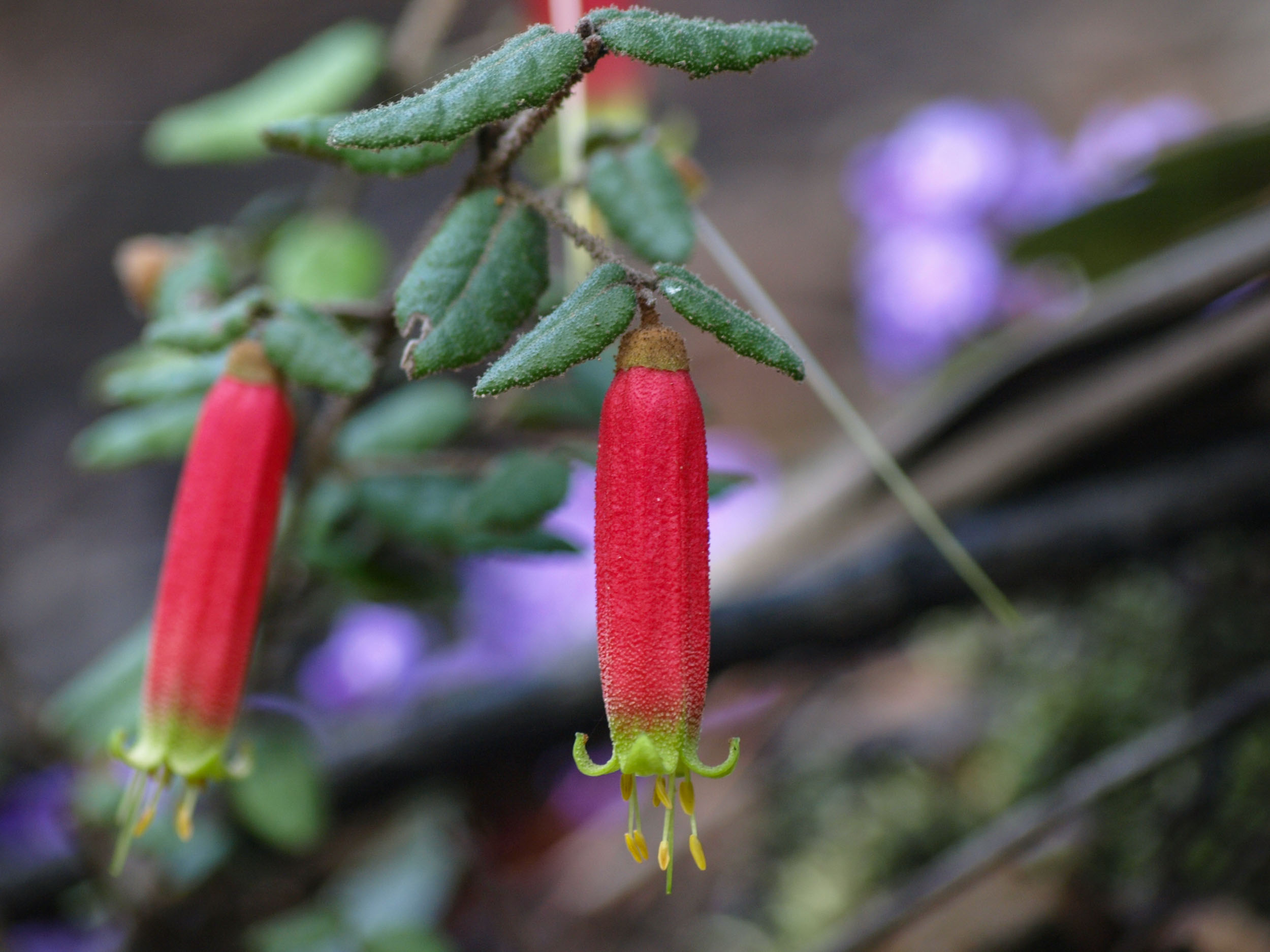
Common Correa
Correa reflexa
Another species that flowers in the Winter. In fact, its bell-shaped blooms can be seen for most of the year, except for the peak of Summer. It is one of the 'signature' plants on the block - being widespread, having an eye-catching flower and blooming for much of the year. Like the similarly shaped flower of Epacris impressa, Correa is an important food source for the Eastern Spinebill. The Red Wattlebird, Crescent Honeyeater and New Holland Honeyeater also take nectar from these flowers. The purple flowers in the background are Hardenbergia violacea, the Purple Coral-pea.
Family: Rutaceae (citrus)
Photo taken in August
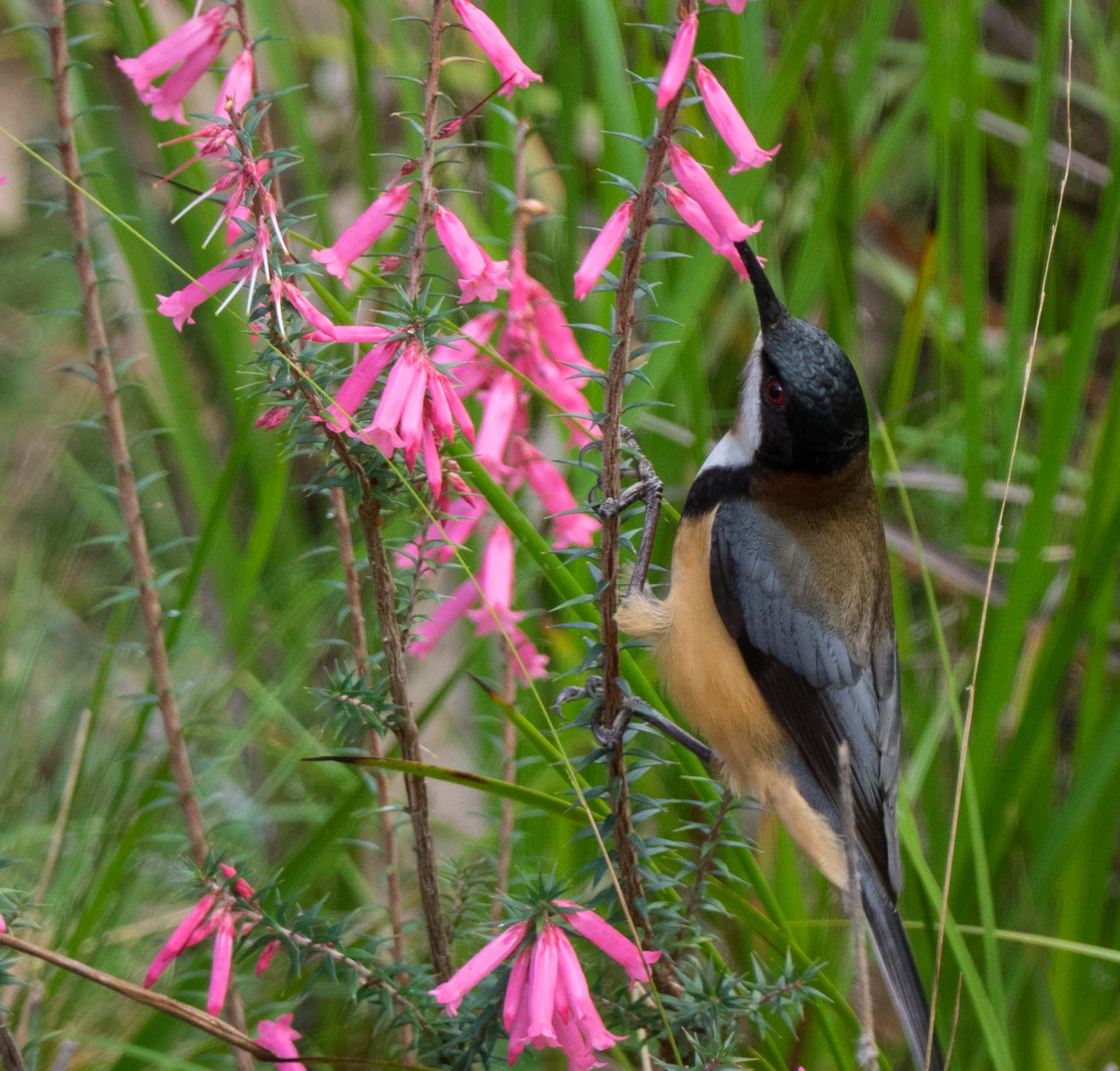
Common Heath
Epacris impressa
In Winter the block is covered by the pink, red or white flowers of this plant. Its provides an important food source for the Eastern Spinebill, which has a beak superbly fashioned to extract the nectar from the tubular flowers. A number of birds, including White-winged Coughs, Pied Currawongs and Crimson Rosellas use a less subtle method to gain nourishment from the plant - they snip off and eat whole flowers.
E. impressa is one of the diagnostic species for our type of forest - Lowland Gully Shrub Forest.
Family: Ericaceae (heaths)
Photo taken in July
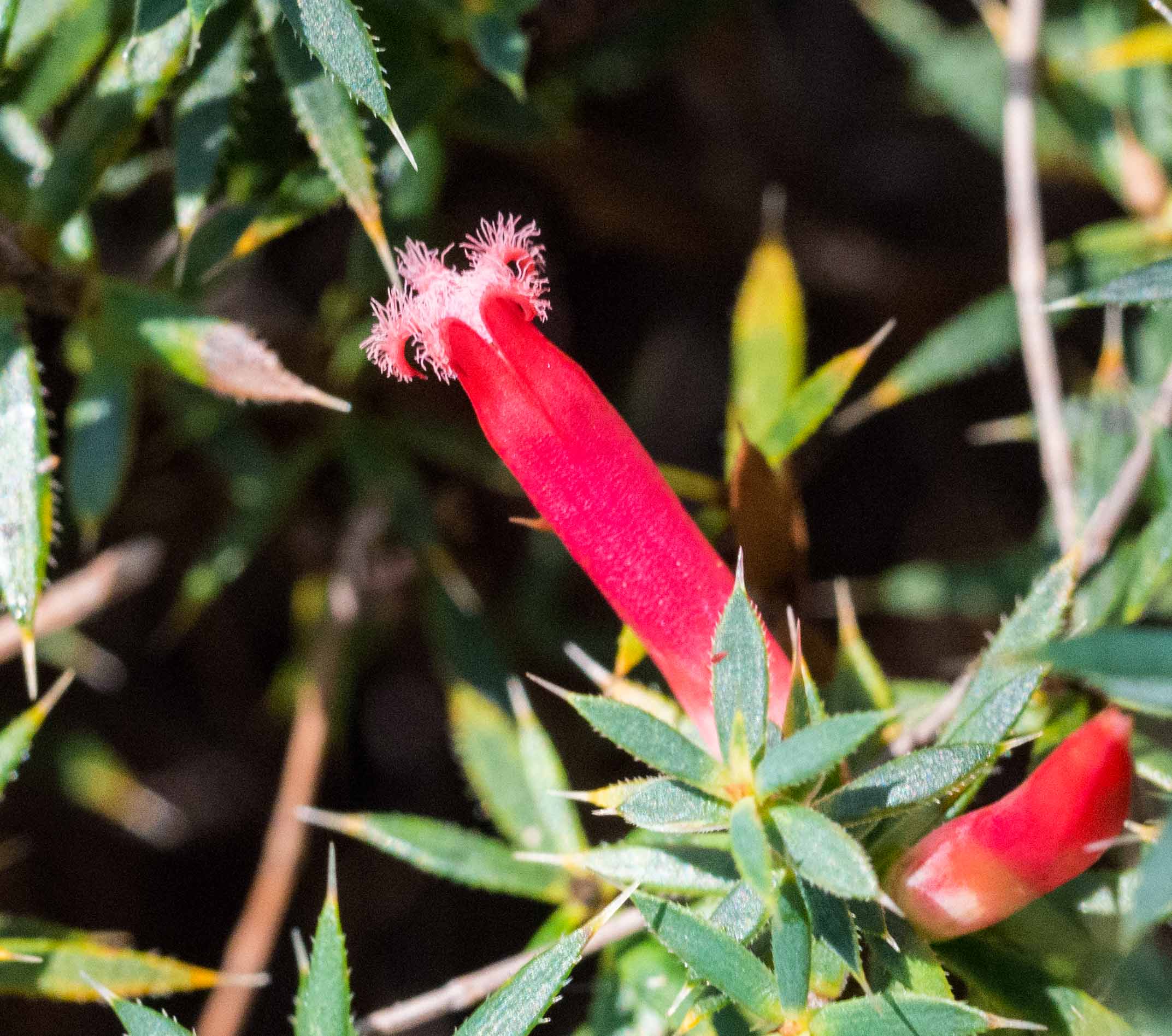
Native Cranberry
Astroloma humifusum
This is a low forb, which is restricted to the steep cliff faces overlooking the river. It produces a reddish, slightly succulent fruit, which inspired the common name.
Family: Ericaceae (heaths)
Photo taken in April
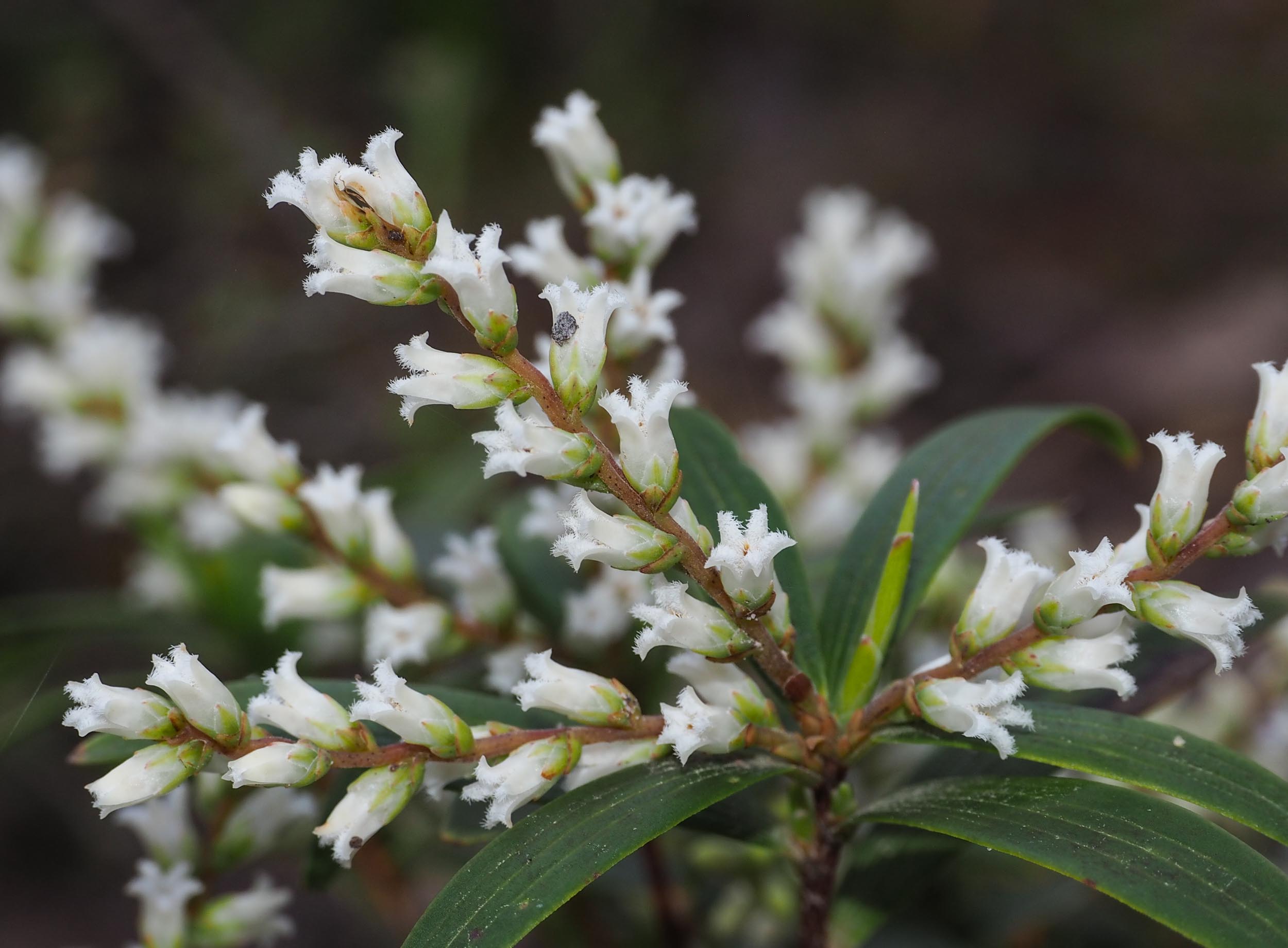
Lance Beard-heath
Leucopogon affinis
This species grows as a medium-sized compact shrub and is one of the most widespread on the block. It flowers profusely from early August to October. On sunny days in Spring a strong scent of vanilla from these plants wafts across the block. The fruit is a round, red berry, which is avidly eaten by several of the larger birds on the block, including Satin Bowerbird, Pied Burrawong, Yellow-faced Honeyeater, King Parrot and Crimson Rosella.
Family: Ericaceae (heaths)
Photo taken in August
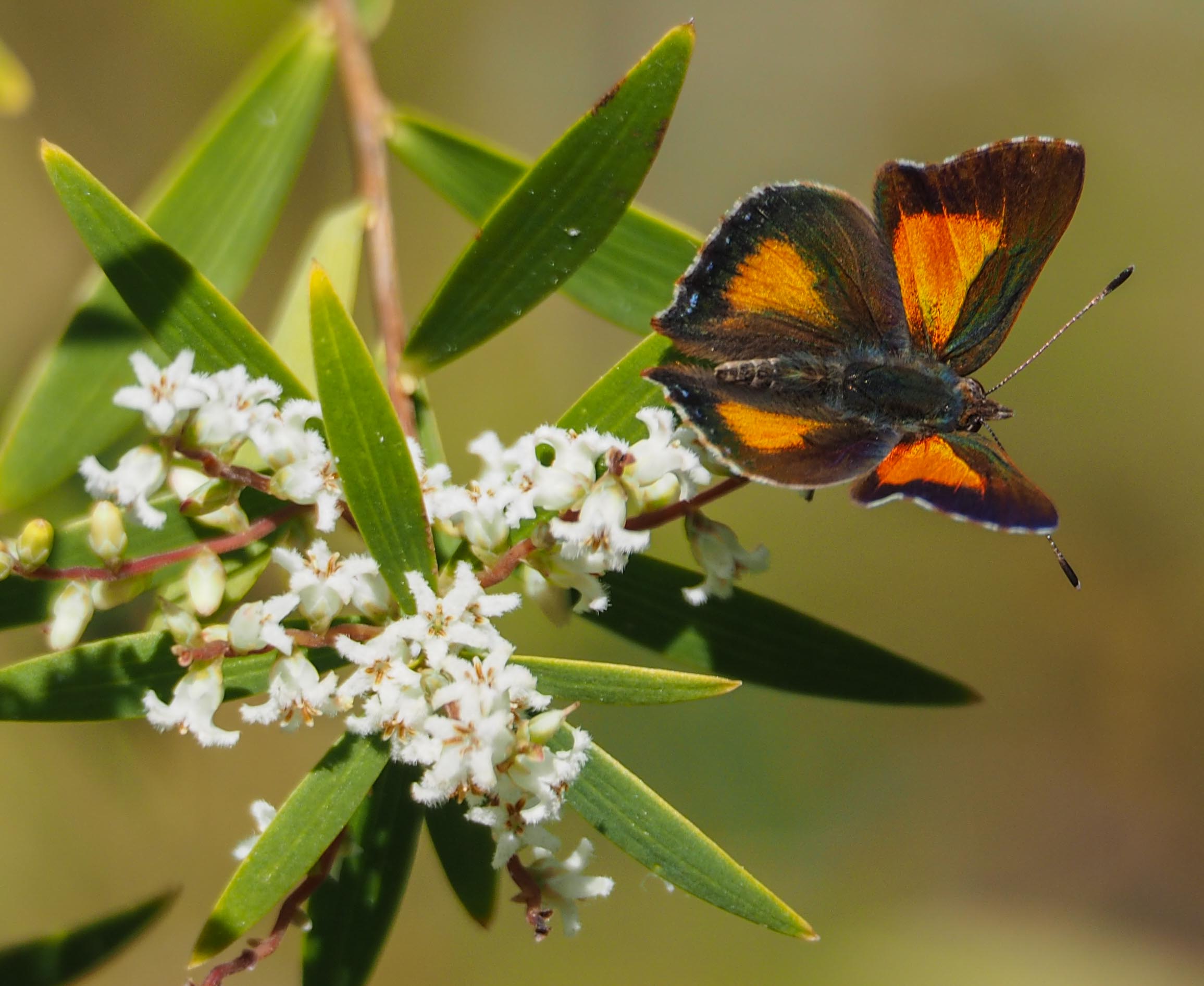
Lance Beard-heath
Leucopogon affinis
The Bright Copper Paralucia aurifer is one of several butterflies and other insects that feed on and pollinate the flowers of this species.
Family: Ericaceae (heaths)
Photo taken in August
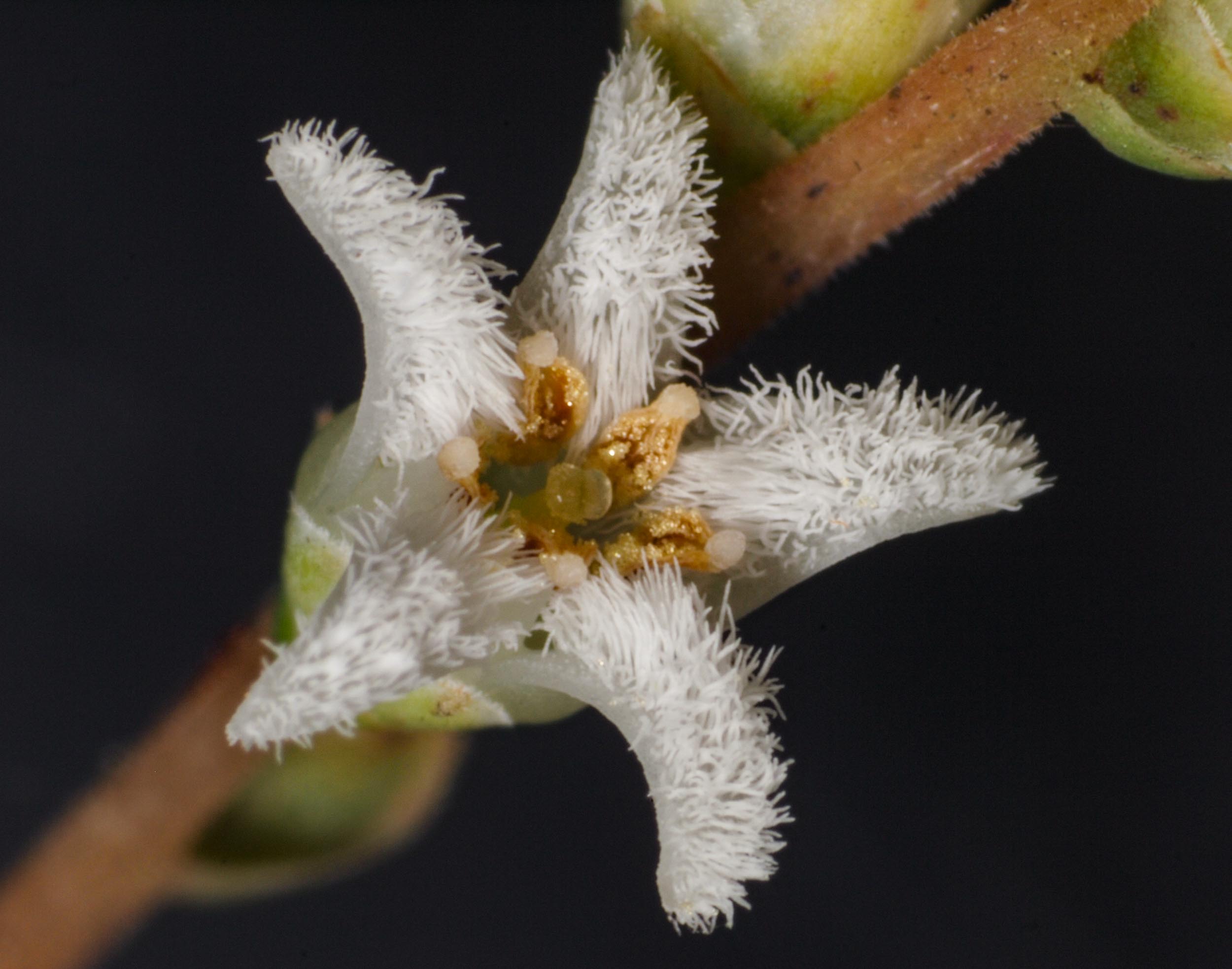
Lance Beard-heath
Leucopogon affinis
Close-up view of the flower of this species, showing the "bearded" petals from which the plant gets its common name.
Family: Ericaceae (heaths)
Photo taken in August

Lance Beard-heath
Leucopogon affinis
The fruit of this plant is a berry which turns from green to orange to red as it ripens. The birds seem to prefer the red ones but we have also seen them take the orange and green berries.
Family: Ericaceae (heaths)
Photo taken in December
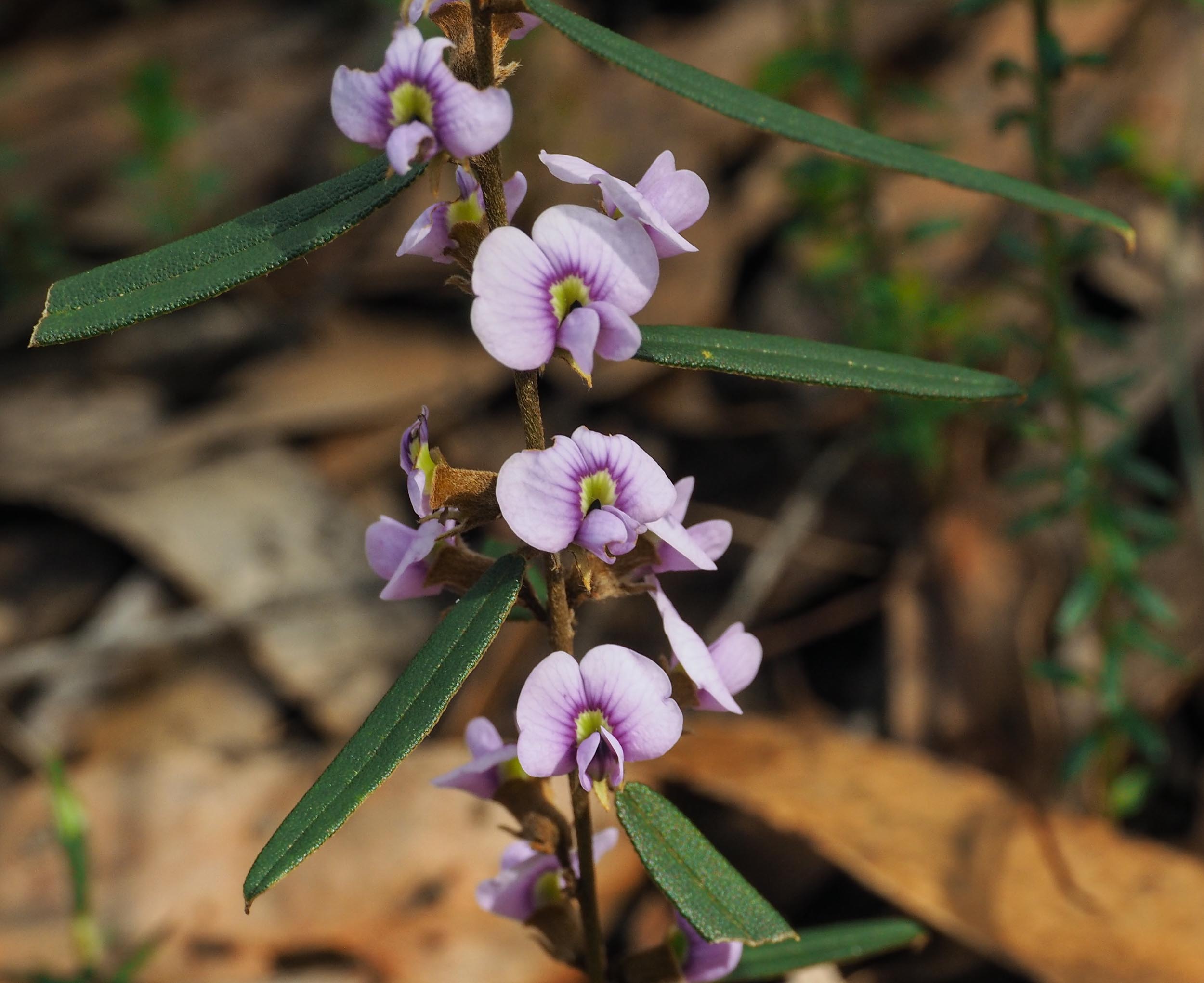
Rusty Velvet-pods
Hovea pannosa
Another of the 21 species in the family Fabaceae, subfamily Faboideae (legumes) that grow on the block. The attractive purple flowers appear in August-September and the plant grows as a prostrate herb. The species gets its common name from its hairy pods.
Family: Fabaceae Subfamily: Faboideae (legumes)
Photo taken in August
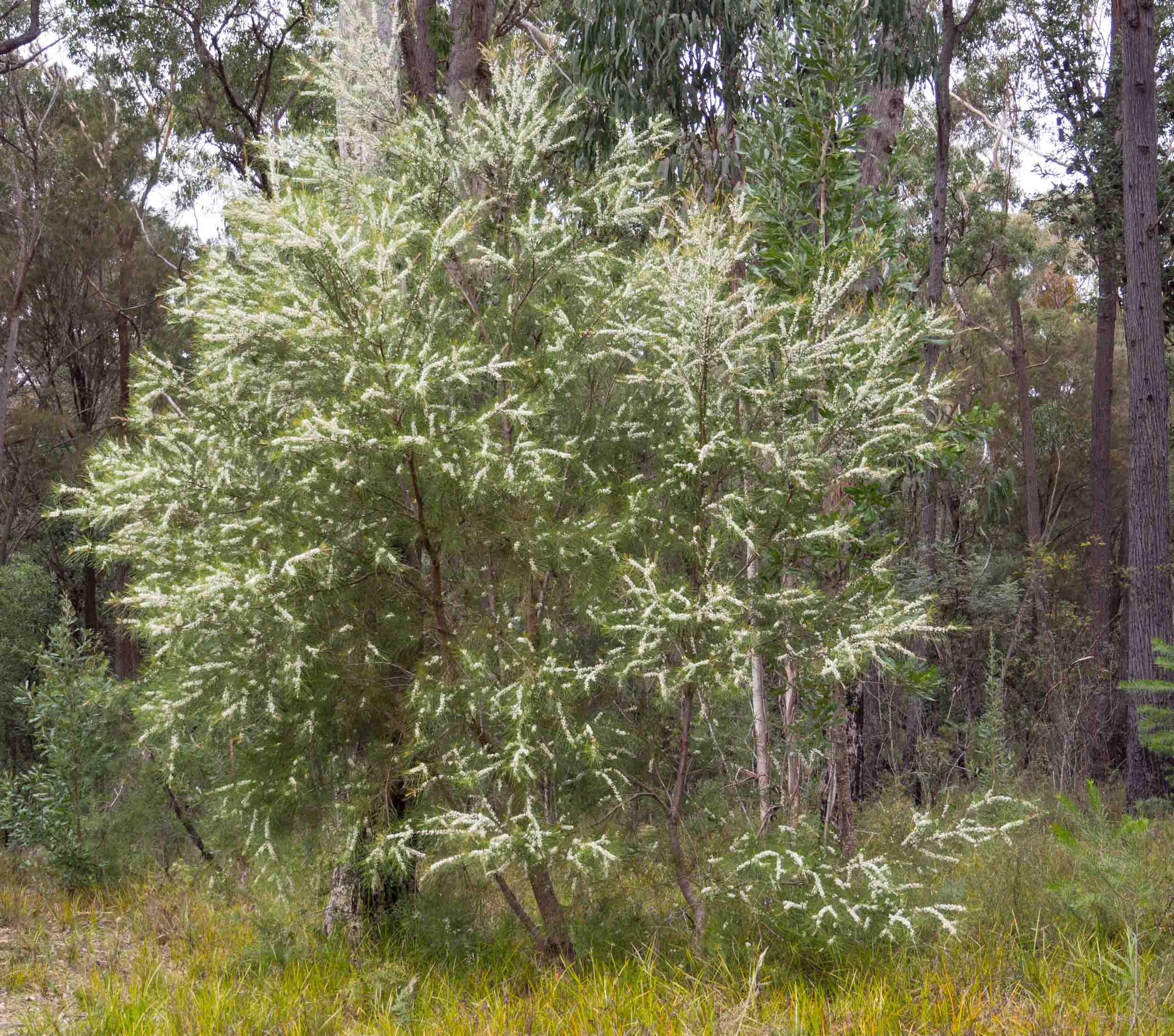
Willow Needlewood
Hakea macraeana
This Hakea species grows into a large bush or low tree - up to 7m tall. The leaves take the form of cylindrical spikes. The seeds from its woody fruit are a favourite food of Yellow-tailed Black Cockatoos. When in full bloom it makes quite a show!
Family: Proteaceae (proteas, banksias, grevilleas)
Photo taken in September
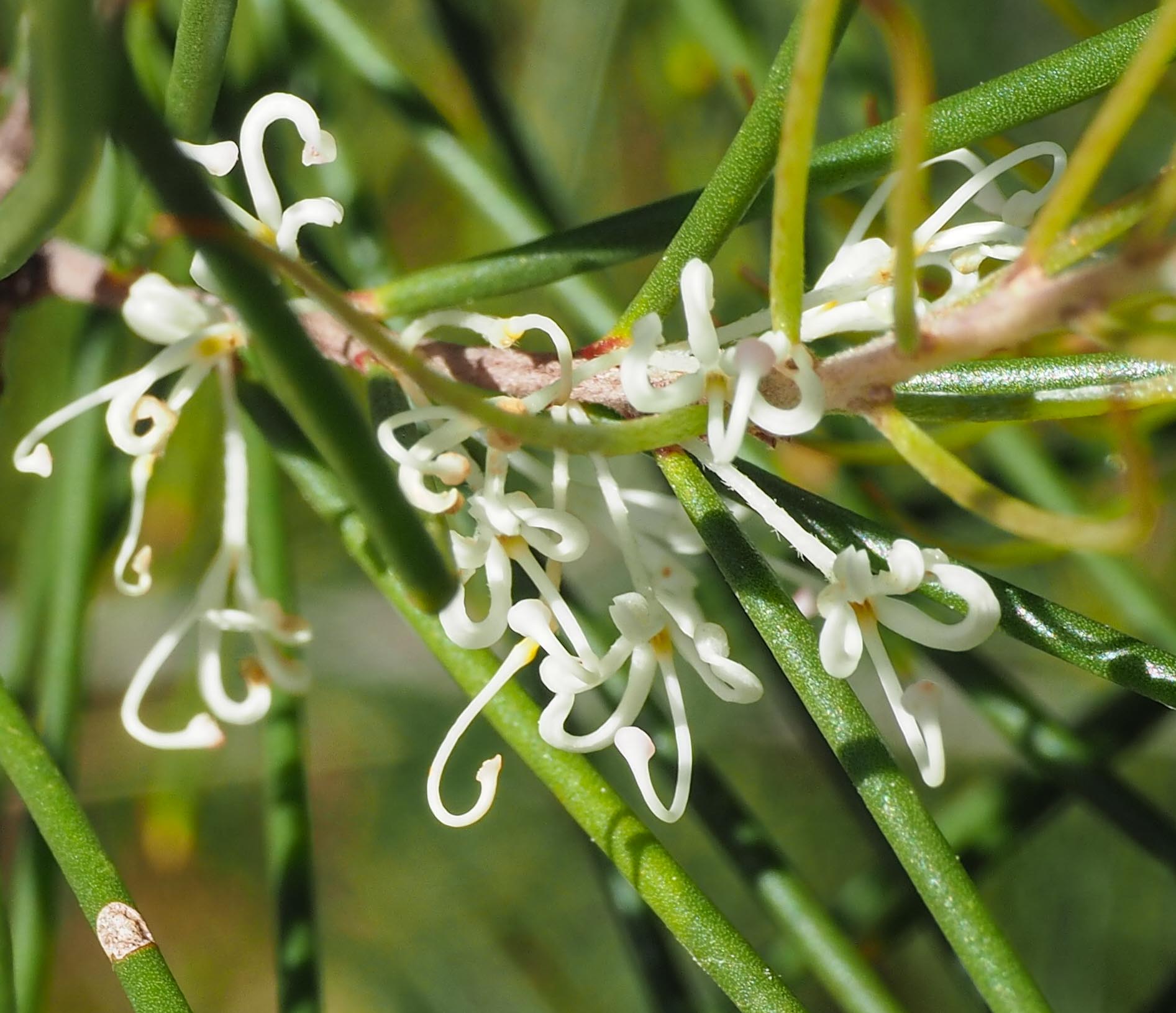
Willow Needlewood
Hakea macraeana
Like other members of the Proteaceae family, Hakea macraeana has a specialised pollination mechanism. Normally, the stigma, the tip of the style, receives pollen brought in from another flower by a pollinator - a bee, fly or other insect. In Hakea, the stigma picks up pollen from the anthers inside its own flower while the flower is still closed. The flower then opens, the style loops out and presents that pollen to the pollinator. Several curved styles - 'pollen presenters' - can be seen in the flowers in the bottom part of this image.
Family: Proteaceae (proteas, banksias, grevilleas)
Photo taken in September

Narrow-leaf Geebung
Persoonia linearis
This is a very common large shrub (up to 3m tall) on the block. It has a long flowering period - from December to July.
Family: Proteaceae (proteas, banksia, grevilleas)
Photo taken in July
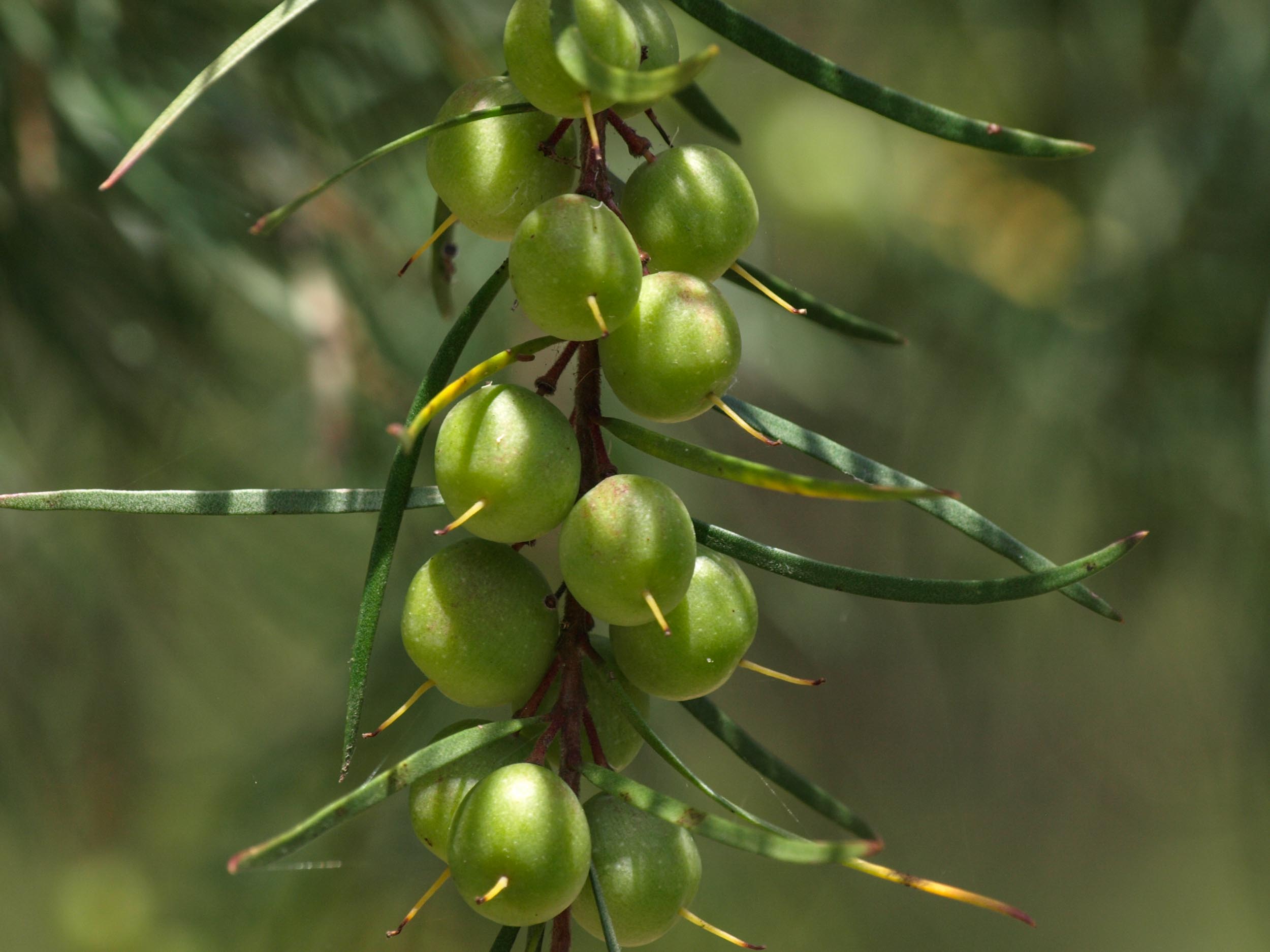
Narrow-leaf Geebung
Persoonia linearis
The fruit of Persoonia is a green, fleshy berry and is a well-known bush tucker. It is also eaten by Satin Bowerbirds. I don't muchcare for it myself, personally.
Family: Proteaceae (proteas, banksias, grevilleas)
Photo taken in November
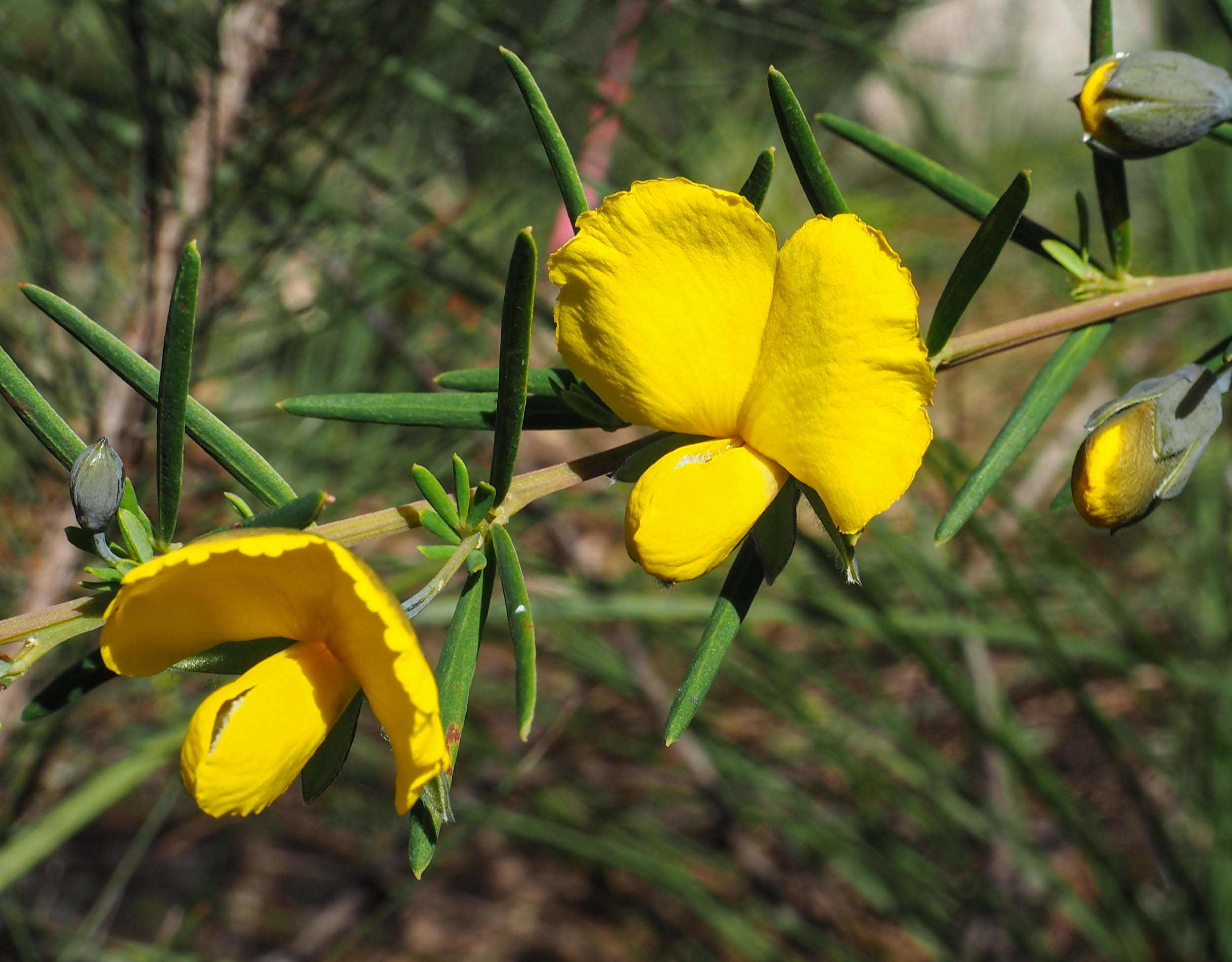
Golden Glory Pea
Gompholobium latifolium
This plant grows as a medium-sized bush with dense foliage. The leaves are sub-divided into three narrow leaflets. The flowers are larger than many other peas.
Family: Fabaceae Subfamily: Faboideae (legumes)
Photo taken in September

Moss
Rosulabryum capillare
This moss is sporulating. Green spore-bearing caps, sporophytes, are present on the tips of the red stalks (setae).
Family: Bryaceae
Photo taken August
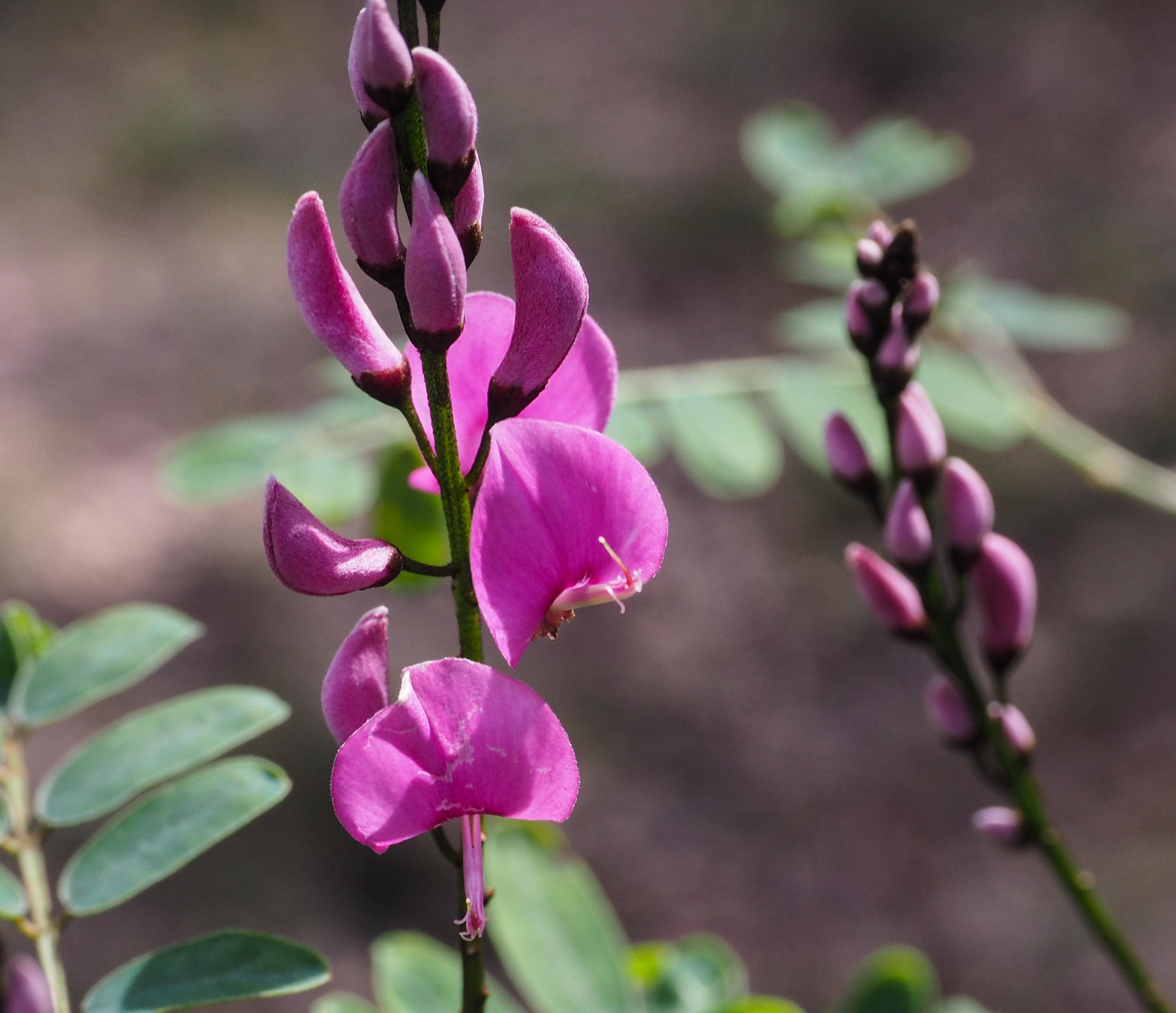
Austral Indigo
Indigofera australis
A straggly, medium sized shrub. Large numbers of striking, pink flowers appear in late July and the plant continues to bloom through to October.
Family: Fabaceae Subfamily: Faboideae (legumes)
Photo taken in September
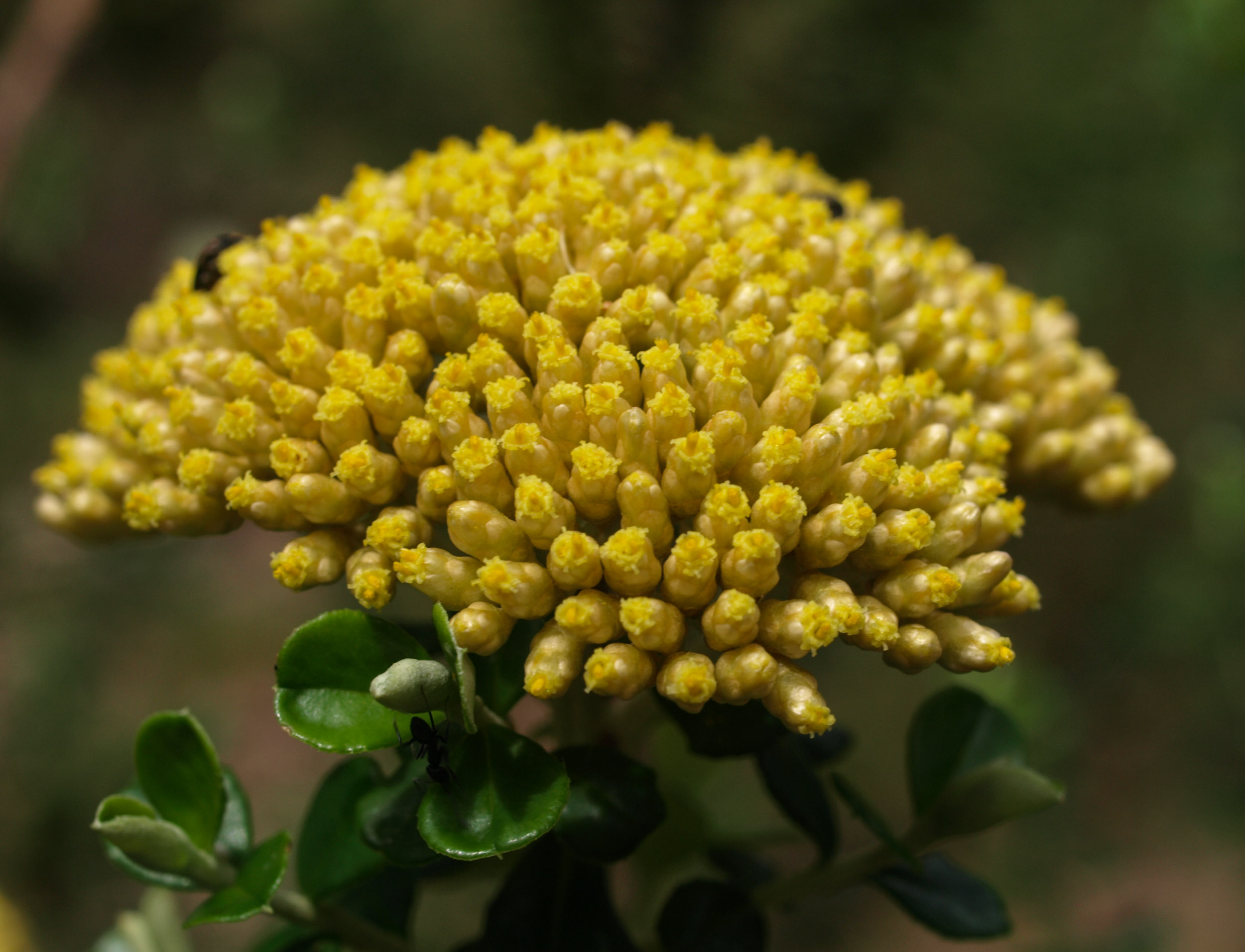
Grey Everlasting
Ozothamnus obcordatus
This medium-sized bush puts on a spectacular show when it flowers in late Spring. Like all Asteraceae, it produces flowering heads made up of many individual flowers, as can be clearly seen in this image. We have seen only two plants on the block to date, but each is visited by hordes of pollinating insects when in flower.
Family: Asteraceae (daisies)
Photo taken in November
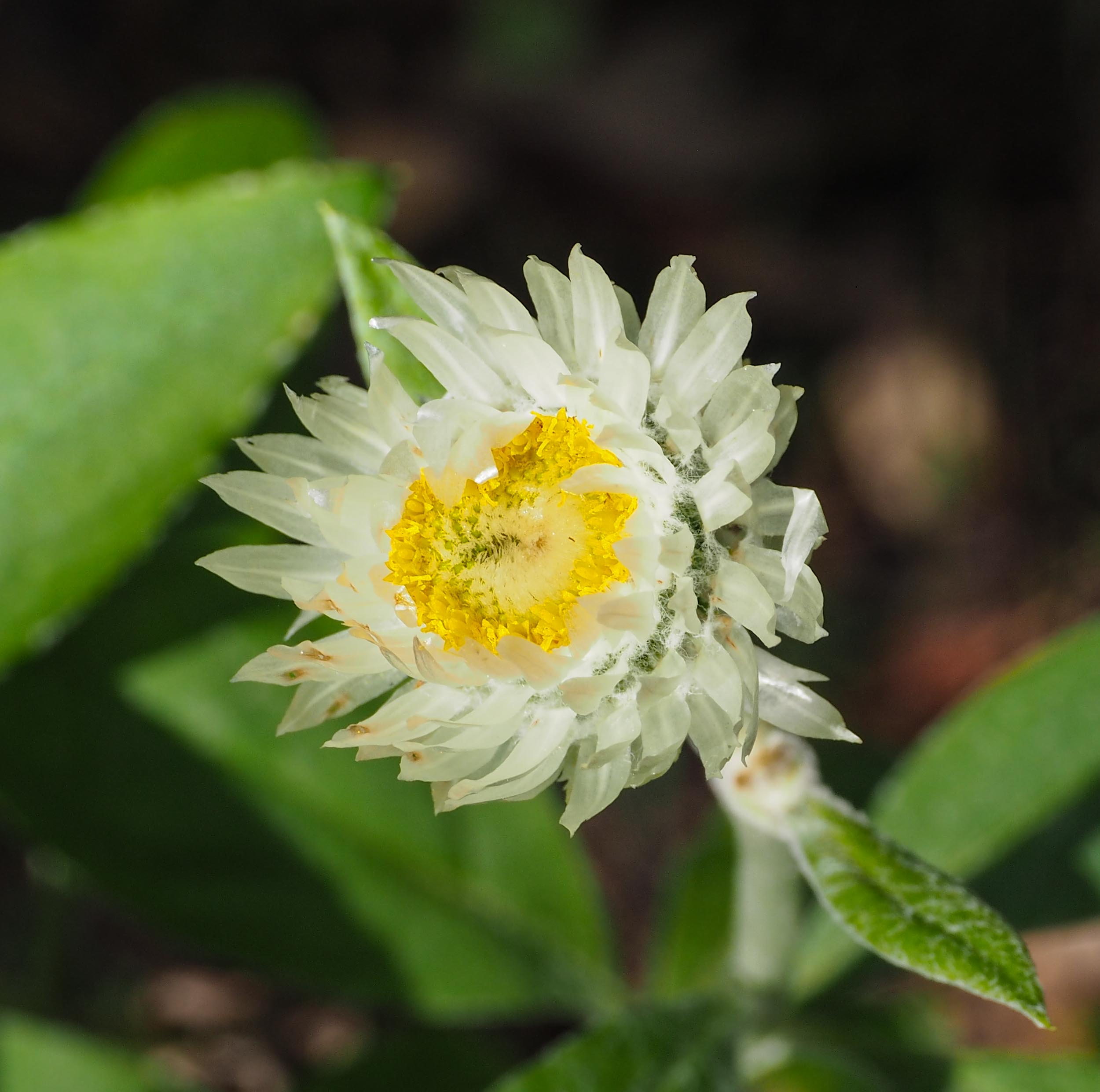
Tall Everlasting
Coronidium elatum
This perennial herb is a coloniser of disturbed soil. We found many on the block after we bought it. The fruit is wind dispersed and thus readily spreads over long distances. The flowering heads are tall - often over 1.5m high - and appear in early Spring. We have found 15 species of Asteraceae on the block, two of which are introduced weeds.
Family: Asteraceae (daisies)
Photo taken in September
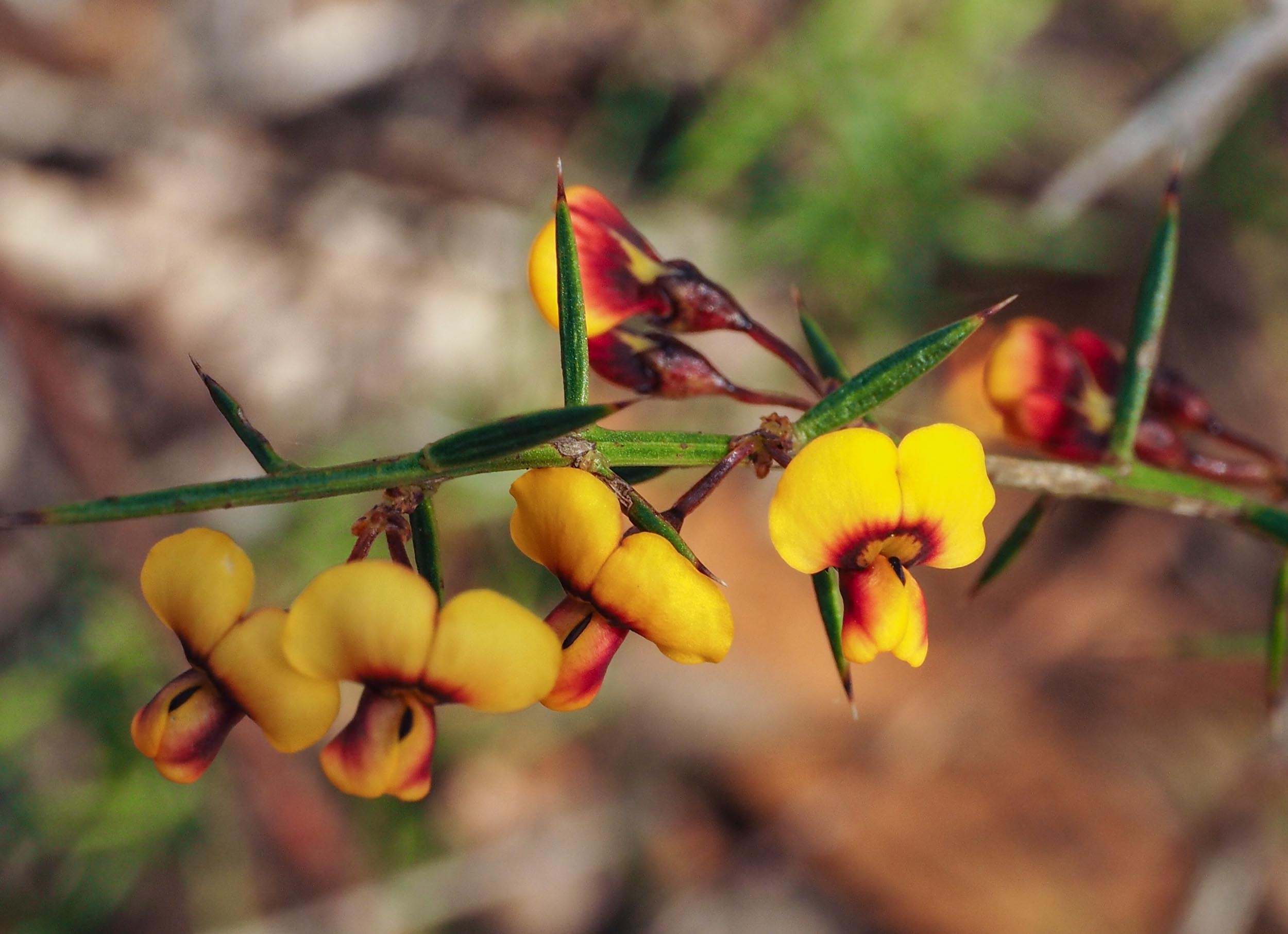
Gorse Bitter-Pea
Daviesia ulicifolia
This low shrub has spiky leaves (actually phyllodes, as seen in many wattles) and flowers in September.
Family: Fabaceae Subfamily: Faboideae (legumes)
Photo taken in September

Nodding Greenhood
Pterostylis nutans
Numerous clusters of these orchids are seen on the block from late July to September. All Pterostylis species grow in association with a fungus in the soil, which is required for germination of the seeds of the orchid. Like many other orchids, parts of the flower resemble the sex organs of certain species of gnats and mosquitoes. As the males of those insects seek to mate with the bogus female, they transfer pollen between flowers.
Family: Orchidaceae (orchids)
Photo taken in September
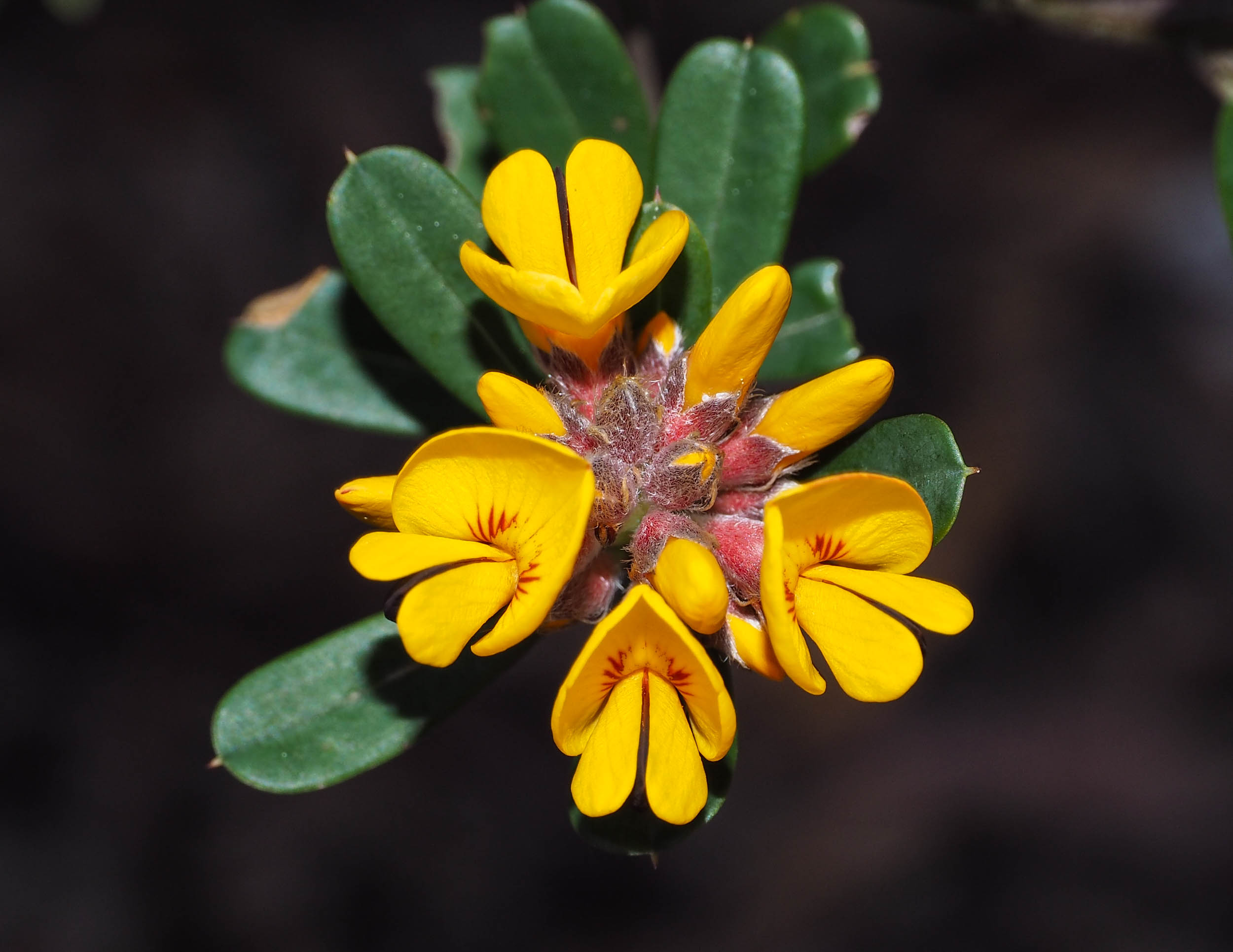
Large-leaf Bush-pea
Pultenaea daphnoides
A medium-sized shrub with large, paddle-shaped leaves. The plant is host to the larvae of the Fringed Heath Blue butterfly (Neolucia agricola).
P. daphnoides is one of the diagnostic species for our type of forest - Lowland Gully Shrub Forest.
Family: Fabaceae Subfamily: Faboideae
Photo taken in September
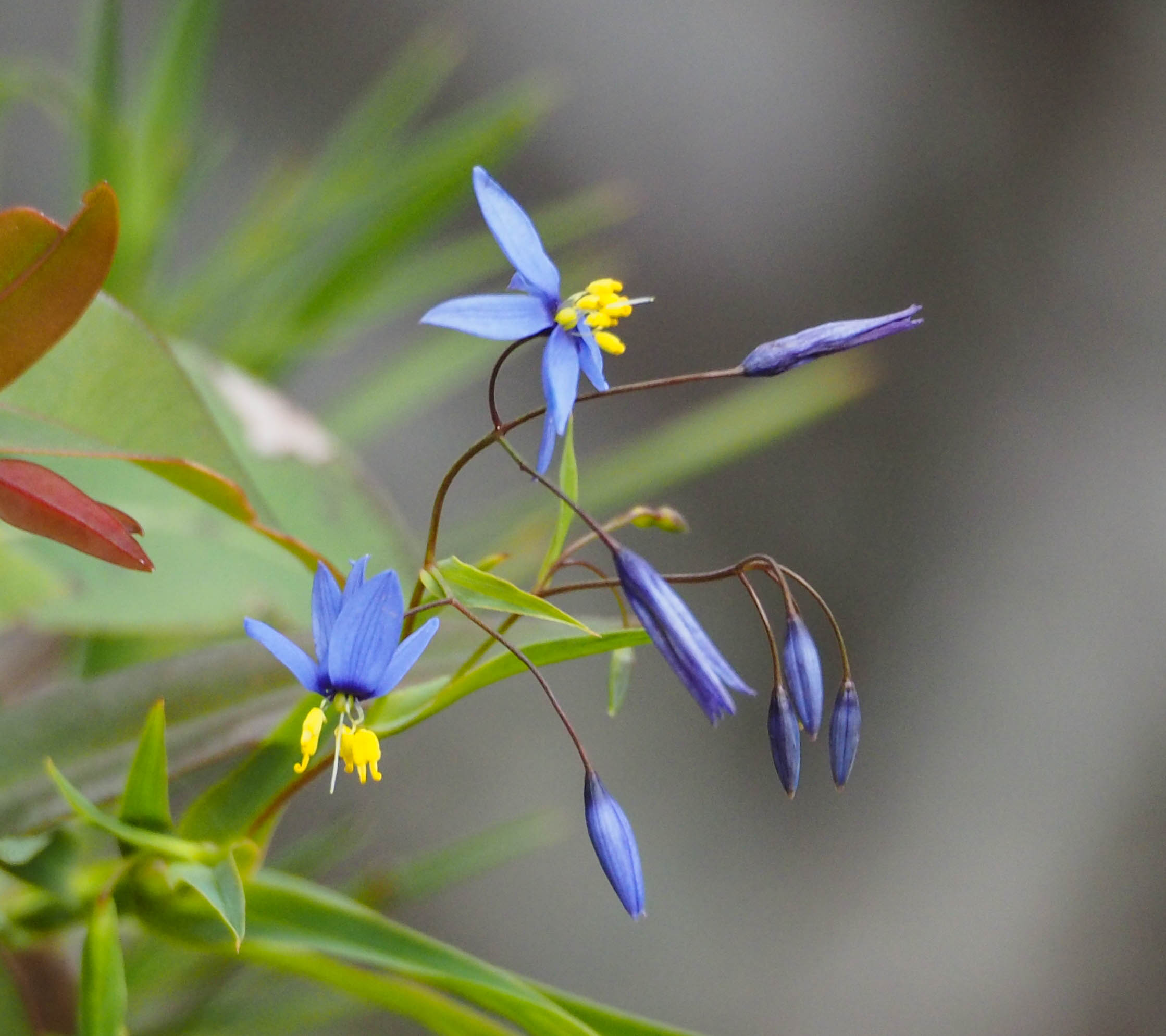
Blue Flax-lily
Dianella caerulea
Another widespread, low herb on the block, which flowers through Spring and early Summer. It is buzz-pollinated by native bees, such as the Green and Gold Nomia Bee (Lipotriches australica).
D. caerulea is one of the diagnostic species for our type of forest - Lowland Gully Shrub Forest.
Family: Xanthorrhoeaceae Subfamily: Hemeracallidoideae
Photo taken in October
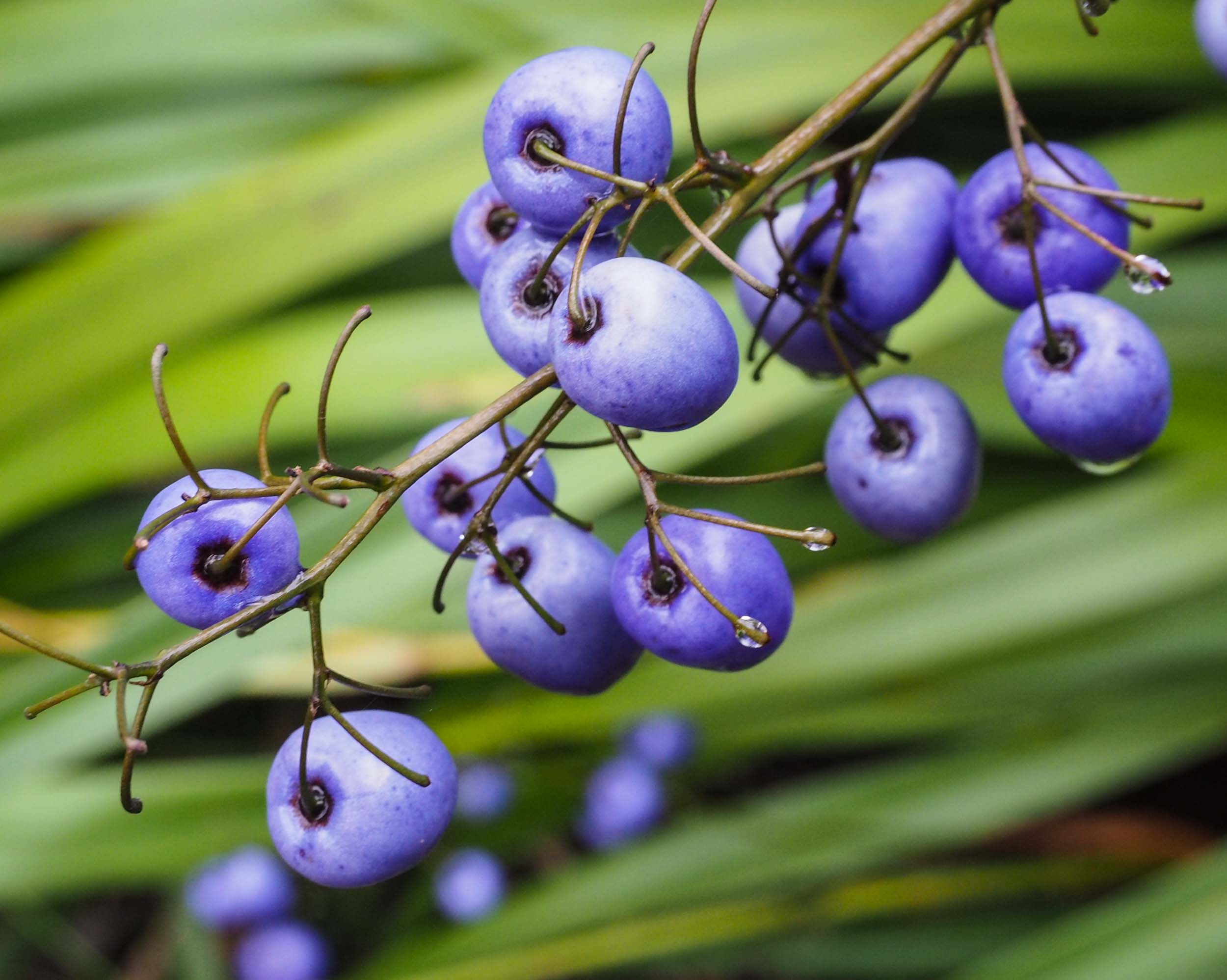
Blue Flax-lily
Dianella caerulea
The fruit of Dianella is a purple berry, which is eaten by birds such as the Yellow-faced Honeyeater and Wonga Pigeon.
Family: Xanthorrhoeaceae Subfamily: Hemeracallidoideae
Photo taken in January
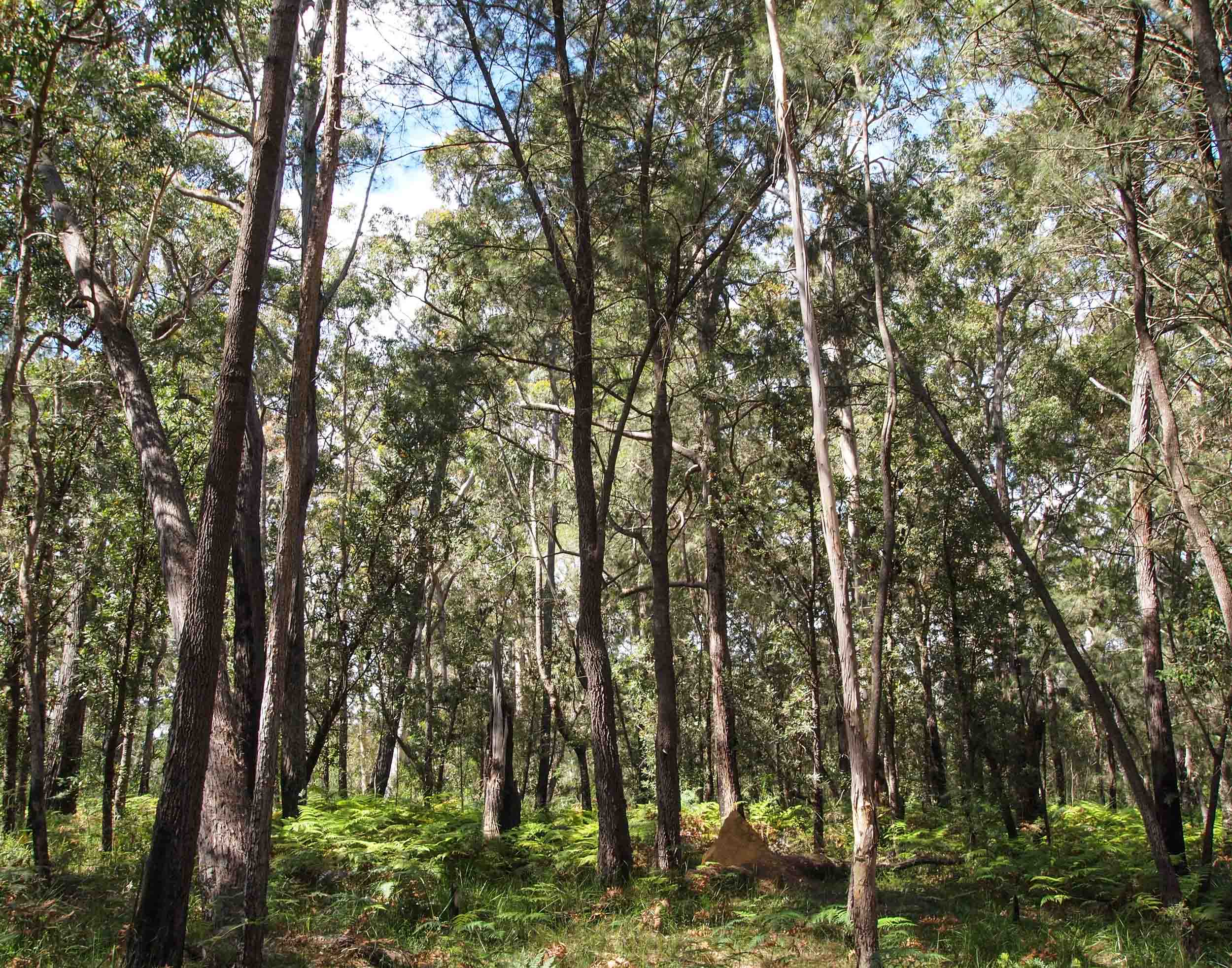
Casuarina
Allocasuarina littoralis
This casuarina species is a very widespread tree on the block. In some sites, such as in the shallow gully shown here, it is the dominant plant. They are the ones with the dark, ridged bark. We often hear and see Glossy Black Cockatoos high in these trees, feeding on the woody fruit. The seeds they extract are virtually the sole item of their diet. Allocasuarina is a common coloniser species - it has regrown vigorously on the block in areas of disturbance. Many trees die at a young age - perhaps due to damage from cerambycid beetle larvae or Yellow-tailed Black Cockatoos searching for the same.
Family: Casuarinaceae (she-oaks)
Photo taken in July
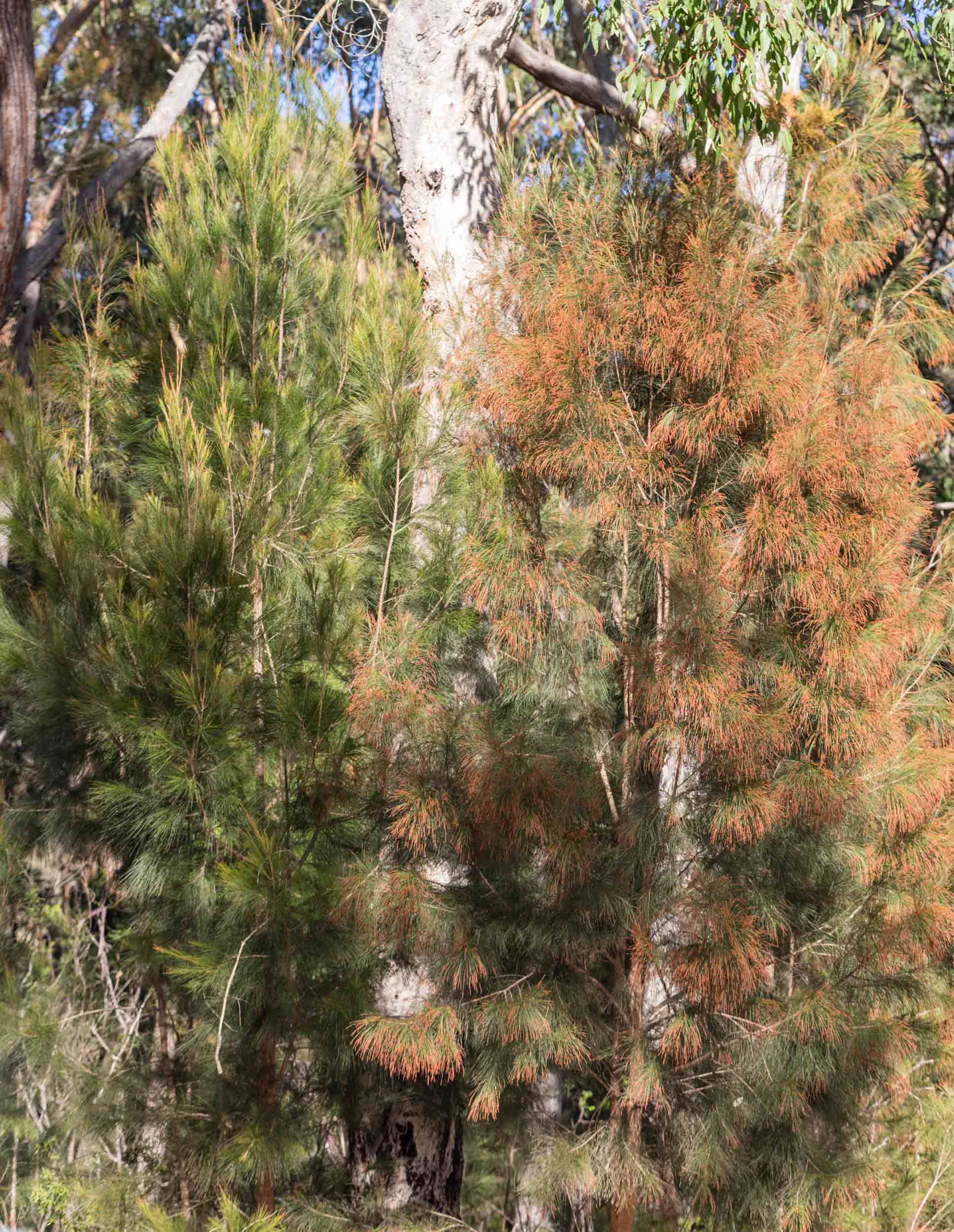
Casuarina
Allocasuarina littoralis
The tree on the right is a male, the one on the left a female. Both are flowering, but the male inflorescence is much more showy.
A. littoralis is one of the diagnostic species for our type of forest - Lowland Gully Shrub Forest.
Family: Casuarinaceae (she-oaks)
Photo taken in July
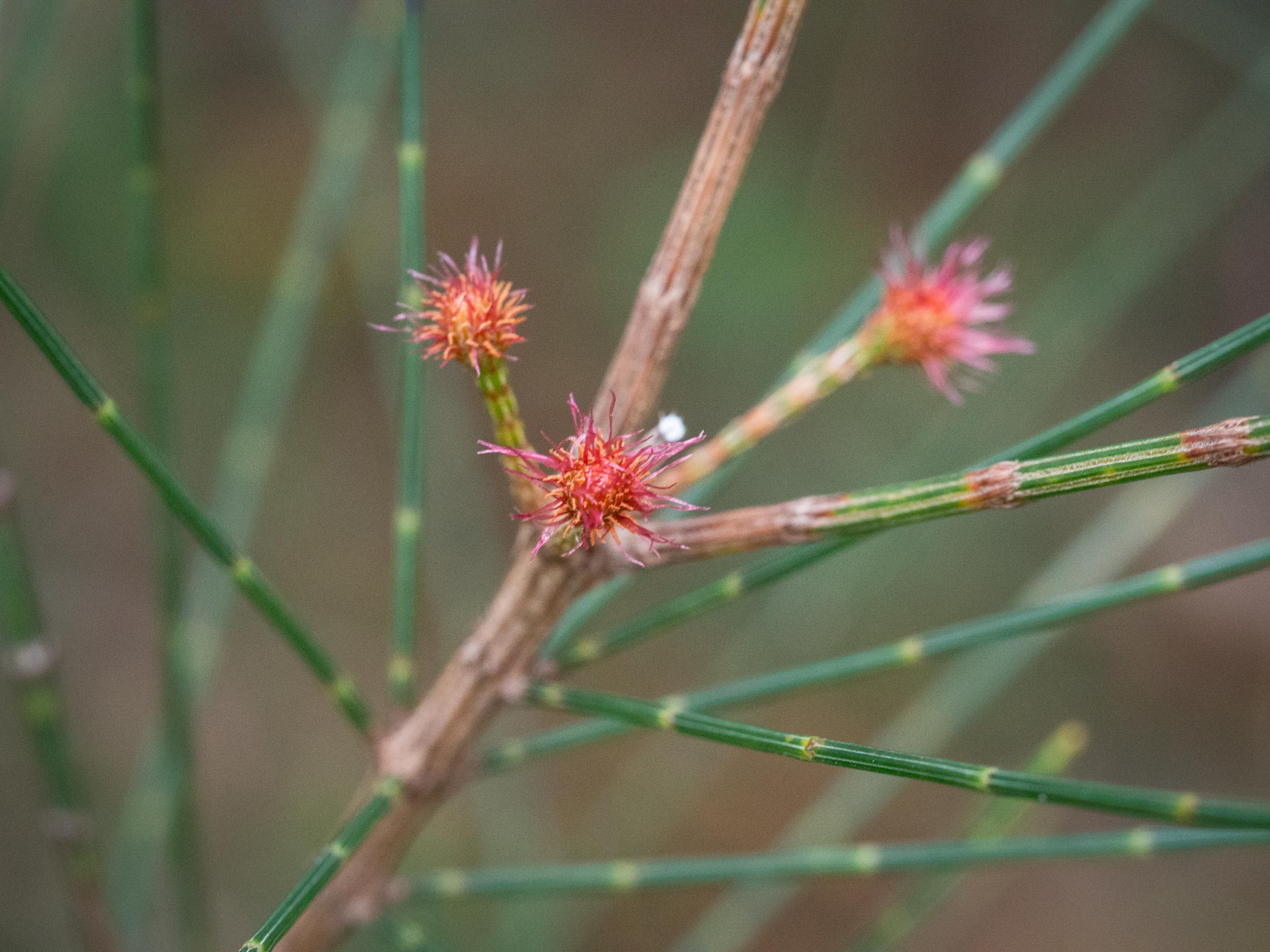
Casuarina
Allocasuarina littoralis
Casuarina has a number of unusual features. Its leaves have been reduced to minute scales, seen in the image as brown whorls spaced at regular intervals on the green, needle-shaped branchlets. Photosynthesis is carried out in these branchlets, which bear a superficial resemblance to the needles of pine trees. Casuarina is however a flowering plant (Angiosperm), not a Gymnosperm. (Confusingly though, its fruit does resembles the cones of conifers). Male and female flowers grow on separate plants. This image shows three female inflorescences. Each contains multiple carpels, so the fruit ('cone') developing from it has multiple seeds.
Family: Casuarinaceae (she-oaks)
Photo taken in April
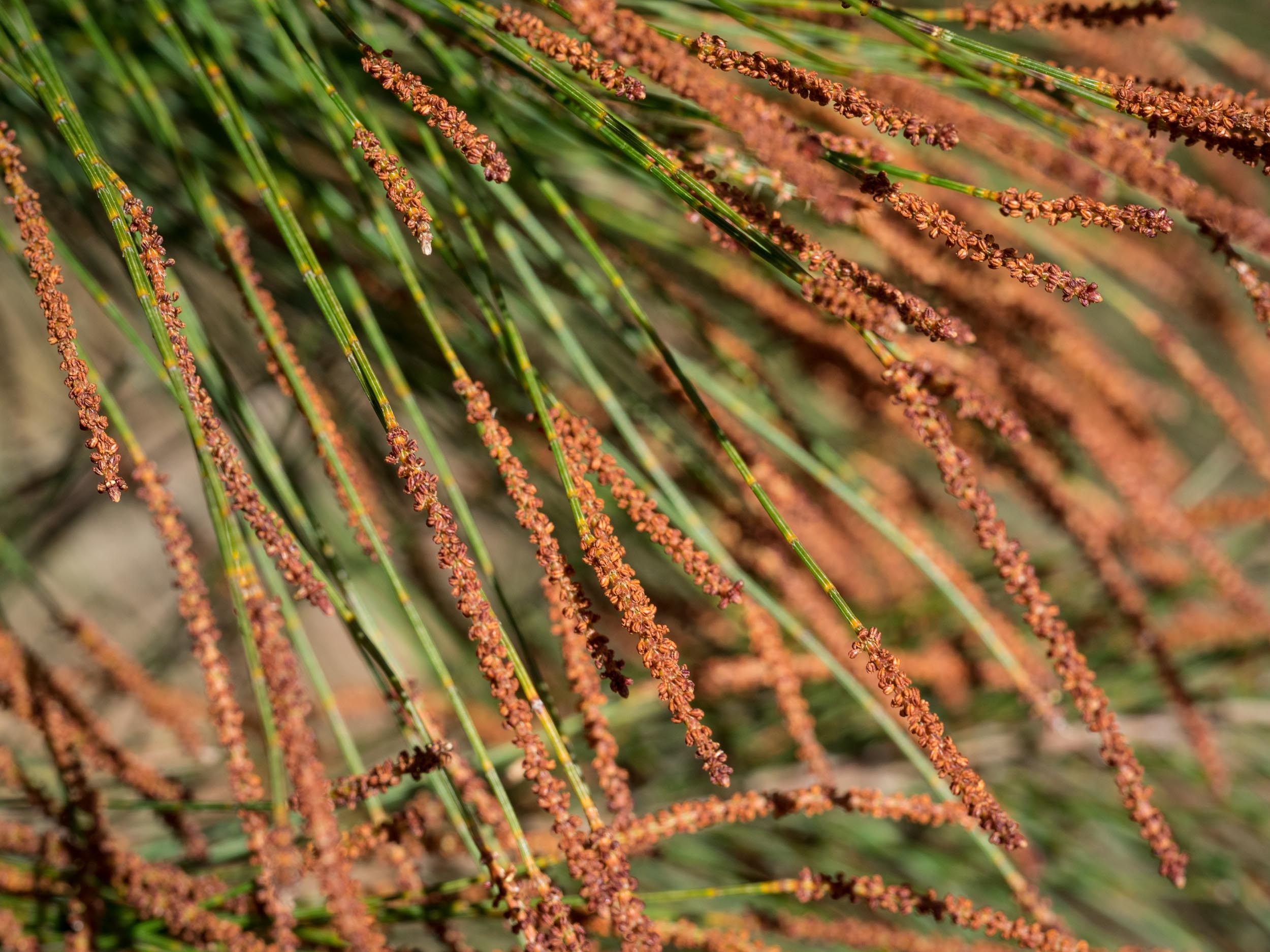
Casuarina
Allocasuarina littoralis
The male inflorescence of this species. The ends of the needle-like branchlets are densely covered in hundreds of individual male flowers, each of which bears a single, tan-coloured anther. Imagine the amount of pollen they must release!
Family: Casuarinaceae (she-oaks)
Photo taken in July
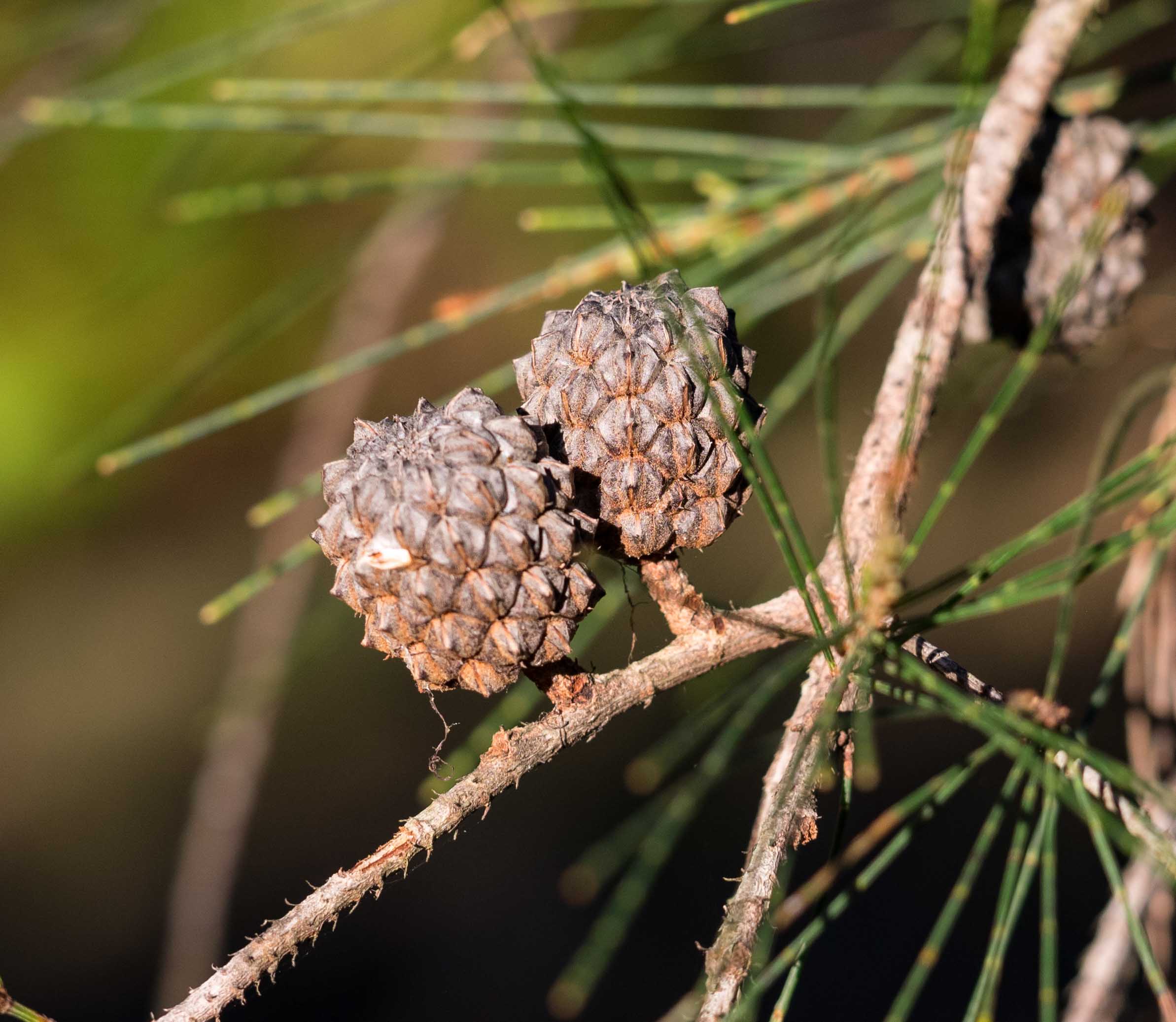
Casuarina
Allocasuarina littoralis
A collection of fruit on a female A. littoralis tree. Each of the several dozen valves in a fruit (which haven't yet opened in this image) contains a seed.
Family: Casuarinaceae (she-oaks)
Photo taken in July
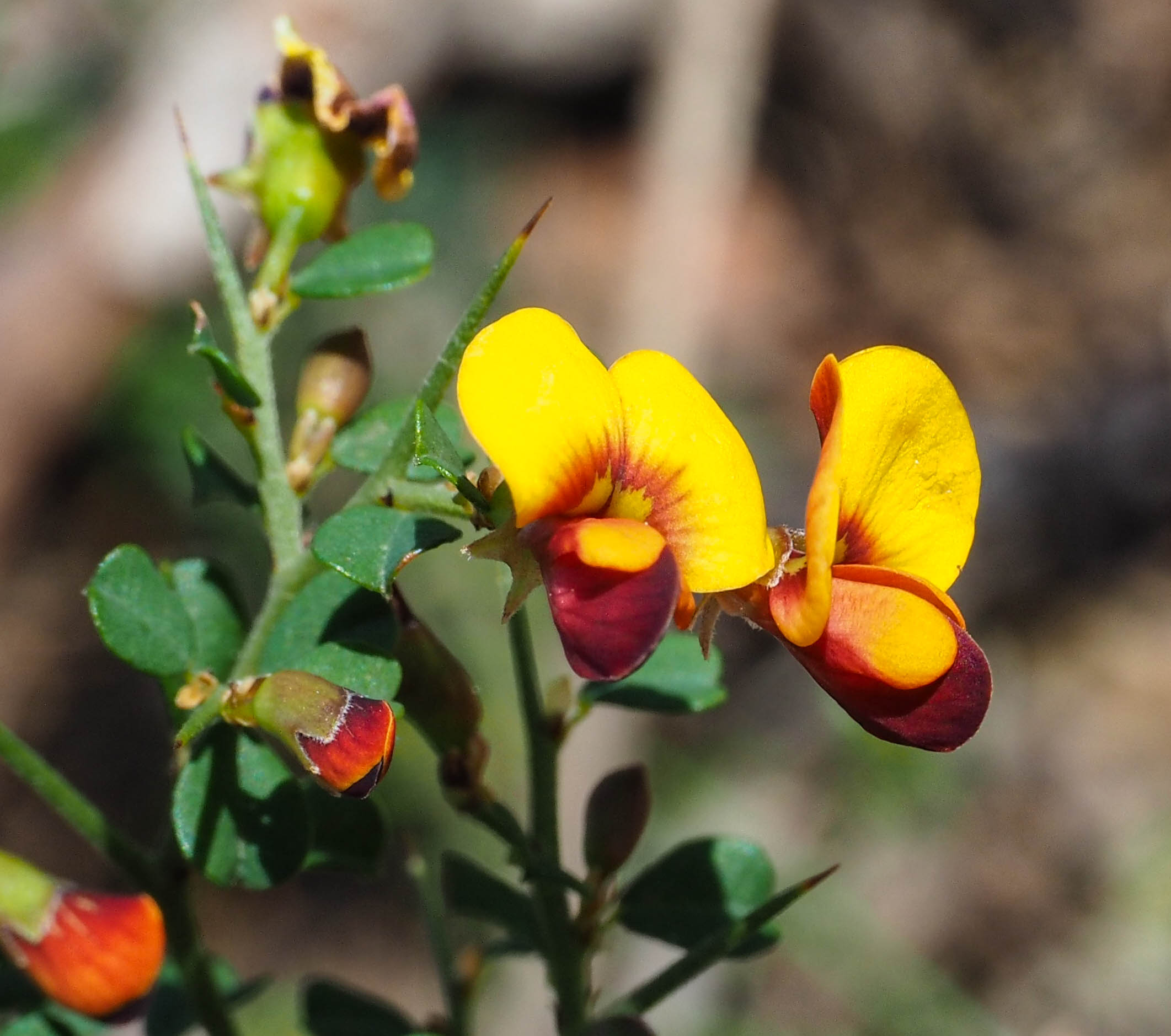
Spiny Bossiaea
Bossiaea obcordata
This low shrub has small, roundish leaves and bears numerous spines on the branches. It is one of the 31 Fabaceae species on the block. Like all plants that can fix nitrogen, Fabaceae do well in low nutrient soils, as occur widely on the block.
Family: Fabaceae Subfamily: Faboideae
Photo taken in September
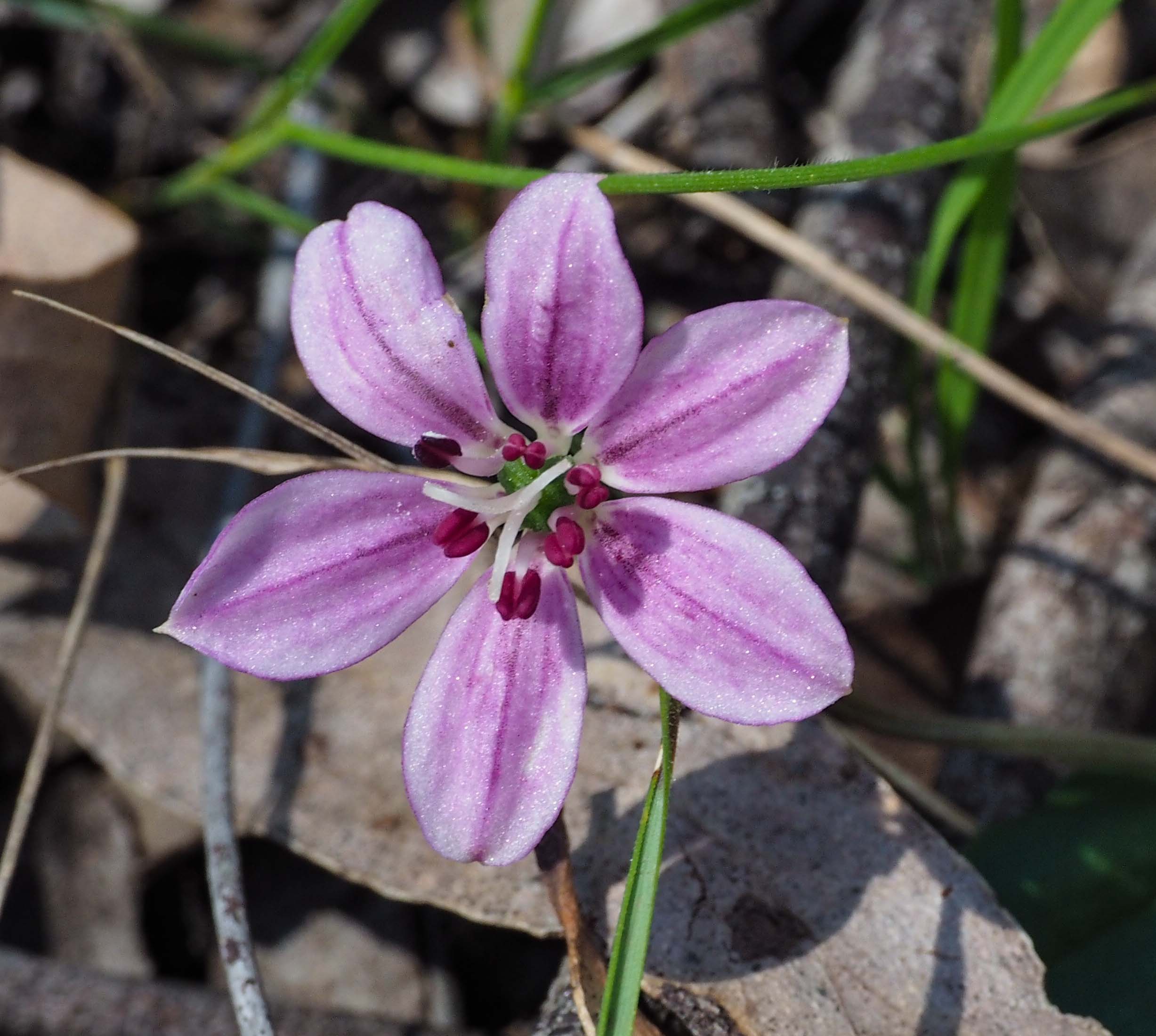
Lilac Lily
Schelhammera undulata
Schelhammera is a low growing herb. Its striking flowers appear in many areas of the block in Spring and the blooms persist until early Summer.
S. undulata is one of the diagnostic species for our type of forest - Lowland Gully Shrub Forest.
Family: Colchicaceae (autumn crocuses)
Photo taken in September
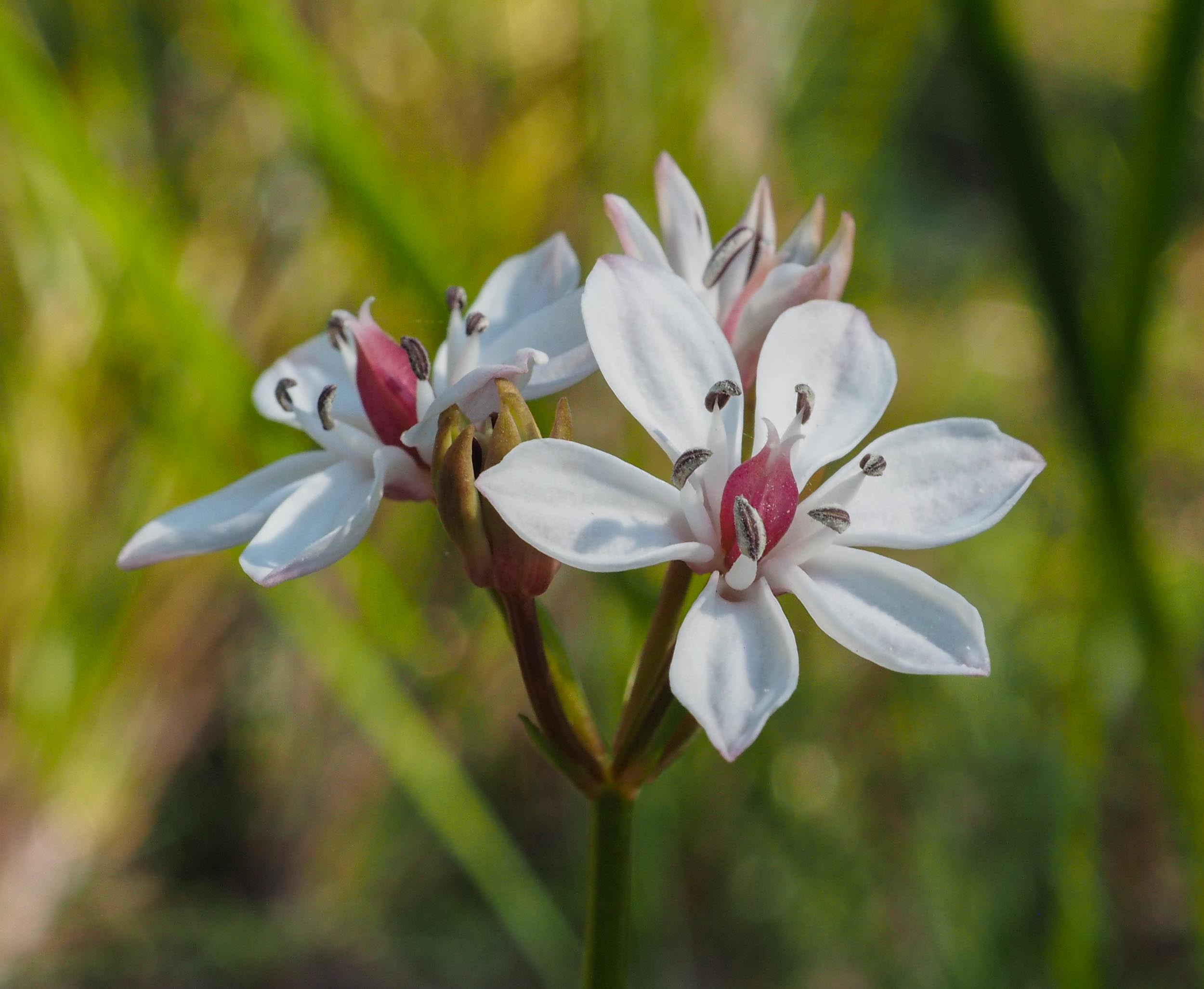
Popoto
Burchardia umbellata
This is a low growing forb, quite widespread on the block. Its attractive flower appears in Spring, growing on a short, elevated stalk. It and Schelhammera undulata are the only two members of the family Colchicaceae we have found here.
Family: Colchicaceae (autumn crosses)
Photo taken in October

Purple Fan-flower
Scaevola ramosissima
This plant grows in shaded areas of the forest. The attractive flowers appear in early November.
Family: Goodeniaceae
Photo taken in November
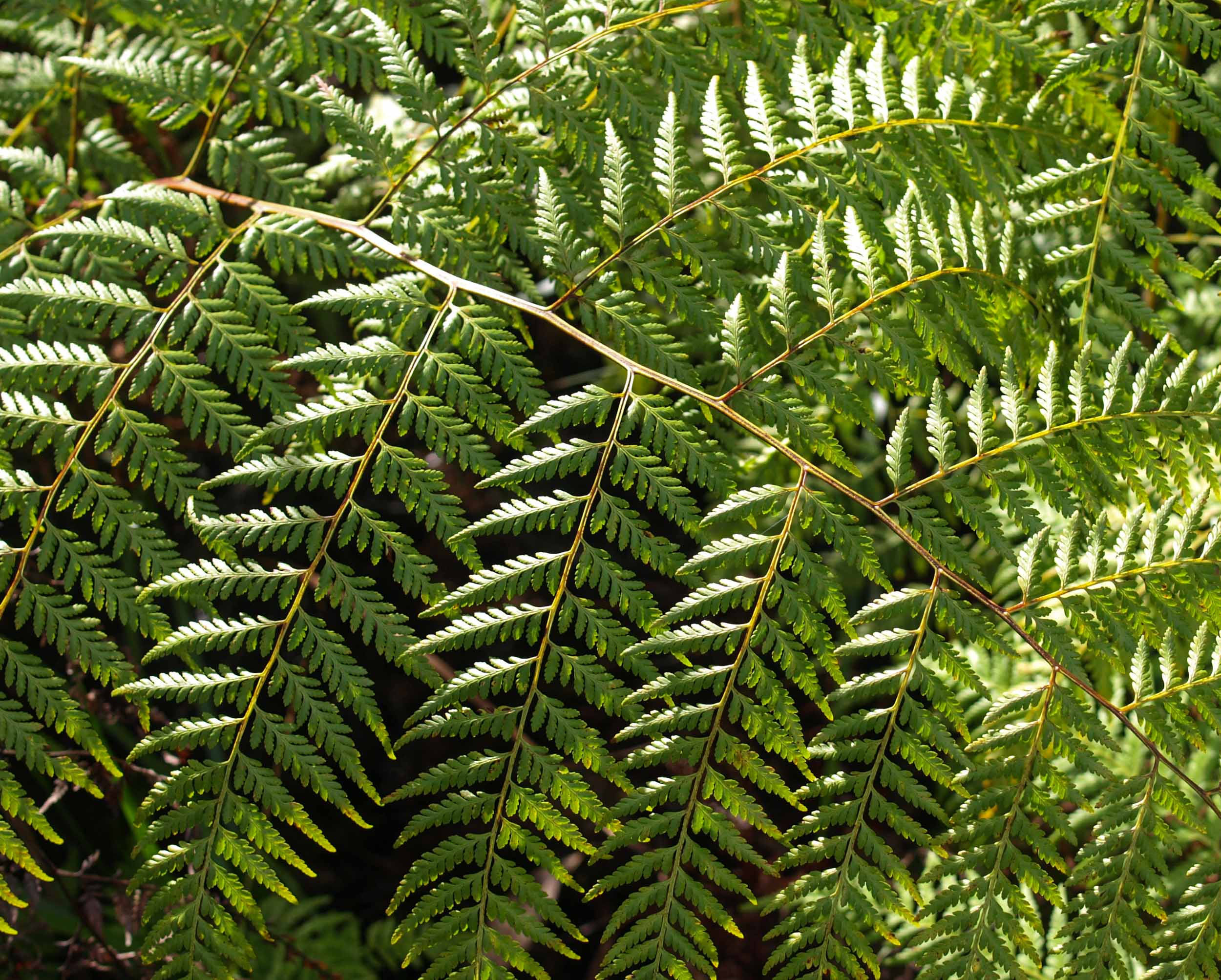
Rainbow Fern
Calochlaena dubia
We have large, almost pure thickets of this attractive fern in a number of areas on the block. The fronds can be up to 1.5m tall. It is in the same family as the tree fern Dickinsonia antarctica and is not at all closely related to the Austral Bracken Pteridium esculentum, with which it is often confused. This is one of 8 fern species on the block.
Family: Dicksoniaciae
Photo taken in May
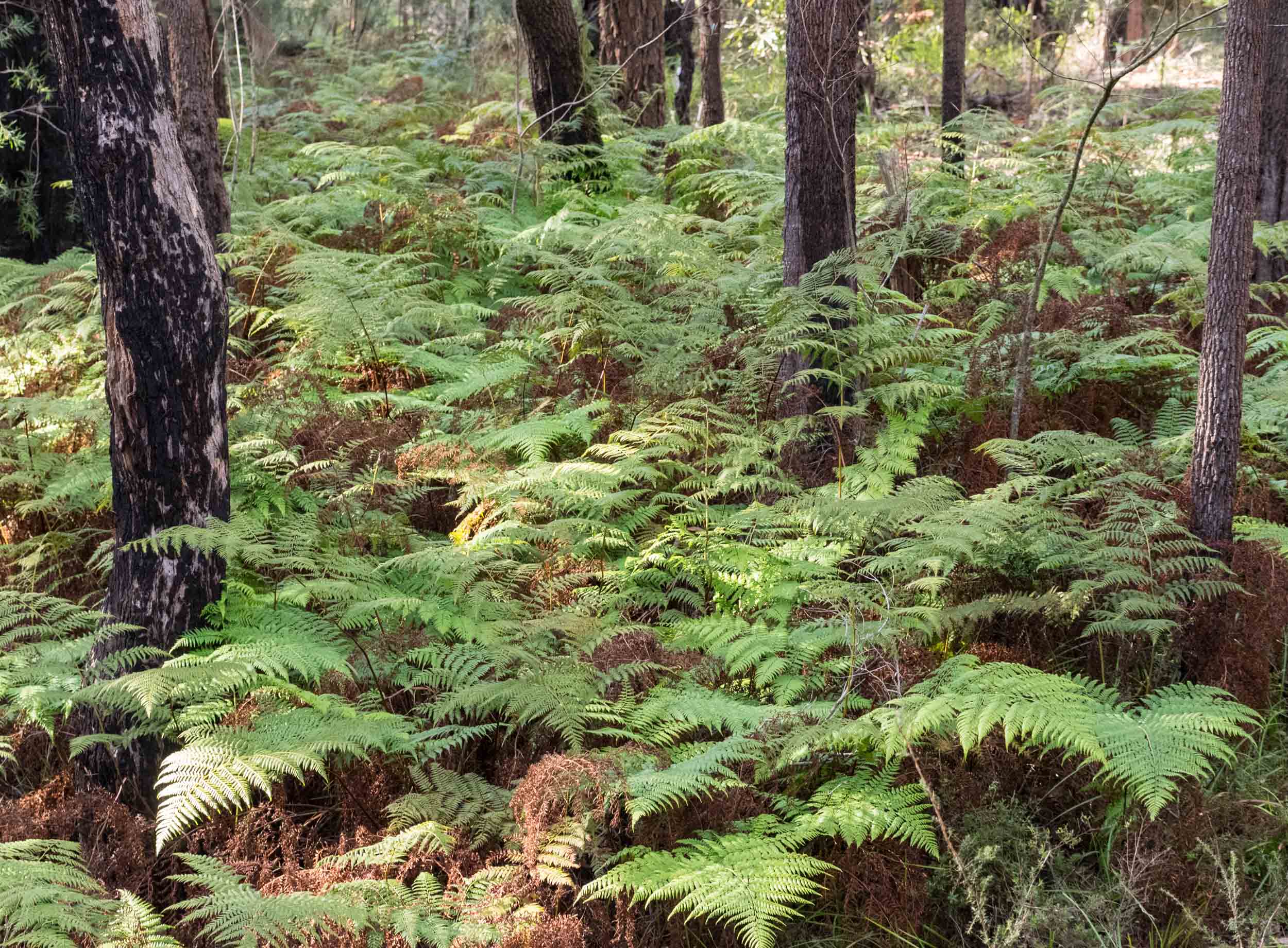
Rainbow Fern
Calochlaena dubia
A typical thicket of Rainbow Fern. The plants spread sideways by rhizome growth. These thickets provide ideal habitat for a number of the smaller birds, including the Brown Thornbill, Superb Fairy Wren, White-browed Scrubwren and Eastern Whipbird. They take refuge, feed and nest in these densely vegetated areas.
Family: Dicksoniaciae
Photo taken in July

Pale Grass-lily
Caesia parviflora
Another low shrub on the block, which flowers from October to April.
Family: Anthericaceae
Photo taken in January
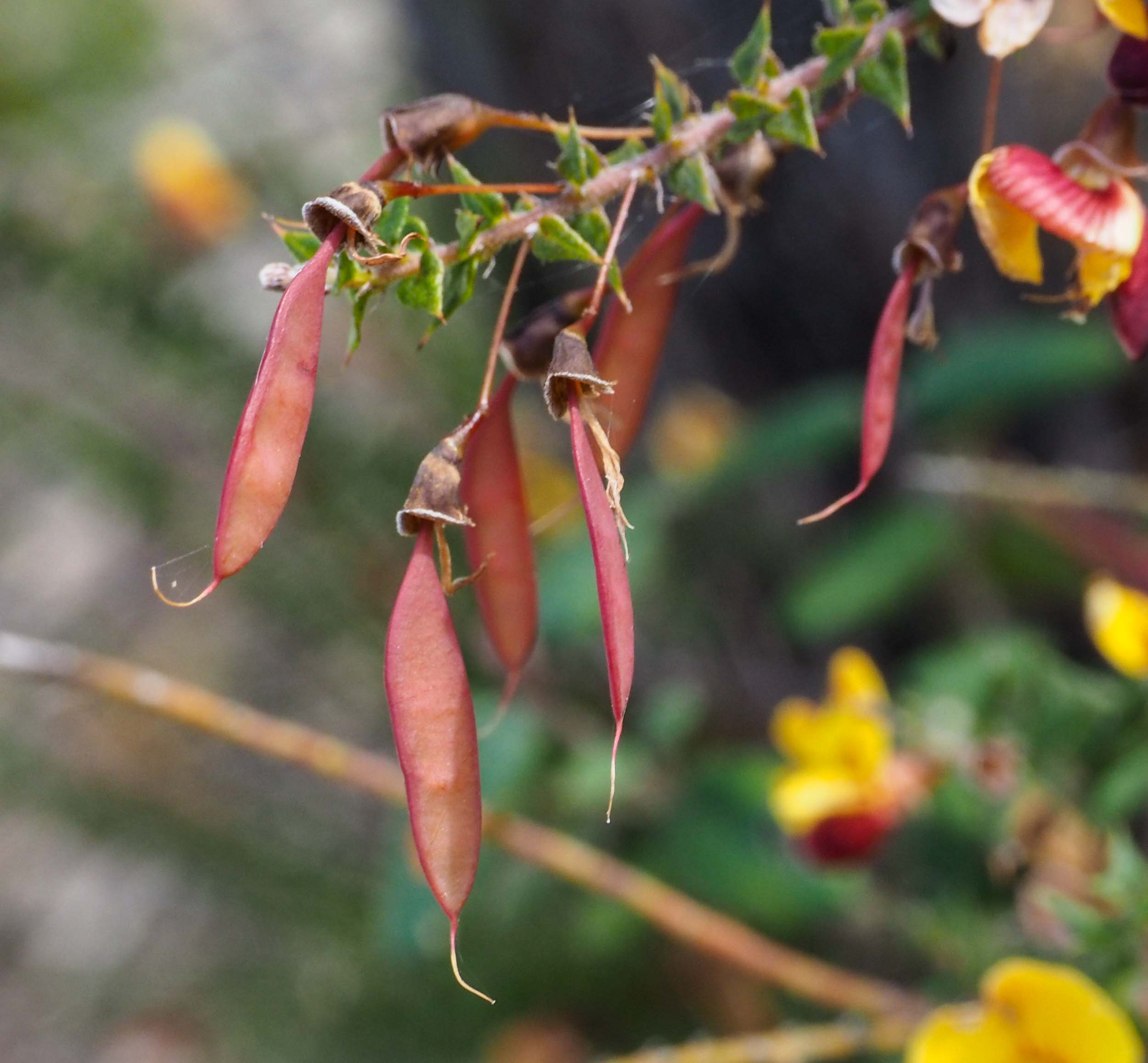
Bossiaea
Bossiaea cordifolia
The fruit of this Bossiaea shows that this genus belongs to the family Fabaceae - legumes. This is one of the most common plants on the block. Butterflies such as Candalides hyacinthina take nectar from its flowers. It has very spiky leaves.
Family: Fabaceae Subfamily: Faboideae (legumes)
Photo taken in October
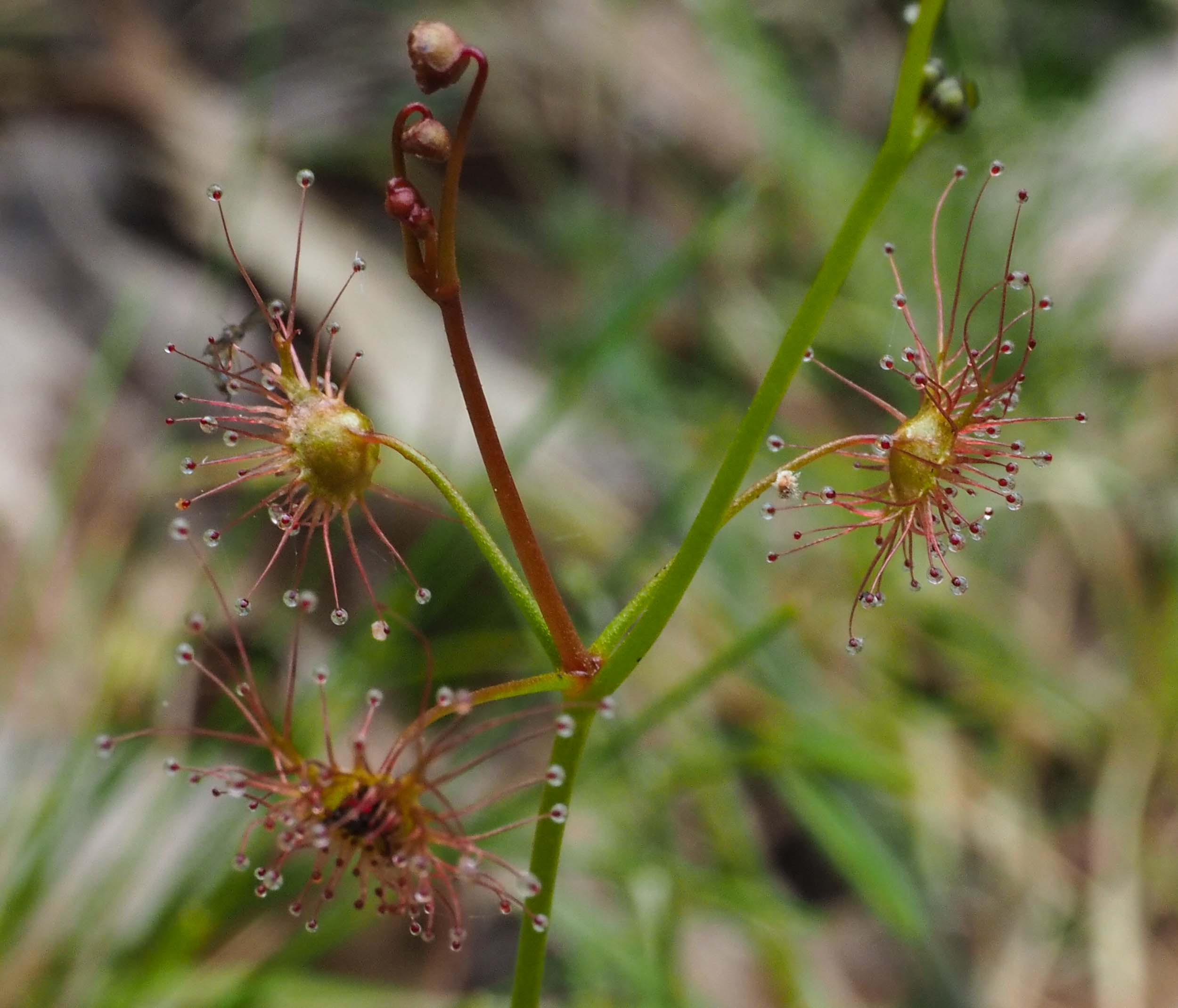
Tall Sundew
Drosera auriculata
This is a small herb with a distinctive character - it is carnivorous. The leaves of this plant are highly modified. They are covered in hairs which secrete a mucilaginous substance that traps insects and enzymes that digest the prey. Drops of these glandular secretions can be seen at the tips of the red hairs in this image. Carnivorous plants are often found in sandy soils with low nutrient levels, as occur on our block. Carnivory supplements their nutrition.
Family: Droseraceae (sundews)
Photo taken in September

Red shaggy-cap bolete
Boletellus emodensis
A large and distinctive mushroom that grows among the grasses and leaf litter. Fungi identification can be difficult. It is acknowledged that there are a huge number of undescribed species in Australia. In addition, the appearance of any given mushroom varies considerably as it ages. We are reasonably confident of this one, though.
Family: Boletaceae
Photo taken in April
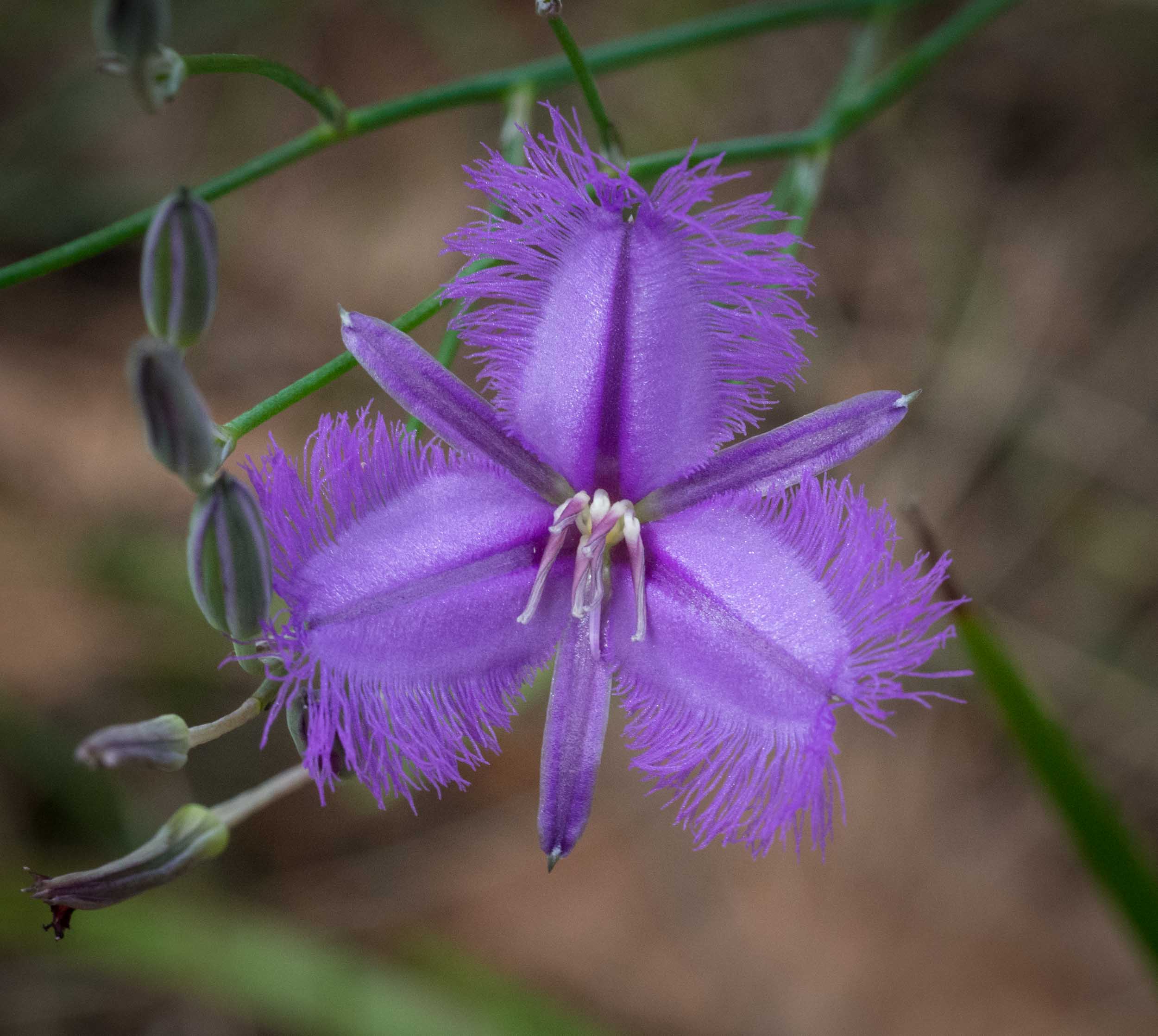
Fringe Lily
Thysanotus juncifolius
This low growing forb starts flowering in late October and right through to February we are treated with a spectacular display of purple blooms. It belongs to the same family as Lomandra, which one would not readily guess from its habit.
Family: Asparagaceae Subfamily: Lomandroideae
Photo taken in November
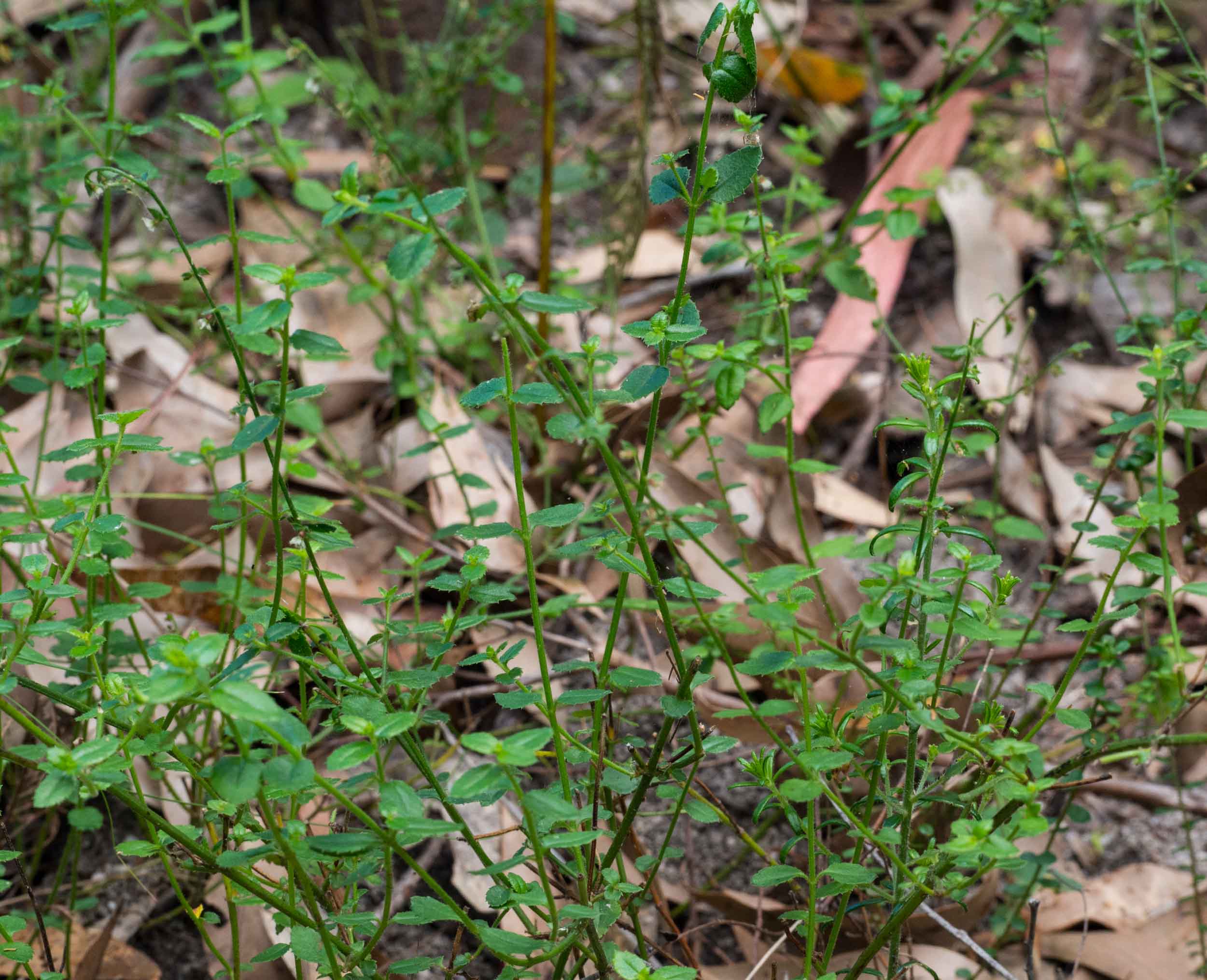
Raspwort
Gonocarpus teucrioides
A small, inconspicuous herb with similarly small, inconspicuous flowers. However, this is one of the most widespread plants on the block and is a diagnostic species for our type of forest - Lowland Gully Shrub Forest.
Family: Haloragaceae (watermilfoil family)
Photo taken in December

Raspwort
Gonocarpus teucrioides
The small flowers of this low growing, but widespread forb. The styles branch profusely to give a feathery appearance to the flower.
Family: Haloragaceae (watermilfoil family)
Photo taken in December

Raspwort
Gonocarpus teucrioides
While Gonocarpus may not have the flashiest flowers, it is a plant much loved by Eutrichopidia latinus, the Owlet Moth. This image shows this moth ovipositing on the plant, which is a key food plant for its larvae. The anthropocentric view of the world is so limited!
Family: Haloragaceae (watermilfoil family)
Photo taken in February

Grass Tree
Xanthorrhoea resinosa
Large areas of the block, particularly the higher parts, are covered with this species of grass tree. Unlike many other Xanthorrhoea species, X. resinosa does not have a trunk. The trees in the foreground of this image are Banksia serrata.
Family: Xanthorrhoeaceae Subfamily: Xanthorrhoeioideae (grass trees)
Photo taken in December
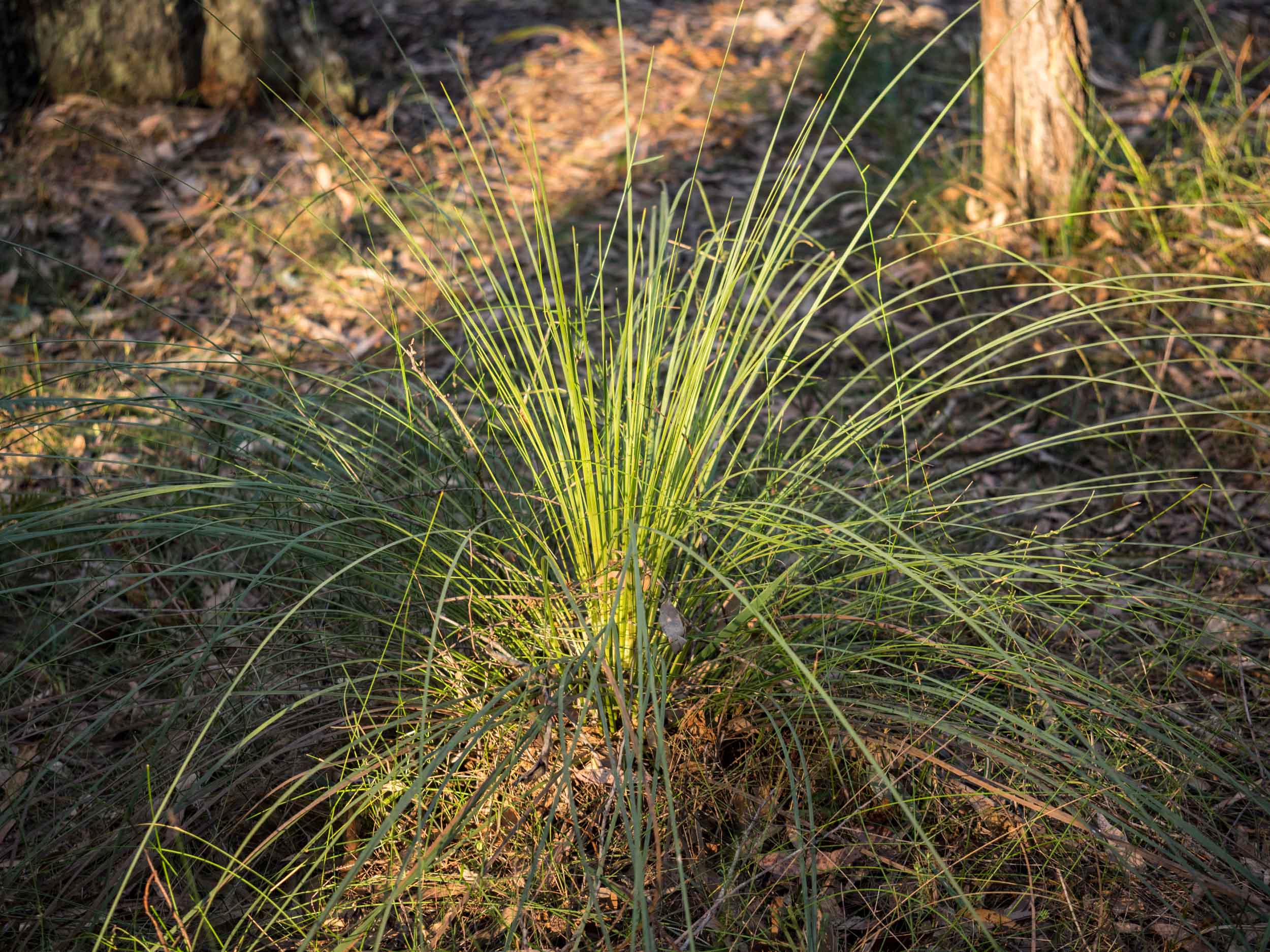
Grass Tree
Xanthorrhoea resinosa
A single, young Xanthorrhoea plant.
Family: Xanthorrhoeaceae Subfamily: Xanthorrhoeioideae (grass trees)
Photo taken in July
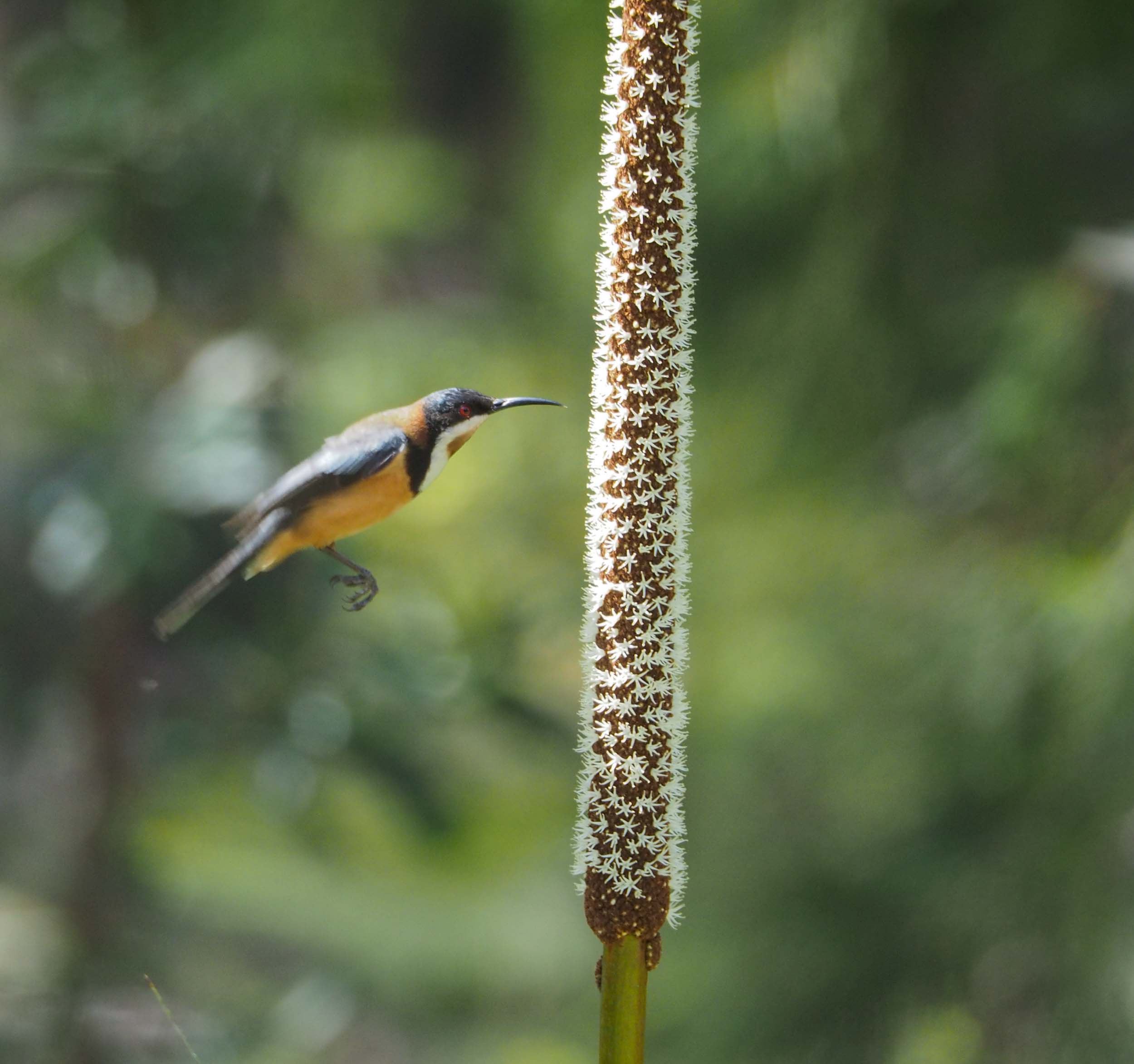
Grass Tree
Xanthorrhoea resinosa
In October a single tall, woody flowering stem grows up from the centre of the plant and hundreds of tiny white flowers develop on this scape in a spiral arrangement. In any given year, only a small percentage of plants flower. Butterflies, hoverflies and several species of honeyeaters visit the scape, which flowers for some weeks, to feed on the nectar. The image shows an Eastern Spinebill hovering in a stationary position just before it extracts nectar with its long tongue.
Family: Xanthorrhoeaceae Subfamily: Xanthorrhoeioideae (grass trees)
Photo taken in December
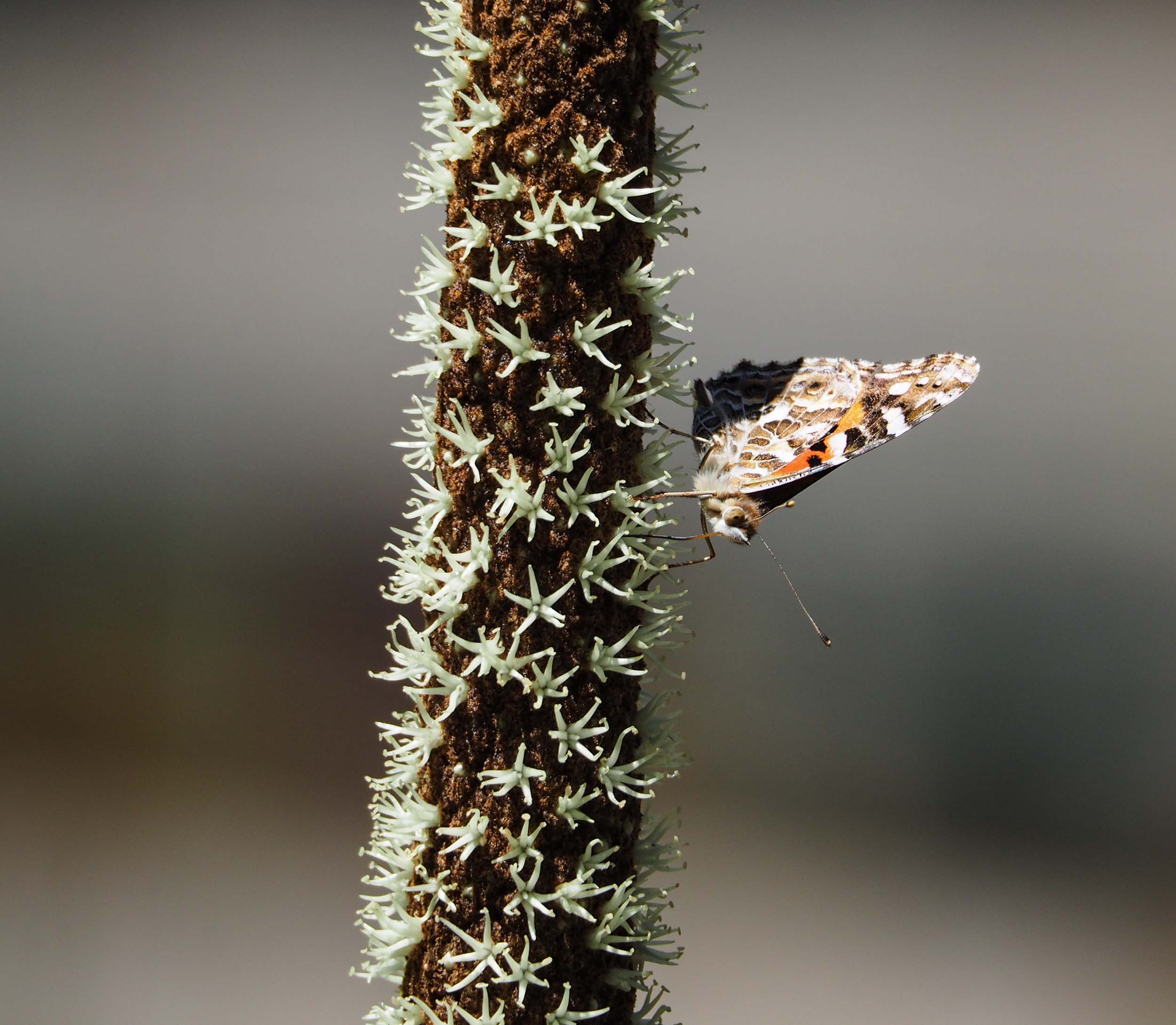
Grass Tree
Xanthorrhoea resinosa
A closer look at the flowers on a X. resinosa scape - here visited by Vanessa kershawi (Australian Painted Lady). Eventually the entire length of the scape becomes packed with flowers.
Family: Xanthorrhoeaceae Subfamily: Xanthorrhoeioideae (grass trees)
Photo taken in December
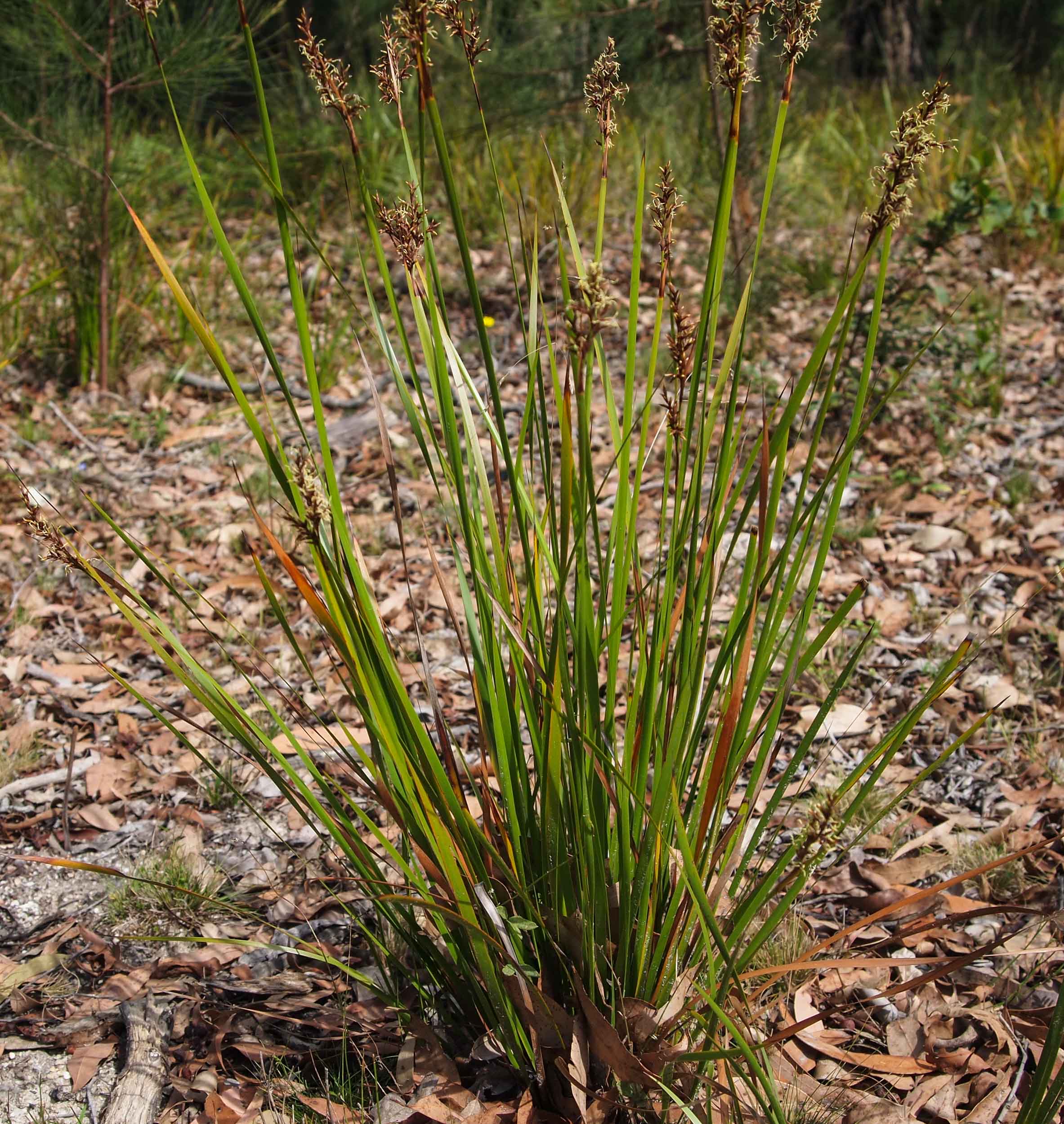
Coast Sword Sedge
Lepidosperma latens
This is the dominant plant species in the undergrowth across the block. It grows in clumps, which spread sideways by rhizomes. It looks like a grass, but it's not - they come later. It's a sedge. Sedges grow well in poor soils, as found on the block. The leaf margins on this species have a sharp, cutting edge - hence the common name.
Family: Cyperaceae (sedges)
Photo taken in February

Coast Sword Sedge
Lepidosperma latens
This sedge flowers from December to April. The yellow and white tufts protruding from the brown flower spikelets are the anthers and styles, respectively. The fruit that develops from these flowers is a dark brown nut - probably good tucker for some critter.
Family: Cyperaceae (sedges)
Photo taken in February
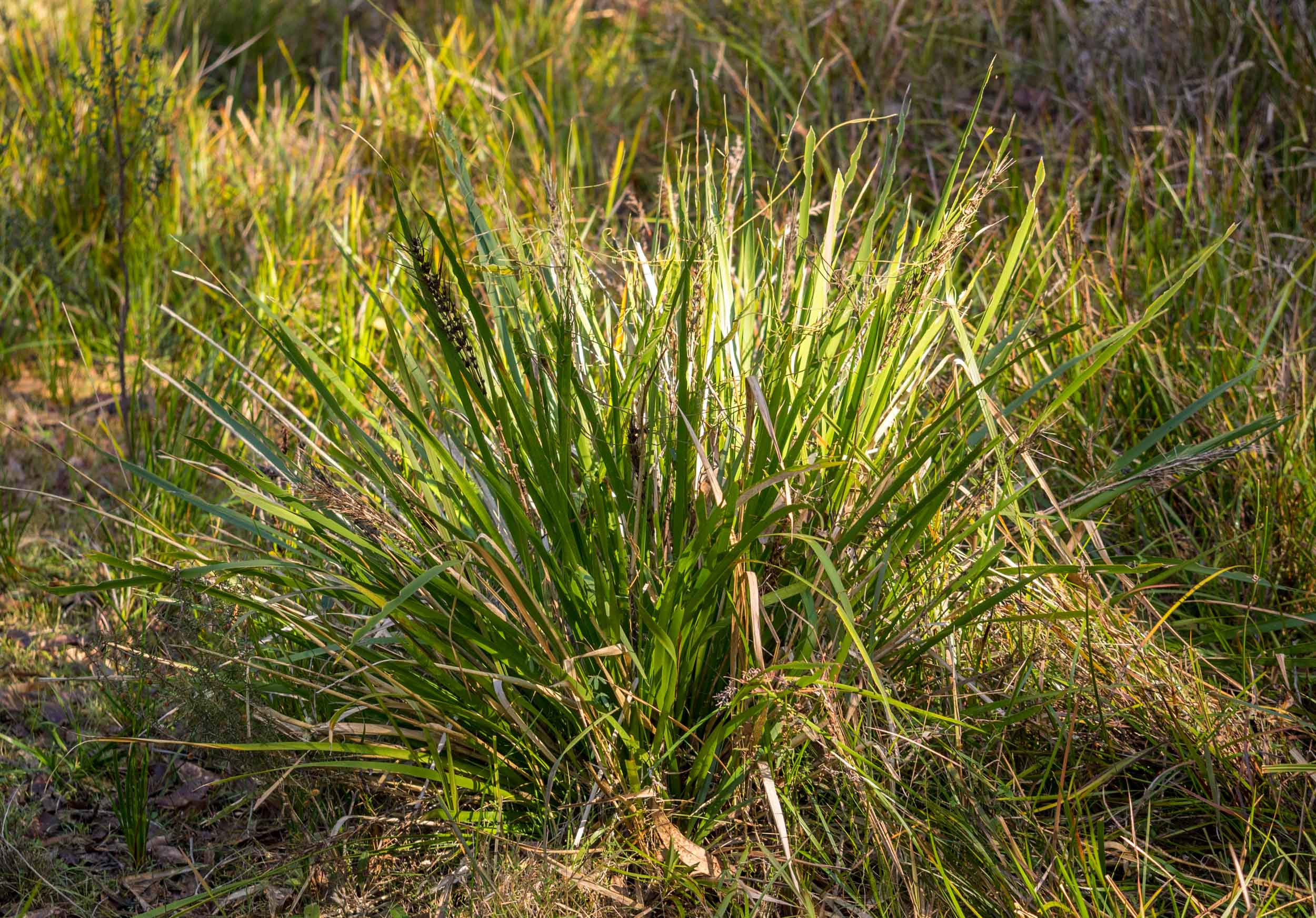
Spiny-headed Mat-rush
Lomandra longifolia
While it also superficially resembles a grass (Poaceae), Lomandra actually belongs to a different family - Asparagaceae. Five different species occur on the block. L. longifolia has the longest (up to 100cm) and widest (up to 2.5cm) leaves of those and is a popular cultivated garden plant. All five species are key food plants for a variety of butterfly larvae. L. longifolia is the host plant for the Splendid Ochre butterfly (Trapezites symmomus) - one of our home species.
L. longifolia is one of the diagnostic species for our type of forest - Lowland Gully Shrub Forest.
Family: Asparagaceae Subfamily: Lomandroideae
Photo taken in July
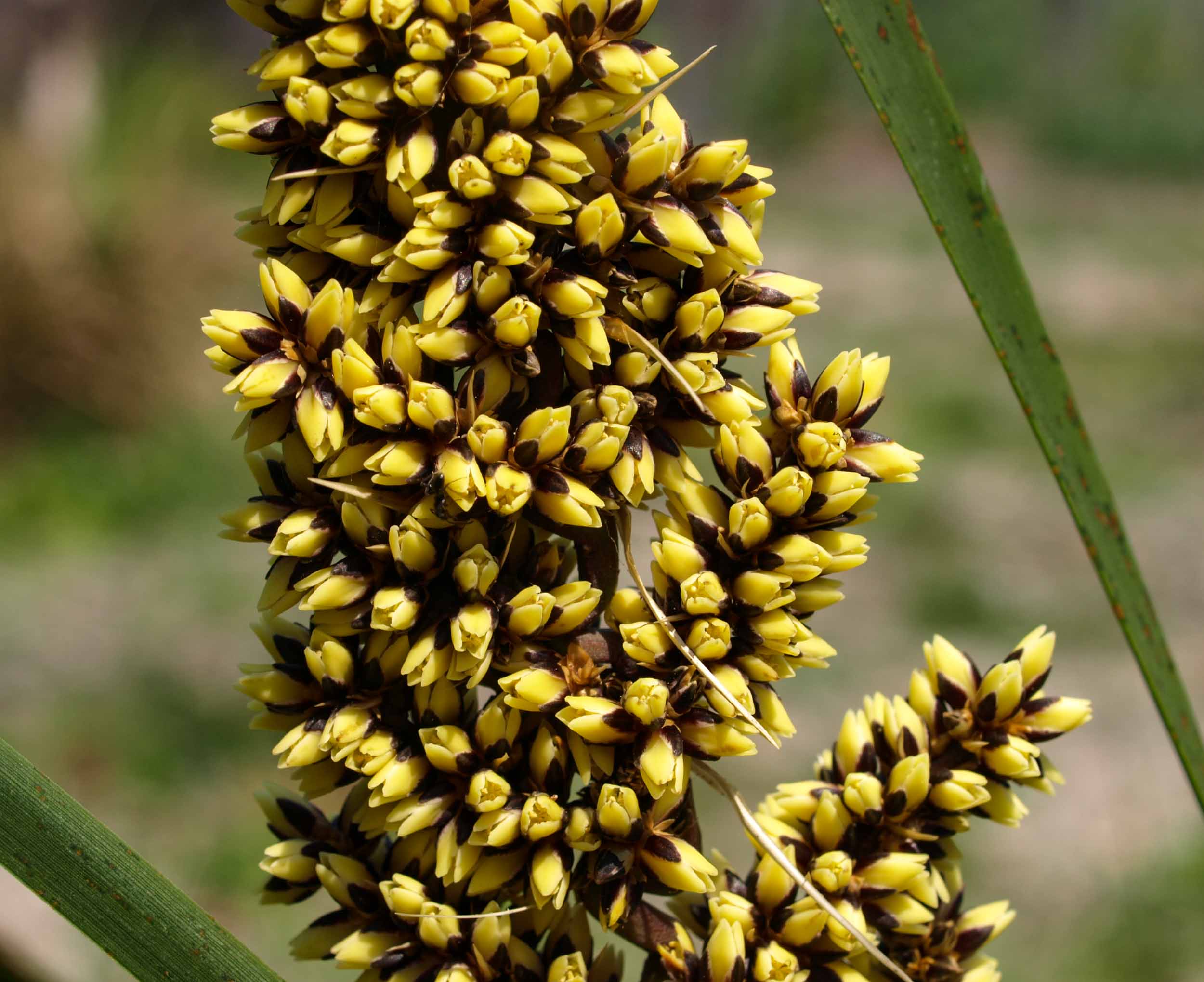
Spiny-headed Mat-rush
Lomandra longifolia
This image shows the spectacular male inflorescence. Female flowers are found on a separate plant.
Family: Asparagaceae Subfamily: Lomandroideae
Photo taken in October
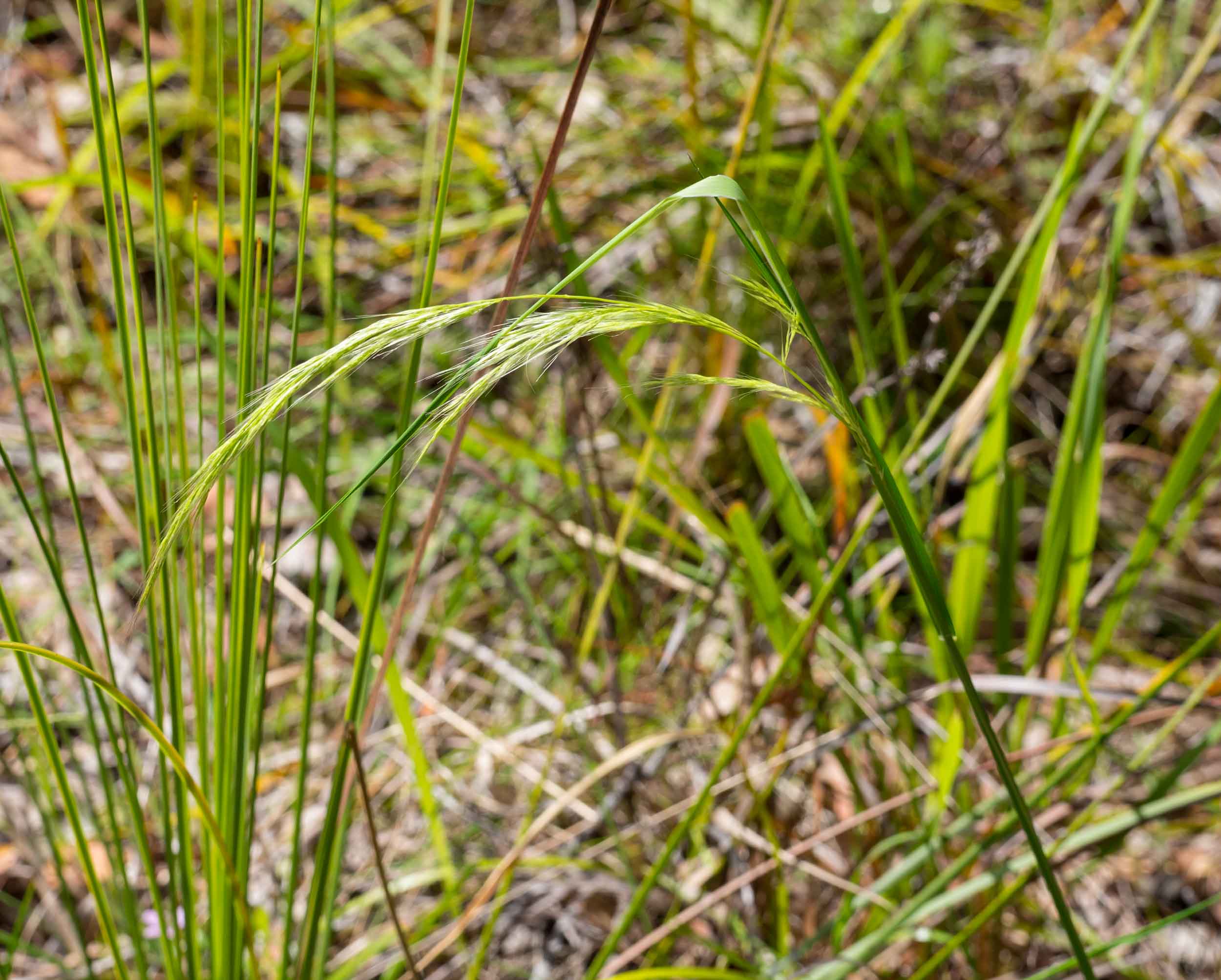
Stout Bamboo Grass
Austrostipa ramosissima
This is one of 18 species of native grasses - belonging to the family Poaceae (true grasses) - on the block. Some, like this one, prefer open areas but several species are found in shaded sites in the forest. The stem or culm, which bears the flowering head or inflorescence appears in November. This image shows a young inflorescence, which is just beginning to open, on the long culm typical of this species. The culm in A. ramosissima bears a number of long leaves.
Family: Poaceae (true grasses)
Photo taken in November
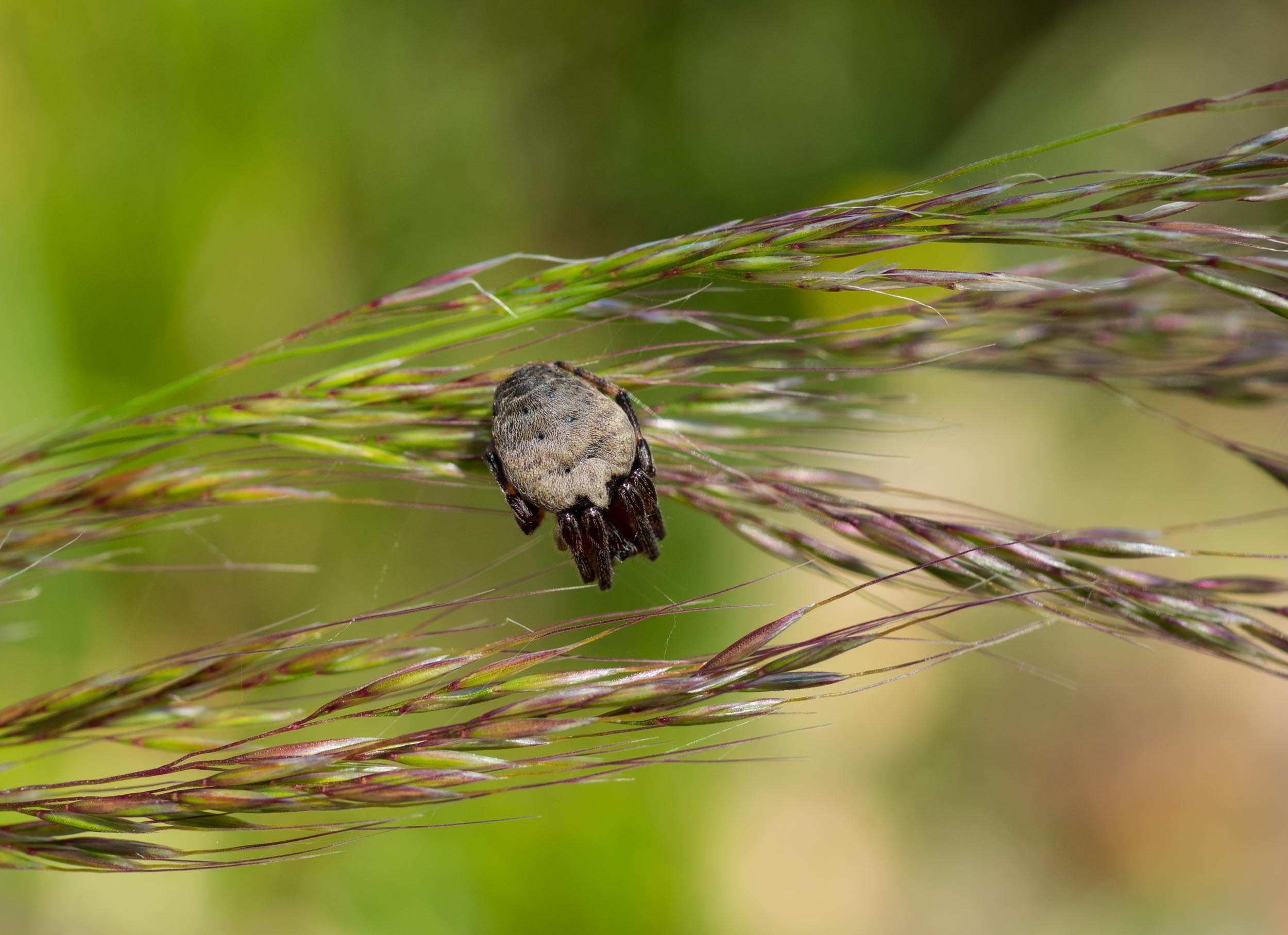
Stout Bamboo Grass
Austrostipa ramosissima
A close up of the inflorescence of this grass at a later stage of maturation. A small orb-weaver spider (Araneus sp.) has set up home here.
Warning! Serious botany ahead! Grass flowers have become highly modified in the course of evolution. Petals and sepals have turned into a variety of structures unique to grasses - glumes, lodicules, palea, lemma and awn. However, the reproductive bits of the flower, the stamens and pistils, are still present and correct - albeit hidden from view at the stage of development shown in this image. Each of the purple/green elongated oval objects in this image is called a spikelet. In this species it contains an individual flower or floret. The long thin extension at the tip of the spikelet is an awn - this is the bit that gets stuck in your socks or the fur of another passing mammal. One diagnostic feature of this grass species is the long length of the awn.
Family: Poaceae (true grasses)
Photo taken in December

Fine-leaved Snow Grass
Poa meionectes
This is a low growing tussock grass with narrow leaf blades which are tightly inrolled. It is a favourite food of the Eastern Grey Kangaroo - the leaf blades never get very long! It is the most common tussock grass on the block. Several culms are present on this plant and most of the inflorescences have shed their seed. It flowers from November to January.
Family: Poaceae (true grasses)
Photo taken in November
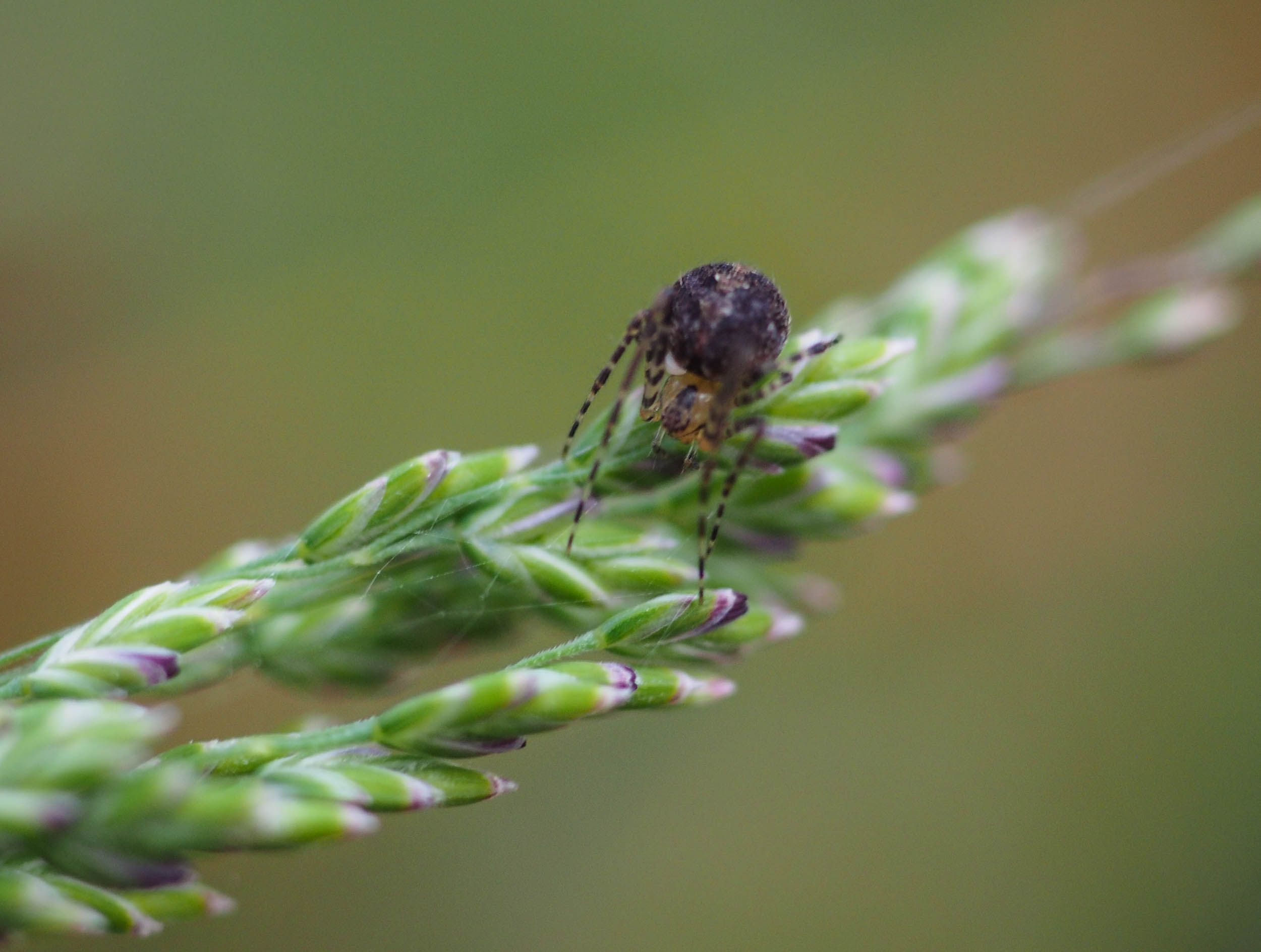
Fine-leaved Snow Grass
Poa meionectes
The spikelets in this grass have characteristic purple tips and they lack an awn. Each spikelet contains 3-5 florets, which have not yet opened in this image. An Orb-Weaver spider (Araneus sp.) has set up shop on the inflorescence. It can be difficult getting a photo of a flowering grass without including a spider or insect in it. This highlights the important role played by grasses in the forest ecosystem.
Family: Poaceae (true grasses)
Photo taken in early December
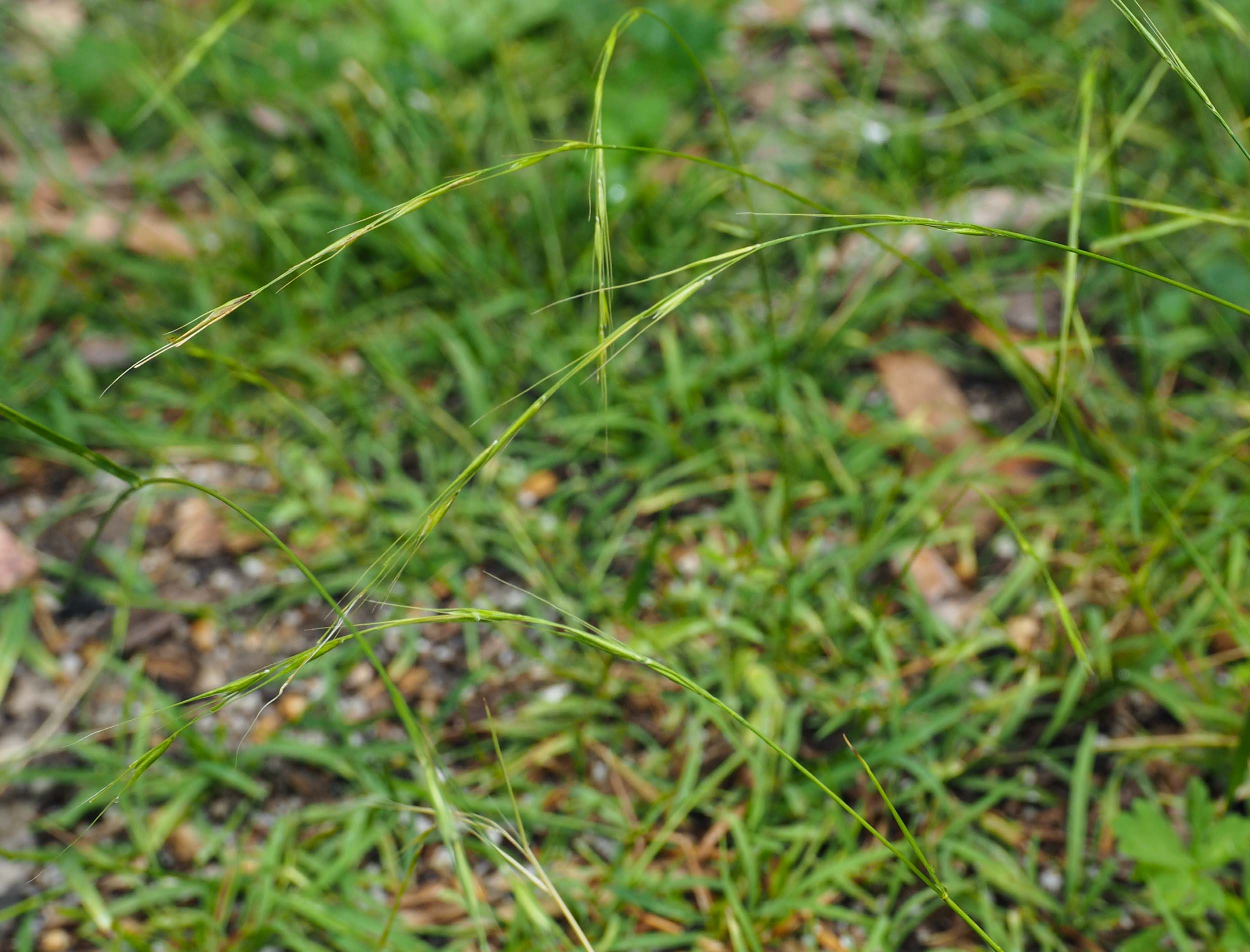
Weeping Grass
Microlaena stipoides
This is the dominant grass in open areas on the block - particularly around the house site and in areas of water run-off. In those locations it forms a continuous mat - seen out of focus in the background. It's the closest we have to a lawn. It is a favourite food plant for the Eastern Grey Kangaroo and the Red-necked Wallaby. So we don't need a lawnmower! Unlike most of our other grasses, Microlaena flowers throughout the year, as long as there has been sufficient recent rain. This image shows the characteristic "weeping" flowering culms, from which the plant gets its common name.
Family: Poaceae (true grasses)
Photo taken in November
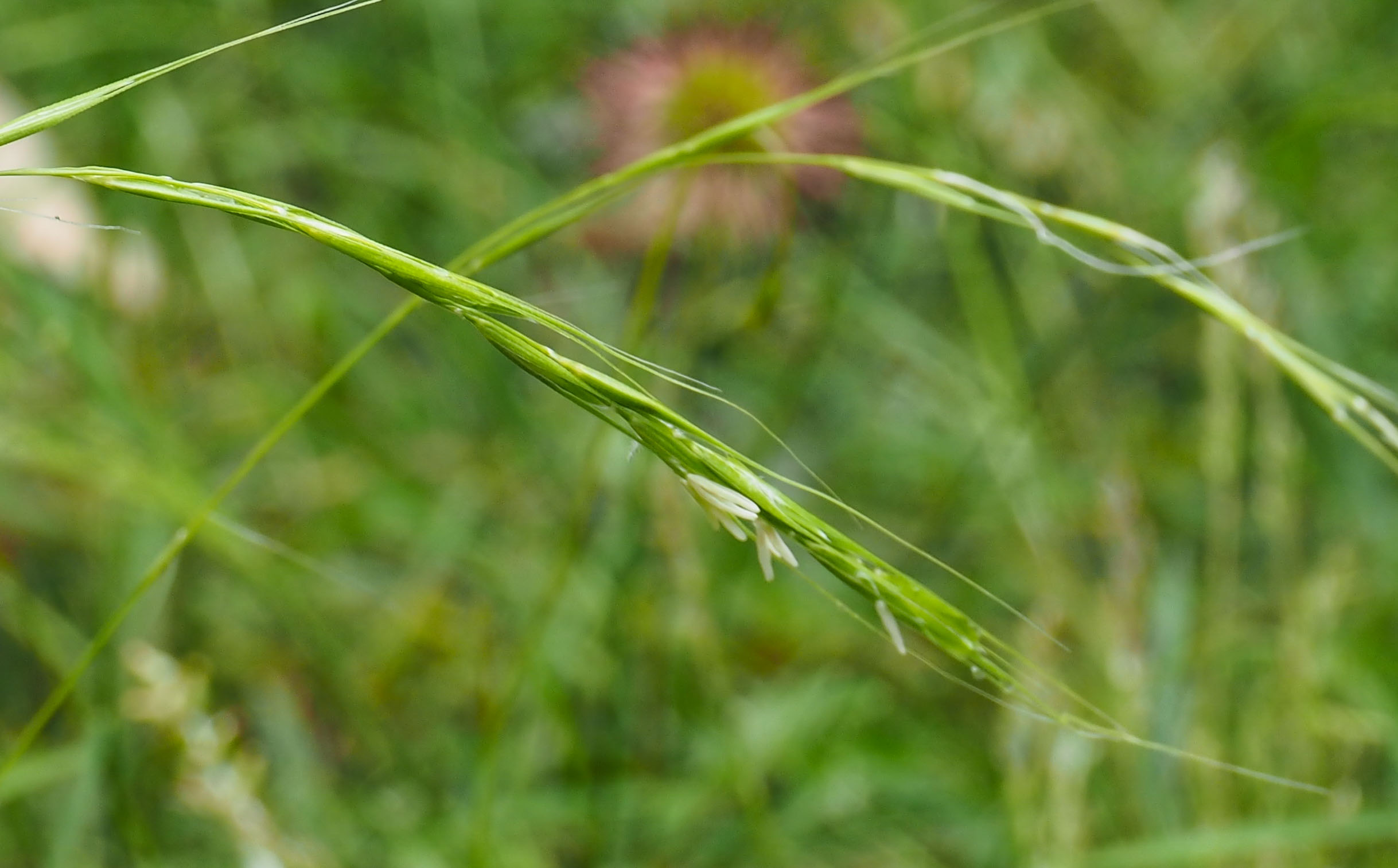
Weeping Grass
Microlaena stipoides
A close up of the inflorescence shows the long awns characteristic of this grass. The spikelets have opened to reveal the white anthers, dangling in the breeze. Grasses are wind rather than insect- or bird-pollinated. This explains why they don't have colourful flowers and why the inflorescences generally have an open, extended form.
Family: Poaceae (true grasses)
Photo taken in November
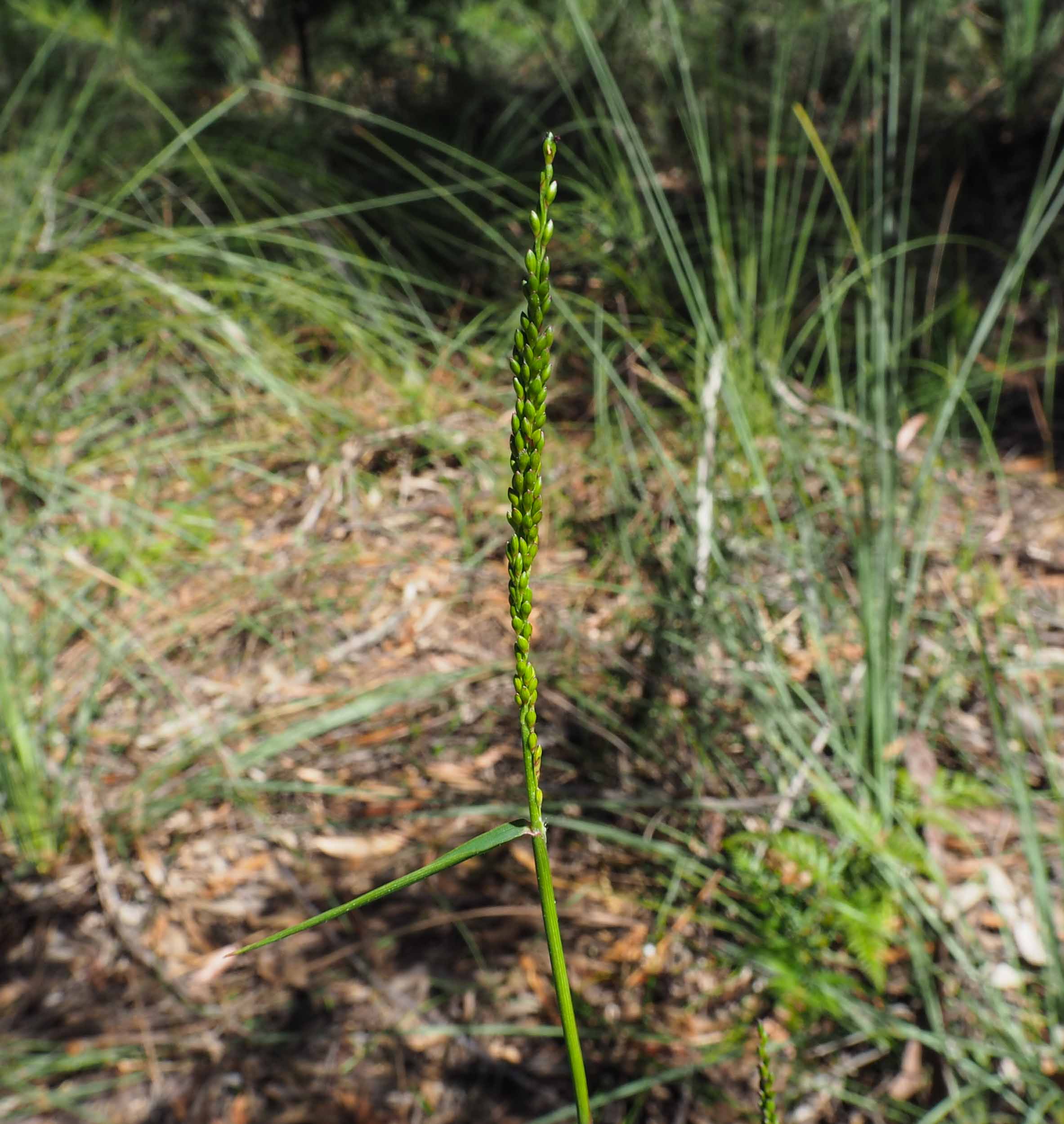
Wiry Panic
Entolasia stricta
This grass has quite a different flowering habit to many of our other natives. A long straight culm develops in late November and bears a large number of closely packed awnless spikelets, each with two florets, only one of which is fertile. It favours the same open, well-drained sites as Xanthorrhoae resinosa.
Family: Poaceae (true grasses)
Photo taken in early December
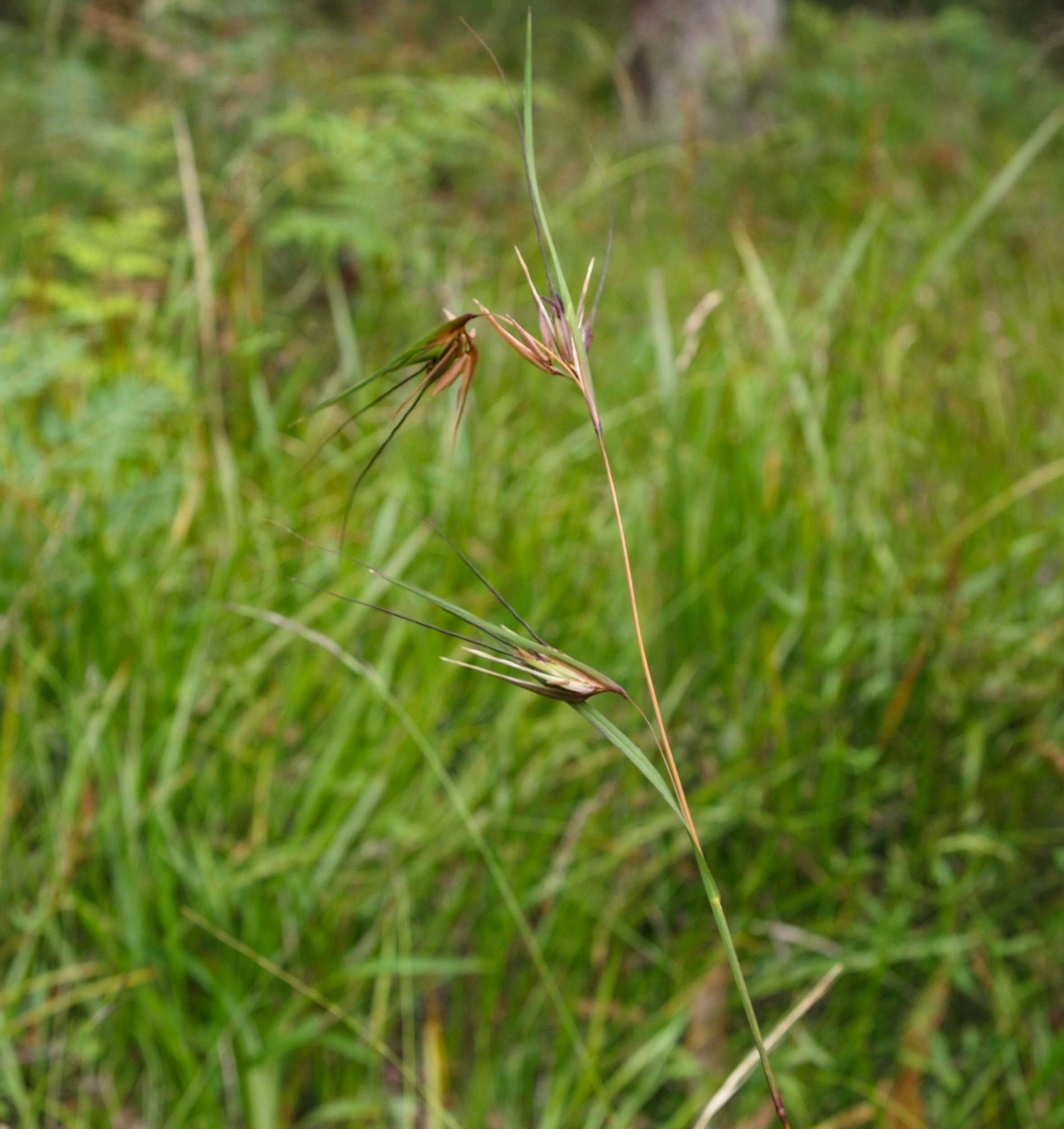
Kangaroo Grass
Themeda triandra
This is without doubt the most spectacular grass on the block. Not surprisingly, it is a popular cultivated plant in home gardens. We value its aesthetic beauty but just as importantly its place in the forest ecosystem - it is the food plant for the larvae of a number of our home butterflies, including Heteronympha merope (Common Brown) and Geitoneura klugii (Klug's Xenica).
Family: Poaceae (true grasses)
Photo taken in November
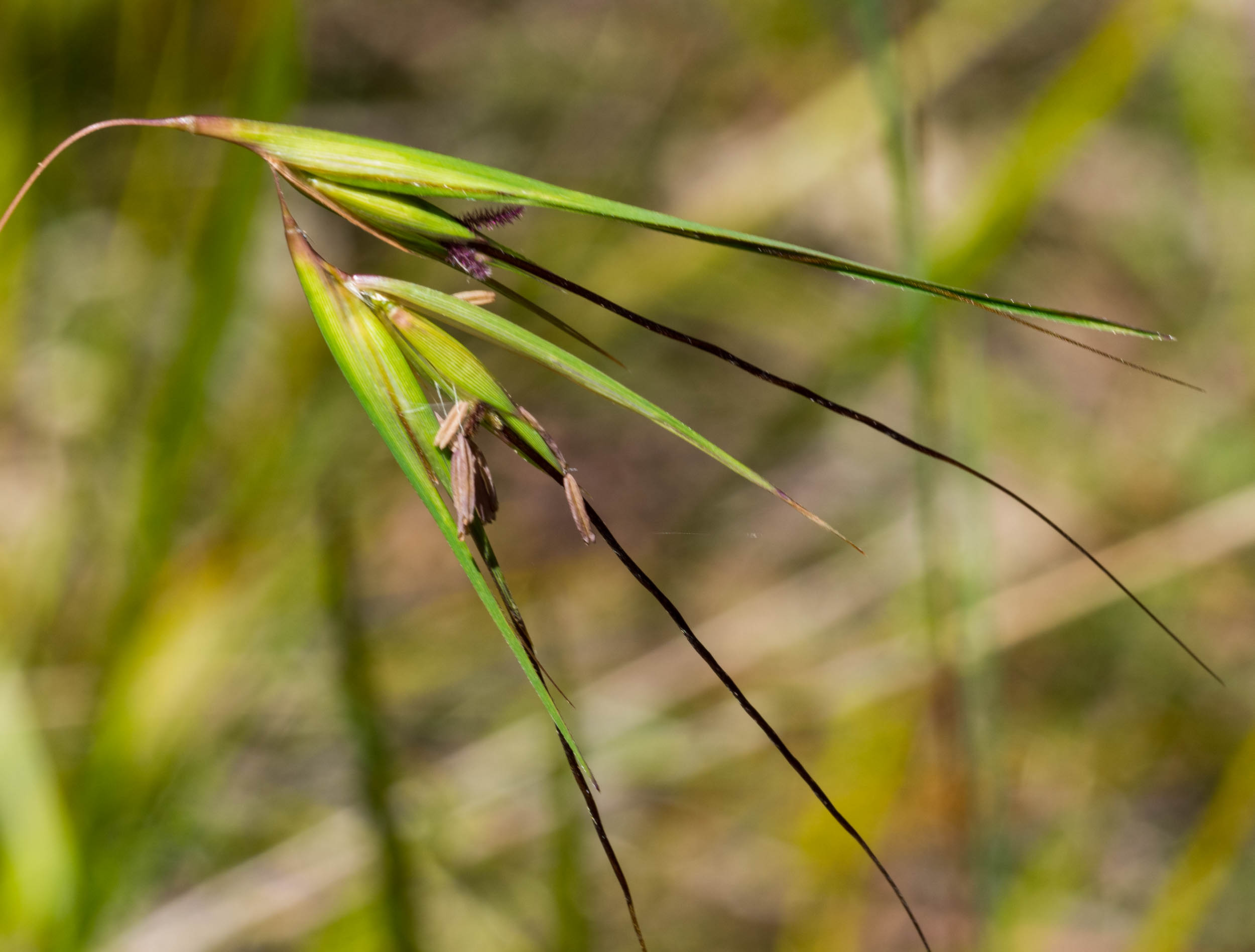
Kangaroo Grass
Themeda triandra
This close up gives a better idea of the complexity of the Themeda inflorescence. Anthers can be seen drooping from the spikelets below, while purple styles are evident in those above. Each spikelet contains 4 sterile florets and one bisexual floret. Themeda has long awns!
Family: Poaceae (true grasses)
Photo taken in November
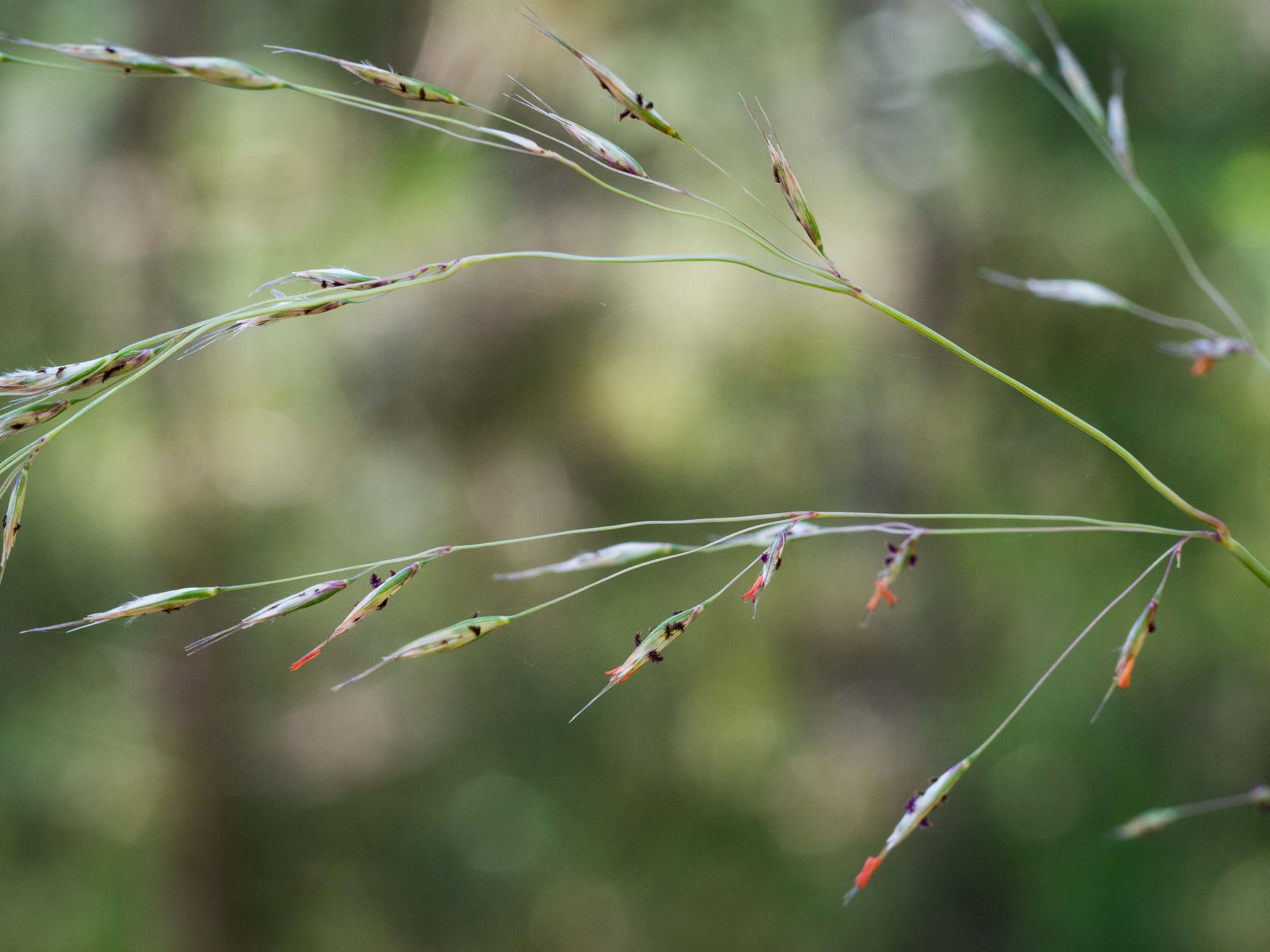
Redanther Wallaby Grass
Rytidosperma pallidum
Another very attractive native grass, which flowers in November. We have only seen a small number of these plants on the block to date and in just one location. This species has an expanded inflorescence - a panicle - which assists wind pollination.
Family: Poaceae
Photo taken in November
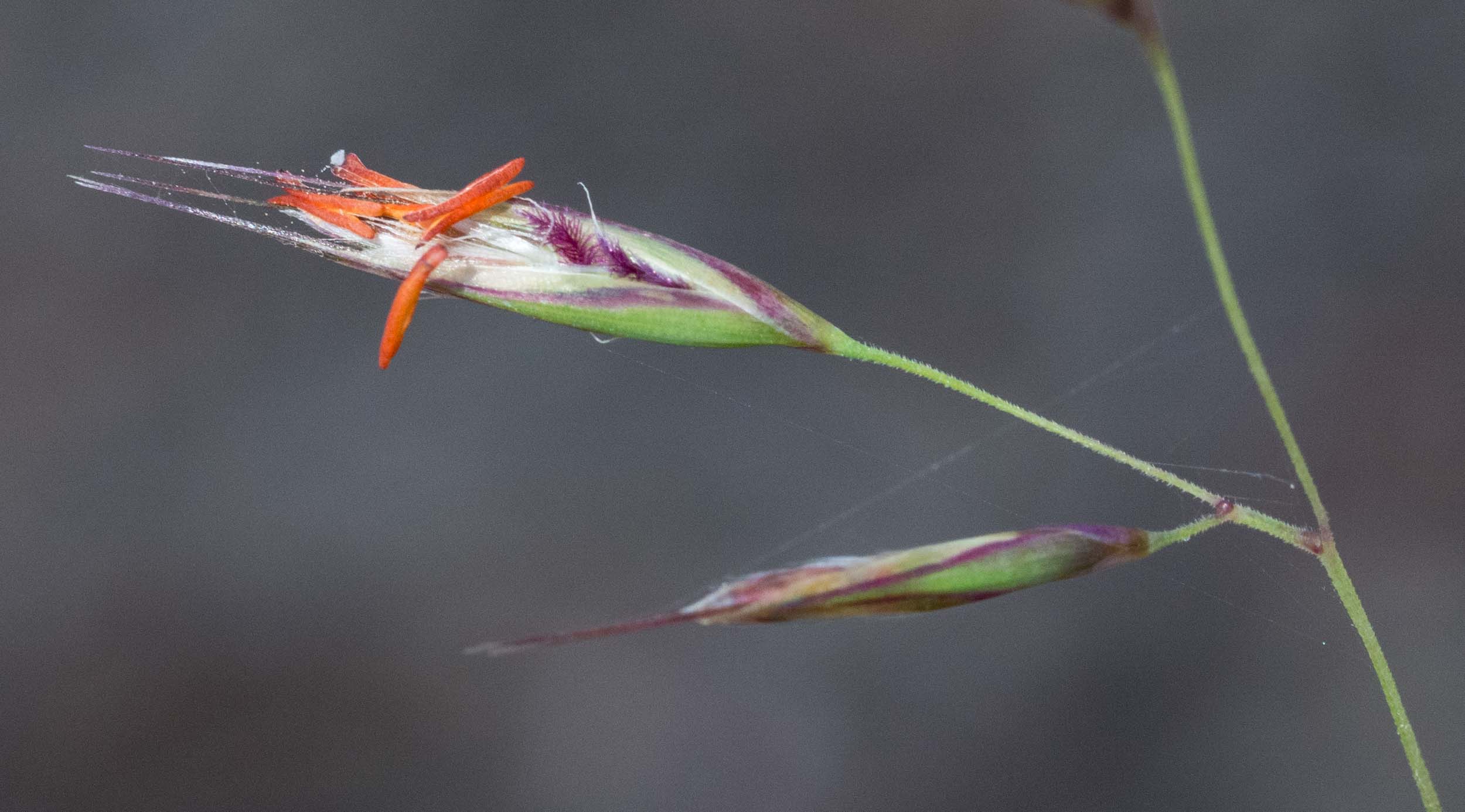
Redanther Wallaby Grass
Rytidosperma pallidum
A close up of an opened spikelet of this species shows its spectacular red anthers. The purple, feathery styles are pretty cool as well! Each spikelet contains 2-6 florets.
Family: Poaceae
Photo taken in November
